


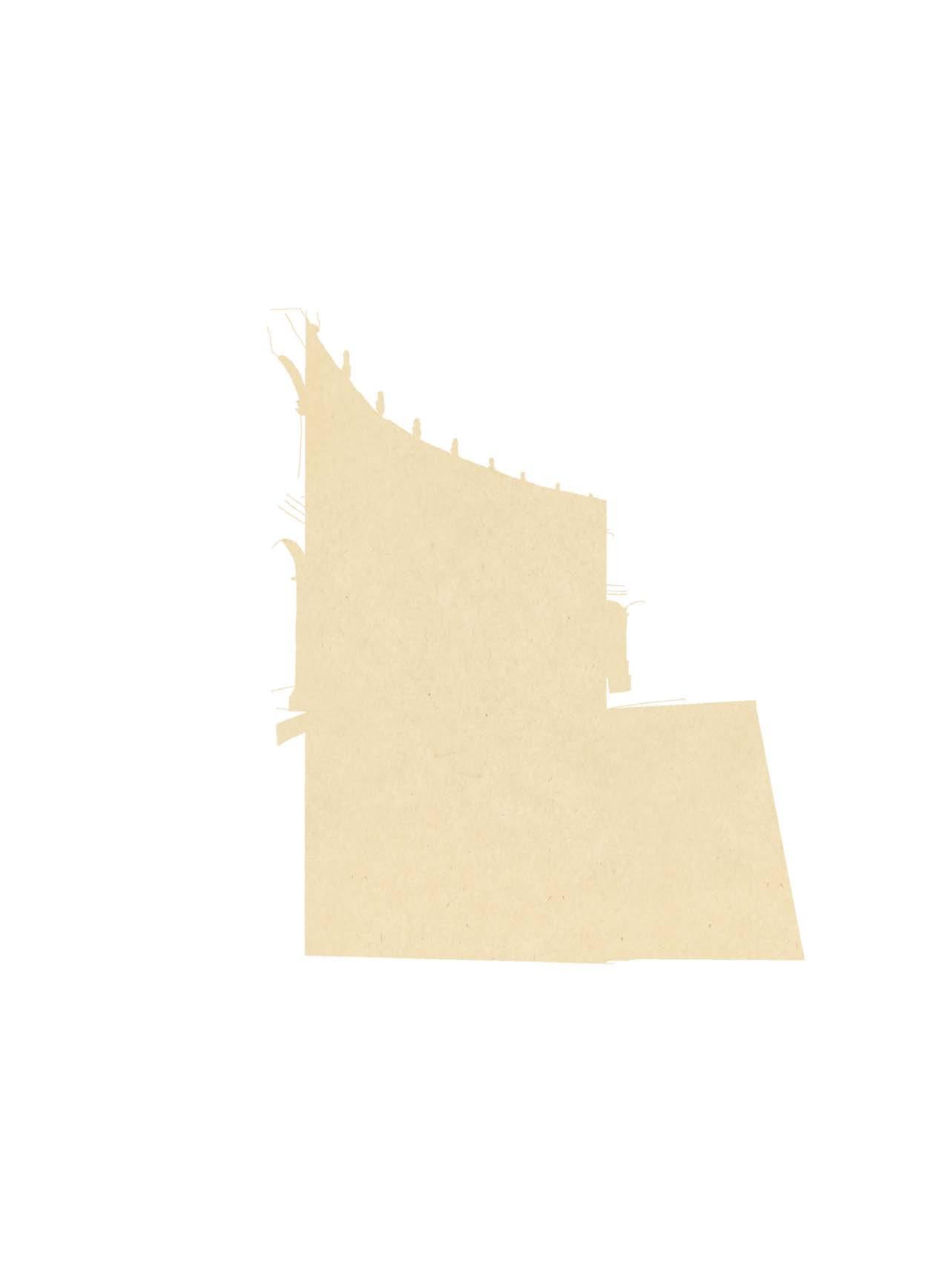



SPAIN SUMMER 7/2017




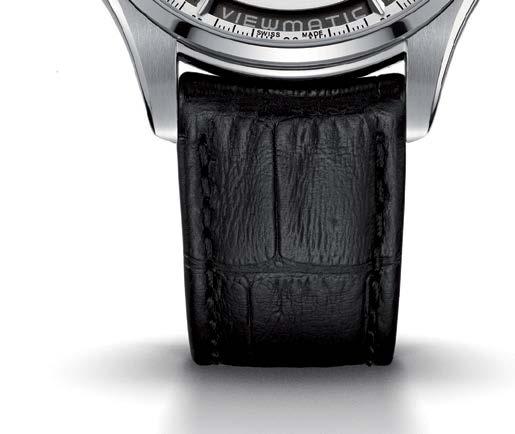












CONTENT MADRID HOTELS / MUSEUMS / RESTAURANTS GASTROBARS / TABLAO / CAFES / BARS SHOPPING BARCELONA HOTELS / MUSEUMS RESTAURANTS / BARS / SHOPPING RULER OF LANDS AND SEAS 50 THE ROYAL FAMILY OF SPAIN 54 WHEN THE WEATHER TURNS BAD 60 DON JUAN 62 THE BILBAO EFFECT 64 TWO DREAMS 68 ALMADOVARLAND 70 EUSKADI - BASQUE COUNTRY AND ITS HEROES 74 SPANISH WINE 76 JAMÓN JAMÓN 82 THE LABORATORY OF THE SENSES 90 THE BASQUE GASTRONOMICAL MIRACLE 94 CORRIDA 102 OBSESSED WITH FLAMENCO 106 ANDALUSIA 108 CITIES GRANADA / SEVILLE CORDOBA / VALENCIA / IBIZA 12 / 30 34 / 47 114 / 127


7, 2017
Editor-in-Chief
Tea Skhirieli
Art - Director
Nino Daraseli
Designer
Nino Kavelashvili
Illustrations by Maia Sumabdze

Translation by Lika Barabadze
Photo - Shutterstock
Authors:
Aka Morchiladze
Bidzina Baratashvili
Nikoloz Chkhaidze
Zaza Chiladze
Marina Kipshidze
Lasha Bughadze
Ciuka Kipshidze
Tea Gvasalia
Sandro Jandieri
Project Manager / SOLO DIRECTOR
Eka Duchidze
Project Consultant
Nino Gegeshidze
SOLO Brand Manager

Keti Nikoleishvili
Publisher: LTD SOLO
Phone.: +995 32 2 44 44 00
ISSN: 2346-8130
Editor Salome Dadunashvili
Administrative Assitant Giorgi Vasadze
Advertisement Manager
Nazi Goshadze
Advertising: +995 599 330 364 / Published material owned by LTD SOLO. Written Consent of the Company necessary for use of any material published in this magazine.
- Travel benefits:
- Special conditions at top class hotels
- Access to over 1,000 airport lounges in more than 120 countries
- Hotel loyalty programs

- Explore new lifestyle with American Express Invites
- Travel Protection and etc.

A wealth of experiences
Platinum is a world where experiences are created specifically with you in mind. American Express
Platinum.
Welcome to
Platinum provides holders with the following services worldwide: - International and local concierge
For the detailed information please contact your SOLO banker or call us at: (0 32) 2 44 41 00 Platinum.
TBILISI SOLO LOUNGE MTASTMINDA 11 Chitadze Str.

TBILISI SOLO LOUNGE PALIASHVILI 23, Paliashvili Str.
TBILISI SOLO LOUNGE ABASHIDZE 70, Abashidze Str.
TBILISI SOLO LOUNGE TSINTSADZE 12, Tsintsadze Str.
TBILISI SOLO LOUNGE Chavchavadze 29, Chavchavadze Ave.
TBILISI SOLO LOUNGE KAZBEGI 24G Kazbegi Ave.
TBILISI SOLO LOUNGE KAZBEGI 25 Kazbegi Ave.
KUTAISI SOLO LOUNGE KUTAISI 5 Q. Tamar Str.
BATUMI SOLO LOUNGE Batumi 22 Rustaveli Ave.
TBILISI SOLO LOUNGE TSERETELI 73 Tsereteli Ave.

TELAVI SOLO LOUNGE Telavi 3 Cholokashvili Str.

www.solo.ge Tel: +995 32 2 44 44 00


Madrid is the place where Voyager by SOLO starts its journey for this edition, venturing into the homeland of people that are full of life, just like the Spanish sun. Madrid, the capital, with its white houses and wide boulevard pathos is simultaneously imperially grandiose and democratically modern.
This is the city where you can relish centuries-old masterpieces at the Prado museum and afterwards cross the street and enjoy dishes prepared by chefs who are more popular than football stars. This is the city where you can endlessly search for the keys to the past.
It feels as if everything is upside down here: you will have to adapt to the Spanish routine. The nightlife is so intense in Madrid that the clock hands move differently than anywhere else.
Don’t forget: the city is empty in August. The best time to travel to Madrid is June and September.
Barcelona is the traditional choice for summer in Spain. It is a true capital of the Mediterranean and an idyllic place; nowhere in the world will you find such a sense of unity between the sea, sky, medieval history, architectural wonders, gastronomical culture and healthy southern hedonism.
Every real gourmand’s road leads to the Basque country in the North, to San Sebastian. You will discover a beautiful city with a seaside and restaurants that have transformed into sensational laboratories.
You will never understand what Spain is unless you’ve travelled to Andalusia. The best time to travel there is the end of March and the beginning of April. That is the time when the flowers blossom and the temperature is already 22-25 degrees. Tourist season continues until June.
Andalusia hosts three tourist centers: Granada and the medieval Islamic architecture of the Alhambra, which is one of a kind; Cordoba with its unique Mosque-palace; and Seville with its unforgettable Alcazar.

Visit Valencia at any time of year. It has 300 sunny days and everything is possible: it is a city to walk, dive in and rest. Go to the fashion week, tennis championship, Formula 1 events or the international music festival, and enjoy the local cuisine.
Travel to Galicia and visit Santiago de Compostela Cathedral – the third most important Christian sanctity after Jerusalem and Rome. It is the end-point of the ancient “Camino de Santiago” old pilgrimage route.
Become a SOLO traveler, follow our recommendations and visit the country of eternal holidays – a country which expanded the world a thousand-fold and created an exciting new chapter in world history.
Tea Skhirieli Editor-in-Chief

EDITOR’S NOTE
10 VOYAGER 7/2017
International Exhibition & Events




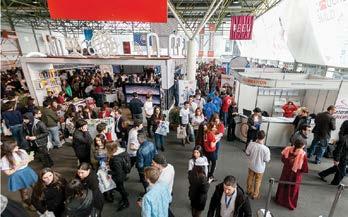

E X HIBITI O N C A L E N DA R 2017 www.educationfair.ge The 7th International Fair for High and Professional Education, Overseas Studies and Students’ Services www tourismexpo.ge CTF’17 – C A UC A SU S T OURIS M F A I R The 19th International Tourism Fair www.buildexpo.ge C AU C A S U S BUI L D 2017 22nd International Exhibition for Building and Interiors www.winexpo.ge WINE X P O G EO RGI A’17 10th International Wines and Spirits Fair www.elcommexpo.ge E LCO M M C AU C A S U S 2017 the 4th International Exhibition for Power and Telecommunications www.aquatherm.ge AQ UAT H E R M TBILI S I 2017 the 4th International Exhibition for HVAC www.thfexpo.ge C AU C ASU S H EA LTH C AR E – International Fair for Medical Technology and Equipment TBILIS I BE AU T Y – International Fair for Aesthetic Medicine TBILIS I D EN TA L S H O W – International Fair for Dentistr y and Dental Equipment www.agroexpo.ge AGR O/F OO D/D RI N K/TE C H E X P O G E ORGI A The 17th International Exhibition for Agro, Food, Drink Products, Pack aging and Processing Equipment TBILI S I B OO K DAYS 2017 D ECE M B E R www.bookexpo.ge 118 A. TSERETELI Ave., TEL: 2 35 11 86, 2 34 11 00
MADRID
Warm sunshine, pink clouds of flower blossoms in your halfclosed eyes, the calming smell of freshly baked bread… In this city, a feeling of happiness for no particular reason surrounds you.
Madrid – doesn’t it sound like the rhythm of castanets? The rhythm that this kind of city breathes. Its rapid heartbeat never stops.

This city is like a deep breath. It is open, pretty and imperially grandiose. And, at the same time, it is unusually non-oppressive, despite centuries of violence. Human souls warm up the grandeur of the white houses and wide boulevards.
This sun has enormous effect! So many things depend on the good will of this heavenly body! When you walk in sun-drenched clothing, everything seems easy. You believe that it will be a
good day. This is how the citizens of Madrid have walked for years, holding the sun’s hand. Their hot partner has always been faithful to them.
The sunshine helped them endure the never-ending Reconquista wars, the cruelty of the Spanish inquisition and the rule of Napoleon’s family. This light is reflected upon the hair of Velasquez’s Infanta and the white breast of the nude Maja. People full of life live in Madrid: beautiful, ugly, tall, short, fat, skinny, rich, poor people – all full of life.
Here you do not experience the loneliness of other big cities. Not only because Madrid’s streets are full of happy people on Friday evenings, and not because the warm air vibrates with guitar chords, but because people answer you with a smile. Here they have a special gift of forgetting their problems and just dancing, laughing, having a good meal and dancing again.
12 VOYAGER 7/2017
SALOME DADUNASHVILI
If you wake up early in the morning and walk the streets of Madrid, you will see its living soul. People washing the streets with soap, maids hurrying with grocery bags, children going to school, business people forming queues for coffee and churros – they are all warm, just like the Spanish sun.
Madrid has two energies. One is concentrated around the Sol square and another, in the most prestigious district of Salamanca. Sol is a kingdom of tourists and the industry based on them, while Salamanca is for rich, successful people who enjoy a calmer way of life. Nothing is better than walking here. Tourists go to Gran Via and Sol, while here you see “real” peaceful life.
You will find people that look like real characters from Almadovar’s films. Everything looks like a film in the light of the sun that reaches through the lacework of leaves. A once-gold-encrusted Buddha peacefully watches the street from an antique shop. Walk into a corner restaurant and you will find yourself in excellent society. Watching beautifully dressed beautiful people is another bonus of this city. They love to dress well in Spain, though children are dressed with special care. Little ones in the sandbox don clothing worthy of a night at the opera.
A very pretty girl dances in one little square of Madrid. She has long limbs and black, curly hair. She dances in the square between the cafés but you could be forgiven for thinking that is dancing on the stage of the royal opera. Her every movement is honorable; the sun is reflected upon her black hair and colors her beautiful shoulders. The dancer closes her eyes and smiles in answer to her friend’s caress.
This girl looks a lot like Madrid.
This district, located between Puerto Rico and Grand Via, including the nearby streets, is the cultural and entertainment center of Madrid. Citizens of Madrid and travelers meet each other most frequently by the symbol of the city - the mother bear sculpture. On December 31 every year, thousands of people gather at this square to listen to how the clock announces the beginning of the New Year.
PLAZA MAYOR
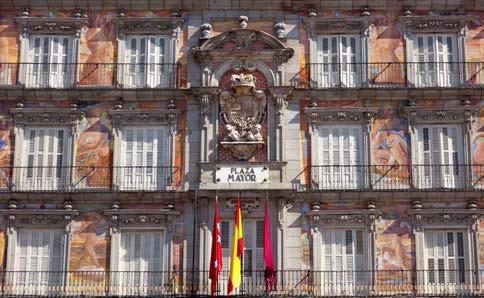
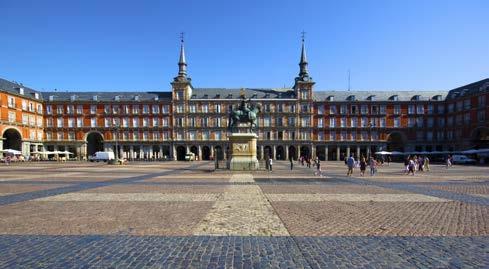
Plaza Mayor – this square, adorned with porticoes, is the main center of Habsburg Madrid. It is located at the site of the old square of Arbaal, which housed the most popular market in the city at the end of the XV century (when King Philippe II and the royal court moved to Madrid). In 1617, architect Juan Gomez de Mora was assigned to unite the city’s buildings in one style. For over a decade, bull fights, blessings, coronations, and sometimes even an auto-da-fé took place at the Plaza Mayor.
COMMENT
Due to the dry climate, summer is hot in Madrid and winter is quite cold. The average temperature in April is 12 ºC, though summer starts properly in May. In June, the average is 21ºC; the Madrid summer is dry, sometimes very hotthe average temperature in July-August is 25ºC. Madrid hosts a soft autumn, especially October (15ºC). The temperatures decreases in November and it often rains. In general, autumn is the best time to visit the city.
CASA DE LA PANADERÍA

Casa de la Panadería (confectionary) is a Diego Silurea project built in 1590; only the basement and lower floor from the original building remain. At various times, it was the city’s main confectionary, as well as the royal palace, the Royal Academy of Fine Art of San Fernando and the Academy of History. Among the paintings that decorate it today, the mythological characters associated with the history of Madrid – especially the image of the Goddess Sibyl (Cybella) – are especially interesting.
The sculpture of King Felipe III on horseback is one of the most valuable monuments of Madrid. It was started by the Flemish scholar Jean Boulogne and was completed by his pupil Pietro Tacca in 1616. The sculpture was handed over to Queen Isabel II in 1848, after which the monument was erected on the Plaza Mayor.
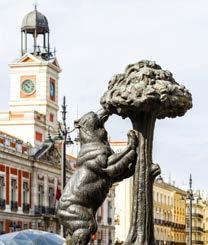

13 VOYAGER 7/2017 DISTRICTS / MADRID
SOL
tended for the aristocracy and bourgeoisie of Madrid.

Traditionally, Salamanca has been home to the political and financial elite of the country.



For the last 50 years, business, embassies and, of course, trade have invaded the quiet life of the district, making it one of the biggest fashion hubs in the city.
SALAMANCA
The Salamanca district is one of the most outstanding areas in Madrid, not only in terms of its unique planning and cozy streets but also its inhabitants. Perpendicular streets like in Paris are distinguished by their architectural style and beautiful facades. The buildings were in-
LA LATINA
The Latin Quarter in the center of Madrid is located by the so-called Habsburg Madrid. The streets were planned in medieval times and are narrow and fascinating. La Latina is the busiest pub and bodega area of Madrid. On Sundays, El Rastro market takes place here and attracts people from all over the city.
CHUECA
Chueca is known throughout the world for its amazing atmosphere and night life. This archaic, avant-garde district is a cultural center, a place of freedom.


The most ambitious design projects take place here, extravagant fashion is born here, and music is performed by the most popular singers amid the aroma of experimental gastronomy and tolerant spirit of sexual liberty.
SANTIAGO BERNABÉU STADIUM

can accommodate 81,044 spectators and has 245 VIP lounges and four restaurants.
During stadium tours, visitors can get to know the most symbolic aspects of the
CHAMBERÍ
The "Holy Blood" quarter preserves the architectural heritage of the Spanish aristocracy. The hospitable summer terraces and shady trees have become a favorite meeting place. If you wish to leave the traditional tourist trail, do not omit a visit to Calle Zurbano. This is one of the best streets in Europe, with private palaces, boutiques, restaurants and wonderful museums.
LAS LETRAS

The most famous writers of the golden century (XVII) of Spanish literature – Miguel de Cervantes, Lope de Vega, and others – lived in this quarter.

We recommend visiting the Lope de Vega House Museum, which has an excellent yard. There are numerous exhibitions and festivals on Spanish streets with Spanish quotes.

club and see the playing field from different places, including the Presidential Lounge.
They are also welcome in the dressing room, where they can take photos of their idols.
14 VOYAGER 7/2017
Casa de Campo, Retiro and Madrid Rio are the best-known parks in Madrid, where you will always find a green corner to explore and relax.
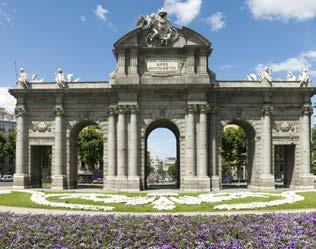
PARQUE DEL RETIRO
With more than 15,000 trees on 125 hectares, this is really a green sea in the center of Madrid.
If you are interested in plants, pay attention to Cecilio Rodriguez's perennial plants in classical style with Andalusian notes, architects’ rose gardens and French marshy cypress, which is considered the oldest plant in Madrid – they say that it is 400 years old.

PALACIO REAL
The palace is an official residence of the royal family, but the last royal who lived there was Alfonso XIII, the grandfather of Juan Carlos I. Palacio Real is currently used for state ceremonies and is open to visitors. Every Wednesday, the ceremonial changing of the Royal Guard takes place. The palace also houses one of the most valuable collections of weapons and armor belonging to Spanish monarchs and royal family members.
The picture gallery exhibits national masterpieces, including the "Virgin and a Child" by Luis Morales and Caravaggio’s "Salome with the Head of John the Baptist."
The royal palace is open from Monday to Thursday; in winter at 16.00-18.00, and in summer at 18.00-20.00. Entrance is free.

LAS VENTAS
This well-known location is where bullfighting takes place annually from May to October, at Plaza de Toros. The history of bullfighting here is an important aspect of Spanish culture.

PLAZA DE CIBELES
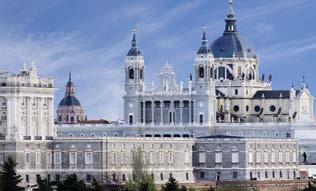

This square contains a fountain that is one of the symbols of Madrid and depicts Cybele, the old goddess of land, farming and fertility.
Traditionally, Real Madrid fans celebrate famous wins here.
PALACIO DE CRISTAL

This magnificent glass and steel pavilion was built in Retiro Park in 1887 by architect Ricardo Velázquez Bosco during the industrial revolution. It adorns the best the artificial waterfall and the inhabitants of the cityblack swans. There are exhibitions of contemporary art and flowers.

CATEDRAL DE LA ALMUDENA
This church was built in honor of the patron saint of Madrid. The wedding ceremony of the king’s successor Prince Felipe and famous TV presenter Letizia Ortiz was held here.
PUERTA DE ALCALÁ
This gate was designed by architect Francesco Sabatini in 1778, commissioned by King Carlos III. This granite structure is an example of proportionality, harmony and elegance. The royal coat of arms, a figure of an angel, is the work of Francisco Gutiérrez.
15 VOYAGER 7/2017 DISTRICTS / MADRID
MUSEO DEL PRADO

Prado is a grandiose museum not because of its physical size but due to the importance of its collection. The quintessence of masterpieces surprise even the most versatile visitors. Due to the wealth and vast influence of the Spanish Royal court, the finest works of the best painters were acquired for the royal collection. Owing to either the inherent taste of the Spaniards or the hard work of the advisors, for centuries the collection was filled with amazing works of art.
Prado's collection includes masterpieces of fine art from the 12th to the 20th century. Prado became a museum in its current sense in 1819. The current collection includes 7,600 paintings, most of them treasures of the world culture. Every year, the Prado museum receives 3 million visitors.
The works of Velasquez, Goya, Bosch, Rubens and El Greco alone would have been enough to make Prado a world class museum, but this list is further extended with the masterpieces of the Italian renaissance and the Flemish school.

The collection El Greco, a 16th-century painter of Greek origin, will be a discovery even for those who are well-acquainted with the work of this brilliant artist. Several portraits will let you see the scale of this artist in a different perspective.

Prado holds only one work of Rembrandt, but I assure you that this sole painting is worth the whole museum. Like any other masterpiece, this work raises a lot of ques-
tions; the most important among them was resolved in 1986, which was the question of its authorship. The issue was that the signature was missing the letter "D"; additionally, art scholars have critiqued the yellow color of the signature. Finally, it was clarified that many Rembrandt’s paintings from 1633 lacked the letter "D", while the nature of the work corresponds to the artist’s style in the given period. After proving the authenticity, scientists switched to the story in the painting. They initially believed that it was Artemisia who was depicted but following several years of research, it was deduced that the author had painted Judith during the feast of Holofernes.
The portrayal of Judith as a freedom fighter character could have been a Spanish protest against the rule of the Netherlands. As is the case with most of the woman painted by Rembrandt, Judith is reminiscent of Rembrandt’s wife, Saskia.

Interestingly, the fate of the building was not decided until Charles’s grandson, Ferdinand VII. Encouraged by Queen Maria Isabel, the building was turned into a fine art museum. The main goal of the museum was primarily to emphasize the importance of the royal court by displaying its rich collection and to show that Spanish painting did not fall short of other European art and was equal to it.
The building, which houses the museum today, was constructed in 1785 by architect Juan de Villanueva on the orders of Charles III to host a cabinet of natural history.
You will see that there is truth to that theory as soon as you enter the Velasquez Hall. There is nothing that this amazing artist could not do: from conveying the scattered gaze of an innocent child to creating a heroically direct portrait of a tramp.
Visitors to the Prado museum freeze in front of the mysterious Hieronymus Bosch

16 VOYAGER 7/2017
La Trinidad. El Greco
Judit en el banquete de Holofernes (antes Artemisa) Rembrandt Harmensz van Rijn
Las Meninas, Velázquez, Diego Rodríguez De Silva Y
El caballero de la mano en el pecho El Greco.
Triptych and stare at the visuals of heaven and hell for hours. It is nearly impossible to decipher the source of the artist’s imagination, unrestrained fantasy, and irony bordering on cynicism. Visitors should patiently wait for their turn, since it certainly takes time to study this masterpiece. Today in Prado you view the triptychs from the other side. This was impossible in the past as the paintings hang on the wall; now they are located in the center of the room and give a full view of the genius of Bosch.
Another masterpiece, “The Creation” as painted by Bosch, is a true wonder. Here too, one will not get a full understanding without detailed examination. God the Father introduces to a saddened Adam a new friend – Eve. But if you look around you will see that the garden of paradise is full of divine experiments - the creatures that God has created or is still in the process of creation. Fantastic and real animals, a horned giraffe, remarkably similar to that of Pirosmani, a two-legged dog, rhinoceros and phoenix. There truly is no limit to Bosch’s fantasy.
"The Garden of the Earthly Delights" is one of the best known works of Bosch and is undoubtedly worth close attention, though the works of another 15th century Flemish painter displayed here, Joachim Patinir, are no less interesting. Do stop by his paintings. Patinir’s mysterious landscapes deserve thorough examination.

The museum is open: Monday to Saturday from 10.00 to 20.00, on Sundays and public holiday from 10.00 to 19.00. Admission price: 15 €
Entrance to the museum is free from Monday to Saturday from 18.00 to 20.00, and on Sundays and holidays from 17.00 to 19.00.
PASEO DEL ARTE
Three of the notable fine art museums in the world are located in the Madrid "Triangle of Art". This is highest the concentration of fine art objects in the world. A few kilometers apart, you will find the Prado Museum, the Thyssen-Bornemisza Museum and the Reina Sofía Museum.
MUSEO NACIONAL CENTRO DE ARTE REINA SOFÍA
The main goal of creating this museum was to continue the mission of Prado in the direction of contemporary art, from the end of the 19th century to modern times. The museum presents the works of such distinguished artists as Salvador Dali, Joan Miro, Juan Gris and many others. The jewel of the exhibition is Pablo Picasso’s “Guernica”. Open: Every day 10.00 - 21.00; closed on Tuesdays.
Admission price: 10 €
Calle Santa Isabel 52
MUSEO THYSSEN-BORNEMISZA

The Villahermosa Palace hosts the Thyssen-Bornemisza collection, which includes works of such masters as Canaletto, Gauguin, Kandinsky, Hopper and many others. The museum also features Carmen Thyssen-Bornemisza’s famous collection of impressionists.
Paseo del Prado 8
MUSEO CERRALBO

This palace belonged to the 17th Marques de Cerralbo. It currently hosts one of the most important museums in Madrid. The marques left the city more than 50,000 exhibits: paintings, sculptures, ceramics and glass, tapestry, furniture, coins, graphics, gravures, clocks, weapons, armor and archeological objects.
Open: Monday – Saturday
09.30 - 15.00, Thursdays
17.00 - 20.00, Sundays and holidays 10.00 - 15.00.
Admission price: 3 € CalleVentura Rodríguez 17
MUSEO LÁZARO GALDIANO
This museum is located in the Salamanca district and offers its visitors a rare collection: Goya, El Greco, Zurbaran and Bosch, also ceramics, glass, medals and weapons.

Jose Lazaro Galdiano was also a famous publisher. This palace used to host literary evenings with Miguel de Unamuno and Ruben Dario. Among the masterpieces displayed in the museum, the most notable are: “St. John the Baptist in the Wilderness” by Hieronymus Bosch; “Witches Sabbath” by Goya; and “El Salvador Adolescente”, attributed to an unknown Leonardo Da Vinci student.
Open: Tuesday – Saturday 10.0016.30, Sunday 10.00-15.00
Admission price: 6 €
CALLE SERRANO 122
17 VOYAGER 7/2017 MUSEUMS / MADRID
The Nude Maja circa 1800 By Francisco de Goya
Tríptico del jardín de las delicias. Grisalla sobre tabla de madera de roble, 1490 - 1500. El Bosco
BARCELÓ TORRE
The legendary Torre de Madrid, which was designed by the architect brothers Jualian and José María Otamendi Machimbarrena, is considered one of the world's tallest concrete buildings. The magnificent hotel housed in Barceló Torre de Madrid is designed by Jamie Hayon.
Hayon is known for his bold colors, which inspired the hotel’s 256 rooms, foyer, bar and public spaces that are decorated with art and designs from his team.
Here the colors of neon, gentle avocado, and green forests are perfectly combined with art deco mirrors, spherical lights and marble; you will encounter high-end design chairs and paintings of golden threads that adorned the walls of Galerie Kreo in 2015.

laza de España 18 www.barcelo.com
ORFILA
In this hotel, the Garcia family tried to create an atmosphere of the residences of nobles in the nineteenth century.

Antiques and furniture were found all over Europe and the lobby clad in marble, with the walls displaying portraits of the Habsburg dynasty. The hotel is so calm that you cannot even imagine that the main artery of the capital is pulsating somewhere near.

The excellent restaurant El Jardin de Orfila offers Iberian cuisine with Parisian accents. It is famous for its pork confit roasted on a low fire.


Rooms starting at: 250 €
ONLY YOU
Hotel Only You is located in the heart of the Chaueca district where the former book shop El Padrino used to be. Many books are still kept in the lounge-library and in the rooms of the hotel. The white-blue rooms are full of wooden furniture upholstered with cigarette-colored leather. The hotel is distinguished by welcoming, charming and friendly staff in white trousers. We recommend the rooms that look over Barquillo Street and the Princess Isabel Theater.
Rooms starting from 158 €
The hotel's restaurant YOUnique is a real celebration of the exceptional taste presented by the new concept of gastronomy. Bar Dolce Martedì offers delicious cocktails and the best wine options paired with Italian cuisine.
The hotel has the best brunch on Sundays: a variety of salads, olives, cakes, unforgettable coffee and the best music and surroundings.

18 VOYAGER 7/2017
Calle Barquillo 21; onlyyouhotels.com
Calle Orfila 6; hotelorfila.com
URBAN
A porter dressed in a formal uniform will lead you into a dimly lit interior, decorated with wooden statues from Papua New Guinea. The artifacts in the lobby are originals and have been transported by the hotel owner Jordi Close from Africa.
Hotel rooms are decorated with valuable dark wood, leather furniture, fur covers, African statues and Chinese paintings from the XVI-XIX centuries. During the warm nights, the residents of the hotel can go from the first floor bar to the roof. The most fashionable terrace offers an open pool and bar. The hotel is located in the "Golden Triangle of Art" between the Prado, Queen Sofia and Thyssen-Bornemisza Museums.
Rooms start at 190 € Carrera de San Jerónimo 34; hotelurban.com
SANTO MAURO
Marriott's Hotel Santo Mauro is located on Zurbano Street; it is listed among Europe’s finest residences. The locals believe that this street symbolizes Madrid the most. Embassies and hotels are located in great palaces.
The former Palace of the Spanish Duke was designed by Lorenzo Castillo. The Chinese salon of the XVIII century, the London style of the 60s and the famous "red saloon" are here as well. Harmony and calmness can be found in this tall room of the hotel; you can also enjoy the beauty of the gracious garden. The city will seem far away as you relax in these cozy rooms with fireplaces. A delicious brunch in the 1841 library makes an unforgettable impression. Rooms starting at 185 €
Calle Zurbano 36; marriott.com
URSO
This hotel-boutique has its own spa-salon. The building’s neoclassical façade is impressive. The bright, elegant rooms were decorated by Antonio Obrador, who designed the mansion homes of Claudia Schiffer and Michael Douglas. The terraces are well-arranged to provide a nice place to enjoy the city views.
URSO's first floor houses a unique restaurant – The Table By; a new chef and his/her team heads it monthly, changing not only the menu, but also the wallpaper, tableware and furniture. Please book a room with breakfast; it will be served in the beautiful restaurant in Invernadero, which is decorated with bamboo. Biscuits for breakfast are brought from the Royal Confectionery, La Duquesita.
Rooms (with breakfast) start from 162 €
ME MADRID
A nice hotel with individual terraces and pools awaits you at Madrid’s most colorful place, Plaza de Santa Ana.

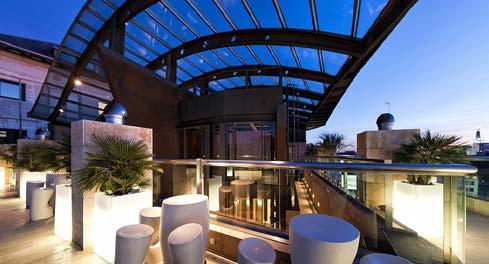
The hotel used to be known as Reena Victoria, and was popular for matadors and their admirers.
As a result of the designers' efforts, however, nothing of this old look has been retained.
ME Madrid is a hot spot for young rich couples, famous stars and the bohemian crowd.

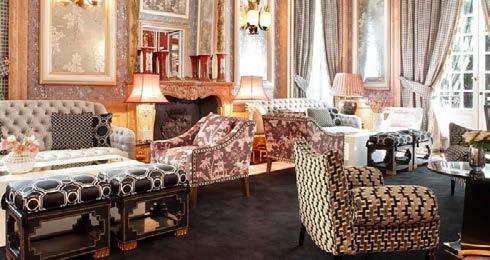
We recommend spending an evening at Midnight Rose – one of the best bars in the city. Enjoy a cocktail at The Penthouse bar as well.
Penthouse rooms starting at (Sweet ME): 2 700 €
19 VOYAGER 7/2017
HOTELS / MADRID
Plaza de Santa Ana 14; www.memadrid.com
Calle Mejía Lequerica 8; hotelurso.com
HERMOSOS Y MALDITOS
“The Beautiful and the Damned" - this is one of Madrid's most famous restaurants. It is called after Francis Scott Fitzgerald's novel that describes the rise of the New York jazz culture before WWI.

The restaurant is located in the Tótem Hotel. Half of its space is decorated with velvet and the other half is the usual place for lunch, decorated in 1950s style with oak chairs and wild flowers.
The dishes are prepared by famous chefs, Rodolfo de Bernardi and Nacho Tirado. They present healthy Mediterranean cuisine. The bar is reminiscent of the prohibition era in the US.

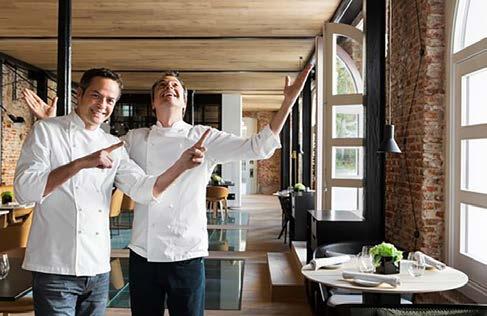
The menu offers many classic drinks; you may also taste unique cocktails made by Fran Camino.

Calle de Hermosilla 23
www.hermososymalditosmadrid.com
LA FÁBRICA
The restaurant was recently opened in Huerta District. There is an art gallery, wine and flower shop, cultural center and bookstore nearby.
In this new and hospitable space, designed with cement floor and beige wooden panels. You will be offered breakfast, lunch and dinner, all composed of seasonal Mediterranean dishes. Taste drinks after dinner in the crowded bar.
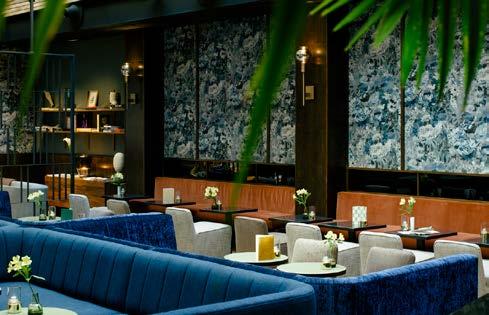
Alameda 9
www.lafabrica.com
DOS CIELOS
Twin brothers Javier and Sergio are the founders of Dos Cielos and their Michelin-starred restaurants at the Hotel Meliá Barcelona Sky. Brick walls, arched windows and plain furniture create a great atmosphere. The outside garden is an ideal place for Spanish summer days to taste the Dos Cielos wines. The brothers have given their kitchen over to Damien Gonzalez; their main task is to enrich the menu with local products.
We recommend the chicken wings prepared with fenugreek, a pork dish and boiled fish with meat and peas, stored for three months in sauce and dill.
Cuesta de Santo Domingo 5; www.melia.com
QUINTIN
The bar-restaurant Quintin presents a Mediterranean kitchen and is famous for its wide variety.

Make a reservation in advance because the inhabitants of the Salamanca neighborhood love this place and it is usually full. Make sure to have dessert –they serve the best cakes and creams.

20 VOYAGER 7/2017
Calle Jorge Juan 17
BOCADILLO DE JAMÓN Y CHAMPÁN
This place serves bocadillos - traditional Spanish sandwiches. Local architect Lucas y Hernández-Gil has created a special aesthetic and minimalist modernism - simple and sophisticated, elegant and refined.





High chairs and tables create a seemingly inexpensive atmosphere, enriched with a wide selection of delicious bocadillos.
We recommend sandwiches made with jamón de Bellotas (acornfed pork), which must be followed by a glass of Veuve Clicquot.
Calle del Pez 36 www.bocadillodejamon.com
ATRAPALLADA
This long-time favorite haunt of the inhabitants of Madrid's Andalusian district was always full of contrasts. Its dining space and the dishes made from Galician seafood were totally mismatched.
Last year, the old-fashioned and shabby interior was replaced with a sprawling area of oak wood and cement. Ceramics are distributed throughout the main space, and the oak creates a cozy setting for bar and seafood.
The special facade is very attractive, featuring geometric metal elements.
Chef Domingo Urosa is popular for his delicious seafood dishes; the pulpo, or octopus, is especially delicious. Also try a delicious sea duck.

Paseo de las Acacias 12; www.restauranteatrapallada.com
ANA LA SANTA
The restaurant is located in central Madrid opposite the Baroque style Teatro Español; four dining rooms surround the marble bar.
The interior is very distinguished with a library of wooden shelves with a fireplace, Ercol's "butterfly" chairs, and artistic wares.
This space is an ideal place for informal meetings, work and reading. Next to you is a futuristic space, whose glass
and metal doors lead you to the Plaza Santa Ana.
Here you can enjoy delicious typical Spanish dishes including kana and tapas.

LA MARUCA
This is Chef Paco Quiros’ (the famous Cañadio chef) third restaurant in Madrid, located in Salamanca. It is named after the Spanish north coast. The La Maruca Tapas menu offers you the distinctive aromas of fresh sea fish. This space is distinguished by its coziness and is reminiscent of a loft. You will encounter Hisbalit glass mosaics and red wooden details; summer and winter terraces; a bar; a lounge and a two-story dining space.
Velazquez 54; www.restaurantelamaruca.com
21 VOYAGER 7/2017
RESTAURANTS / MADRID
Plaza de Santa Ana 14
PLATEA
This former cinema became one of the area’s best culinary spaces. It is headed by four of the most popular chefs in Spain. The building, located in Salamanca, was designed by Spanish architect Luis Gutiérrez Soto in 1952 and then restored by Barcelona designer Lazaro Rosa Violan. The design of the 1950s atmosphere is created by metal products and plush furniture, where the mix of sophistication and drama plays a central role.
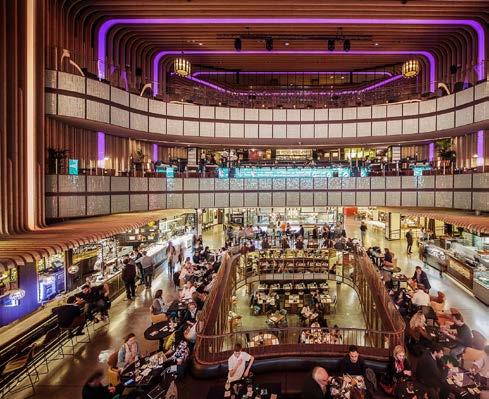
The Arriba restaurant is located on the first floor, led by one of the chefs. The other three have merged to offer you classic Spanish dishes and tapas. You can also enjoy dishes of world cuisine from Peru to Japan. DJ sessions and concerts are held daily on an old stage.
Goya 5
WWW.plateamadrid.com
MAMA CAMPO
The octagonal Plaza de Olavide houses an authentic Spanish restaurant, Mama Campo, where you are offered delicious and healthy dishes.
Chef Daniel Daniel Larios, who trained under threetime Michelin-starred chef Martin Berasatequi, prepares traditional dishes with organic ingredients.
His menu changes according to the season but always includes his famous paella, croquets and rice with kelp and mushrooms.
Enjoy all of this with bread baked by Javier Marca, one of Spain's best pastry chefs.
ENXEBRE
The name of this restaurant has Galician roots; it means authentic and offers domestic cuisine in a completely modern interior.

The restaurant is in full contrast with the old atmosphere of the Embajodores district and the outdoor market, El Rastro.
This Galician restaurant has been in the building has been in 1979; its architects came up with a distinguished look, with a wooden design that surrounds the walls and creates paths defined by the concrete and hexagonal ceramic tiles.

Meanwhile, Chef Domingo Urosa prepares delicacies. Here you can eat seafood with rice, creamy piloa and hot doughnuts.
Paseo de las Acacias 12 www.restauranteatrapallada.com
EL CLUB ALLARD
The best molecular gastronomy restaurant is led by two-time Michelinstarred chef Diego Guerrero. He personally chooses from three different menus, asks about your allergies and will then prepare a culinary masterpiece.
СASA LUCAS
A small restaurant hides behind an unpretentious wooden door. Calamari fried with bacon and served with cauliflower sauce and ink mousse is delicious.
Calle Cava Baja 28
There are only seven tables in a wooden dining room but the owners have managed to decorate it with more than 45 items of designer furniture, including works of Urquiola, Tom Dixon and Pop Paris.
Trafalgar Street 22; www.mamacampo.es
In order to assess the restaurant's nontraditional cuisine, order the tasting menu (80 €). Most importantly, do not forget to reserve a table.
Calle de Ferras 2
LA BARDEMCILLA
Javier Bardem's sister, Monica Bardem's restaurant, offers a cozy space reminiscent of a Spanish home; make sure you have the "round" spaghetti (Huevos de oro estrellados) and croquets (De la madre superior).
Calle de Augusto Figueroa 47

22 VOYAGER 7/2017
Madrid has a rich gastronomic history. This is best illustrated by the number of restaurants that have hosted guests for hundreds of years, offering traditional Madrid dishes and most of the wines in the region. Cocido, Soldadito de Pavia, potato tortilla and, in general, the Castilian cuisine are all things that you can enjoy in these restaurants that have successfully passed the test of time.
LOS GALAYOS
This old restaurant is located in the heart of the city on Plaza Major. It was once known as the Cervecería Rojo” after its founder, Urban Rojo.
The third generation of Rojos manage this restaurant. Initially it was a tavern, offering tapas and alcoholic drinks to visitors, but over time became a real restaurant that is now famous for Castilian cuisine. Some tables are placed directly on the square and the restaurant has two halls - "Shelter" and "Loft".
CalleBotoneras, 528012, Sol, Gran Vía www.losgalayos.net
LHARDY
In 1839, the Swiss Confectionary became the first elegant restaurant in Madrid. "Lhardy" is often referred to in Spanish literature. The owner took the restaurant name from the Paris Café Hardy, and the main secret of the dishes is that they successfully combine old traditions with European panache.


Dining at Lhardy is like time-traveling – as if time has not touched this little island of history, where old interior designs, dishes and service quality and even the silver samovar remain unchanged.

BOTÍN
This restaurant was founded in 1725 and its history is associated with the names of well-known people such as Goya; they say that in 1765 (probably) he worked here as a dishwasher. Hemingway's novel "The Sun Also Rises" made this restaurant and its roasted pig famous forever. At that period, French chef Jean Botin and his Austrian wife built a small furnace here. Pork and lamb is still roasted on it. Today, the restaurant is headed by the third generation of this family. It occupies the fourth floor of the building and retains its old atmosphere.
Calle Cuchilleros 17; www.botin.es

LA BOLA
In 1870, Candida Santos turned Madrid’s oldest café, where cool drinks were sold during the Habsburg Dynasty in Madrid, into a restaurant. La Bola is famous throughout the city for it cocidos. It is said that the aforementioned version of this dish, which

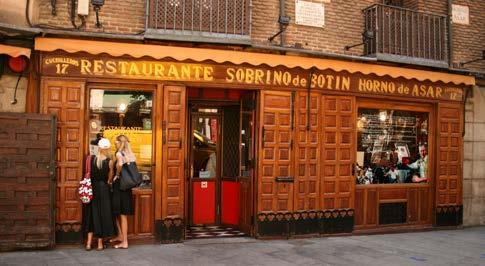

is cooked over oak wood, is enjoyed by members of the royal family. The sixth generation continues to prepare cocido in clay pots. Ava Gardner visited this place frequently.

23 VOYAGER 7/2017
RESTAURANTS / MADRID
Carrera San Jerónimo 8; www.lhardy.com
Carrera San Jerónimo 8; www.lhardy.com
CASA LABRA
Located near Puerta Del Sol square, the Casa Labra tavern has been hosting visitors since 1860. It is famous for its tapas with cod fish-- freshly-fried pieces or in the form of a croquette.
Calle Tetuán 12
ESTADO PURO
The traditional gastro bar of Paco Ronsorro offers more sophisticated appetizers than traditional tapas. Here, Spanish gastronomy is presented through the lens of haute cuisine, which recognizes no boundaries.

Here one can try unusual dishes such as the XXI-century Spanish tortilla, a canapé of sun-cured Iberian bacon or Galician octopus, all washed down with a beer poured masterfully at the bar. Estado Puro maintains its core concept while trying to convey the pure Spanish experience of the world.
PlazaCánovas del Castillo
VI COOL
Sergi Arola is a chef from the Vi Cool restaurant who places his bets on upgraded tapas. VI is the first syllable of vino (Spanish for wine), and cool means something very modern – this is how the Catalan chef explains the name of one of his two restaurants in Madrid.
Both eateries are oases of calmness where one can try several daring culinary offerings, such as potatoes A La Brava and Coca Oladis.
C/ HUERTAS 12
www.vi-cool.com
LA GASTROCROQUETERÍA DE

CHEMA offers its guests a wide choice of croquetas suited to all tastes.

Calle Barco 7
DRAY MARTINA
MERCADO SAN MIGUEL
A market built in 1916, this is a meeting place for Madrid’s gourmands. It has 33 stands under its domes selling high-quality groceries and dishes. You can also buy food to go. You can reach this market from Plaza Mayor via Calleid Rodrigo.

There is wealth of choice, from with newly made tapas to fresh oysters. Make sure to taste Paella de Marisco in the Paella y Olé cafe, shop in the fromagerie Queso Manchego and order a glass of red wine in the wine bar nearby.
You can ask the vendor to cut you as many thin slices of jamón as you like and place them in a vacuum pack (al vacio). This service is offered at most Spanish markets. The best places to buy jamón are at Mercado San Miguel. You can also find a good jamón in Five Jotas bar.

MERCADO SAN ANTÓN
There are 14 shops in this market. World gastronomy is represented and culinary shows are held in an open kitchen on the second floor. The third floor hosts the La Cocina de San Anton restaurant and a terrace with a bar where you can enjoy a nice snack at the counter.
Calle de Augusto Figueroa 24
PONCELET CHEESE BAR

_ –
Another gastro bar that you should definitely visit Calle Argensola 7
You should come for a tasting after 13:00 when the hall with a vertical garden is opened, overlooking the cheese depository of the bar. A plate of five different kinds of cheese will cost you 16 euros. You can buy all sorts of things at the Poncelet store nearby. There are over 170 Spanish cheese varieties to choose from and products from eight different cheese-producing countries.
Calle de José Abascal 6
24 VOYAGER 7/2017
Madrid is the capital of flamenco. There are many tablaos where one can see flamenco shows, though the best places are Corral de la Morería, Tablao Villa Rosa, Café de Chinitas – one the premises of the Plaza de Oriente palace (the favorite place of American presidents) – and Casa Patas.
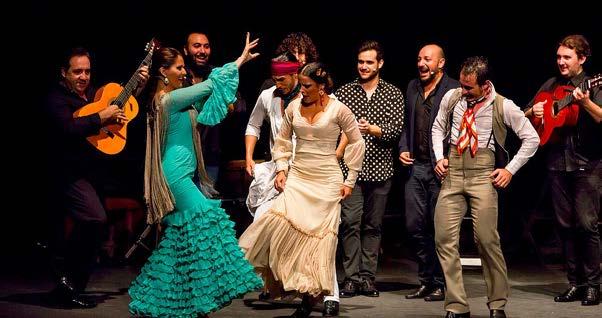
TABLAO VILLA ROSA
This celebrated old restaurant, where flamenco performances are regularly held, is truly legendary.

You can find it easily - the facade is ornamented with decorated ceramic tiles. Great flamenco cantaors and baialaors have performed here, while at various times famous writers and artists have sat in the audience, including Ava Gardner and Ernest Hemingway.
Two performances of flamenco singing and dancing are held daily in the hall decorated with its arched carved wooden ceiling (on 20.30 and 22.45).
Viewers are comfortably seated at the tables in front of the stage and can dine with a glass wine and enjoy the show.
The menu includes delicacies of Iberian pork, barbecued on coals, roast fingerlings and paella. This is the restaurant where Pedro Almodovar filmed the first scene of "High Heels".
Opening hours: everyday - 11.00 - 01.00
Plaza Santa Ana 15 www.tablaoflamencovillarosa.com
Corral de la Morería is top night attraction in Madrid - you must visit it. The entrance fee for the show, excluding dinner, is 45 Euros.
CORRAL DE LA MORERÍA
This tablao, with its restaurants and flamenco stage, is one of the oldest in Madrid. It has hosted many celebrities, such as Harry Cooper, Rita Hayworth and Charlton Heston; politicians and presidents such as John Kennedy, Richard Nixon, and George Bush; and outstanding painters including Pablo Picasso and Salvador Dali. Recently, it has been visited by A-listers Nicole Kidman, Hugh Grant and Natalie Portman.The stage of the Corral de la Morería is legendary due to the fact
that the greatest cantaors and guitarists have performed there: Isabel Pantoja, Antonio Gades, La Chunga, Blanca Del Rey and Pastora Imperio.
It is believed that this tablao is the main "cathedral" of Flamenco in Spain. Currently a permanent troupe performs here.
Opening hours: everyday - 19.30-21.30 and 21.55-00.00
CASA PATAS
This tavern-restaurant in the center of Madrid, famous for its Spanish cuisine, offers the best flamenco performances every evening. Up to 40 people can fit in the small hall.
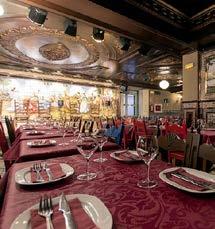

If you want to be seated near the stage, you should order your tickets two weeks in advance.
Price: 36 €
Calle Cañizares 10
www.casapatas.com

25 VOYAGER 7/2017 GASTR0BARS / TABLAOS / MADRID
Calle Morería 17; www.corraldelamoreria.com
TAÜER BAR
At Taüer, the most famous bartender in Spain, Argentinian Diego Cabrera, offers a variety of cocktails, mainly gin-based, for €10. Try sweet Orange Blossom with Brazilian Cachaca, lime, passion fruit and orange, as well as the whiskey-based Yellow Chilli with egg white, lime juice, red chili, cardamom and gin. Taüer offers what it calls "honest" food. The portions are big enough to share with friends. The terrace is considered one of the best in Madrid.

Taüer is located on the outskirts of Madrid, in the popular Aravaca village, but you can also enjoy Diego’s cocktails downtown in Platea and the Michelin-starred Domo (in hotel NH Eurobuilding).

Open Monday - Thursday - 18.00-01.00, Friday - Saturday - 18.0002.30
STREETXO
Queues regularly form in front of this bar. It opened only a year ago but already boasts the best cocktails and Asian-Spanish fusion cuisine, prepared in an open kitchen. With the aroma of food, cheerful chatter and energetic chefs, a real gastronomic spectacle awaits you here. The most popular item on the cocktails menu is Que Viva Mexico Cabrones! (Long Live Mexico!) –a mixture of white tequila and jalapeno with agave syrup and cheddar cheese. Then there is Dabiz Munoz, which tastes of smoke, spices and "madness". They don’t prepare cocktails the usual way here: ingredients are fried, evaporated in a thermomixer, or baked on a slow fire. This is why visitors claim that this bar sells the best cocktails they have ever tried.
Prices: Cocktail - €9-14, main courses - €12-20

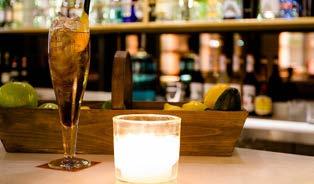

Open: everyday - 13.00-17.00 and 20.00-24.00
MACERA TALLERBAR
Chef brothers Narciso and Abelardo Bermesa have created a taste laboratory amid exotic interiors. Various spirits from all over the world are sent to Macera: gin, whiskey, vodka, rum and vermouth. Firstly, Marcello ages them, and then he creates special tinctures, including fusions with herbs, spices, cinnamon and citruses. Here, priority is given to healthy food. The menu features grilled sandwiches, home-made fruit cakes and green purifying juices. A tincture or cocktail costs €7, and juice is €2.50.
Open: Tuesday - Sunday from 13.00 to 23.00, 01.00 or 03.30
TEN CON TEN
This bar in Salamanca has been a gathering place for Madrid’s high society for 10 years. Here, you might bump into soccer stars or actors. It is always crowded and fun, and most importantly, everything is delicious.
The drinks menu includes 30 different types of champagne and cava.
The best of all is Spanish red Vega Sivilia Unico and champagne. Cocktail prices start at €14. There is also a bistro and an excellent restaurant. Tables should be booked three weeks in advance.
Open: Tuesday - Friday - 20.00-01.00
Calle de Ayala 6
KRUG IN THE RITZ HOTEL

This exclusive venue is visited by devotees of Krug champagne. It is the only establishment in the world that will serve you the mythical Clos de Mesnil drink. You will also be offered rosé and vintage beverages and various delicacies, including black caviar, oysters (Daniel Sorlut) and the best Iberian ham.
You can also enjoy champagne by the bar or stand in a beautiful lobby accompanied by piano performances. Price for one glass: €50. Open every day: 12.00-01.00
Plaza de la Lealtad 5
26 VOYAGER 7/2017
Calle San Mateo 21
Aravaca Village, Camino de la Zarzuela 17-23
Calle Serrano 52
EMBASSY
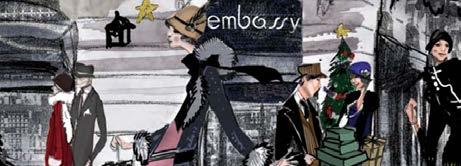
The Embassy Tea House opened in 1931. Margarita Taylor, of Irish descent, decided to open an English cafe where women could drink tea in a quiet environment. Soon, women were not the only ones drinking tea here: diplomats, artists and intellectuals also became loyal customers. Today, the third generation of the same family owns the Tea House. A restaurant and a boulangerie have been added, but the tea house remains open of course, offering a wide variety of tea, chocolate and coffee.
Paseo de la Castellana 12; www.embassy.es
Madrid never sleeps. There are many clubs that open until dawn. The city has several entertainment districts, and you will always find a place suited to your tastes.


Jazz, flamenco, pop, rock and indie music - the literary quarter is one of the most desirable places for those who love nightlife. For over three decades, jazz has been performed at the legendary Café Central. For saxophone music, blues and soul, visit La Fídula and Populart. If you go down Puerta street, past St. Ana Square, you will find Echegaray Street on your left. Here, you’ll discover Cardamomo, one of the most popular concert halls in Madrid, where flamenco rules the stage. The literary quarter perfectly combines bohemian art with classical and modern musical styles.
The Malasana-Trivall district, cradle of the first musical manifestation of the celebrated Movida Madrileña (countercultural movement), remains an epicenter of the leading fashions. Dos de Mayo Square is the main destination for those who want to spend the night in this district; rock, punk and
indie pop determine the night rhythms of this district. The Salamanca district, often visited by the richest people, is a world of elegance and style. Local clubs and pubs are drastically different from other entertainment venues in Madrid. Serrano 41, the most popular Madrid club, is a true symbol of the nightlife in the Salamanca district, with its terraces, chill-out zones and dance zones. It opens at 23.00 and offers funk, pop and house music.
Gran via, a century-old street, always was and remains one of the main centers of entertainment for all generations. The Puerta del Sol Square district is a distinctive corner of the city where one can feel the soul of the Spanish capital just by watching the locals gather for the evening’s entertainment.
CASA MIRA
150 years ago, Luis Mira, the master of nougat (turron in Spanish), loaded his donkey-drawn wagon with candy and left to conquer Madrid with his confectionary. He reached the capital only on the fourth attempt, as the candy was stolen along the way and he had to return to his native village. Mira became a supplier to the Spanish royal court, won the grand prix of the Paris World Fair in 1899 and achieved a lot more thanks to his outstanding mastery of his trade.
The current owners –“Luis Mira’s descendants”, according to a sign in the main store – are the sixth generation of owners.
1 kg of turron of any kind costs €45. Apart from nougat, Casa Mira offers cakes, candies and chocolates.

Carrera de San Jerónimo 30 www.casamira.es
COMMENT
Places where smoking is not allowed are always indicated by “No Fumar” or “Está Prohibido Fumar” signs. Smoking is not permitted in the interior of bars, restaurants and other public locations, through outdoor smoking areas are to be found everywhere.
The fine for the first offense for smoking is €30, while a second offense is €600. The sale of tobacco in supermarkets is prohibited. You can buy cigarettes only in special shops with the Tabaco sign.
If you are traveling to Spain for the first time, keep in mind that Tabaco shops are closed on Sundays. You can also buy cigarettes from machines in bars and cafes.
27 VOYAGER 7/2017
BARS / CAFES / MADRID
World-renowned brands can be found in Salamanca: José Ortega y Gasset, Claudio Coello and Serrano streets host Hannibal Laguna, Adolfo Dominguez, Devota & Lomba, Juan Antonio López, Antonio Pernas, Pretty Ballerinas, Kina Fernández, Prada, Pedro del Hierro, Manolo Blahnik, Loewe, Suárez, Chanel, Gucci, Louis Vuitton, Miu Miu and other brands.
JARDÍN DE SERRANO
We recommend that you visit this small but elegant shopping center, located in a magnificent XIX-century building. Shop in exclusive boutiques like Alfaro 1926, Lottuse, Umo, Yanes; here you can buy interesting clothes and enjoy a delicious lunch.
Calle de Goya 6-8
LA GAFERÍA
If you plan to buy a pair of glasses, head straight for this shop, which features the brands Matsuda, Luba Studio, John Dalia, Gotti, Theo Loves You, Francois Pinton, Linda Farrow and Platoy in a huge selection of optical and sun glasses. Many of them are handmade.
C.C. Jardín de Serrano, Calle Goya 6-8
ALFARO 1926
SCOTTA 1985
CORTE INGLÉS
Corte Inglés, located on Serrano Street, offers men's and women's clothing and shoes from the most prestigious brands.

Here you will find all kinds of accessories, bags, jewelry, watches, accessories, perfumery, cosmetics and so on.
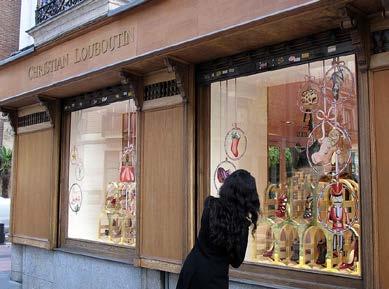
ABC SERRANO
Pay attention to these Spanish brands: Javier Simorra, Bimba y Lola, and Aita.
AROUND CALLE JORGE JUAN
Hugo Boss, Barbour, Hackett London, as well as Spanish makes Loewe, El Ganso and many others can be found here. In addition, this street houses many men's shirt stores, such as the Italian makers Brioni and Anglomania. “Jorge Juan Night" is held annually on June 13. The street is closed to cars and the bars and mini theaters are set up in the open air. The shops are open till midnight.
This is a multi-brand shop with a wide selection of jackets and cuffs and brands: Avant Toi, Caban Romantic, Charlotte Sparre Coy, Cutuli Cult, Dolfie, Fabiana Filippi, Faliero Sarti, Woolrich, Zanone, and Zinga –all original collections of clothing, shoes and accessories.
Calle de Goya 7
OAK
Here you can buy high-quality male and female attire and handy accessories in an urban style.

Calle de Belen 7
PALOMA BARCELÓ
This store presents a wide variety of sportswear and shoes for men and boys; you can also buy special hiking and hunting gear.
Calle de Jorge Juan 31
Keep in mind that after your first purchase in Corte Inglés, you can request a special fiveday discount card for travelers and enjoy a 10% discount in all stores belonging to this network.
Calle de Serrano 70 / Calle de Serrano 52
GLENT
These shoemakers will scan your feet with a 3D scanner, select a design and over the following four weeks produce the best-quality shoes to fit you perfectly.
Jorge Juan 14
SASTRERIA PEDRO MUÑOZ
This clothing store has been operating successfully for 50 years and is a partner of companies like Stefano Ricci, Kiton, Brioni, Schiatti, Sutor Mantellassi, Valenti, and Eddy Monetti. It is a favorite of Salamanca’s residents.
Calle de Serrano 72
This Spanish brand has been specializing in the production of handmade exclusive espadrilles and sandals since the 1960s. The store sells summer and sports shoes.

Calle de Claudio Coello 26
PEDRO GARCIA
Shoe and leather accessories have been made here since 1925. The quality of the leather and the comfort of the products is the store’s main focus, which has made Pedro Garcia famous throughout Europe. The choice is varied, from satin shoes to rain boots. The shoes that you buy here never wear out due to their quality. The brand's bags are also very popular.
Calle de Jorge Juan 12
28 VOYAGER 7/2017
CLAUDIA DI PAOLO
Visit this store to purchase the following brands: Agent Provocateur, Beautyblender, Christophe Robin, Eve Lom, EviDenS de Beauté, I.C.O.N., La Ric, Lazartigue, Leonor Greyl, Précellence, Quick-Tan, Rodial, Shu Uemura, and Visuanska París. The store also carries niche perfumery, facial and hair care products. In addition, it features a salon and a day spa.
Jorge Juan 39
PERFUMERÍA ÁLVAREZ GÓMEZ
Alvarez Gomez is the oldest perfume house in Spain. The first aroma – Agua de Colonia Concentrada – was created in 1912 and is still very popular. It is still prepared according to the original formula. It is a unisex perfume and its citrus compilation
PESETA
includes notes of bergamot, lemon and lavender. The brand conveys exceptional, sophisticated style and high quality.



Calle de la Fragua 22
If you are genuinely interested in traveling and appreciate high-quality accessories, you must seek out this shop in the literary quarter of Madrid. It offers everything: beautiful pants created by young designers, computer bags, backpacks, notebooks, a thousand accessories - belts, scarves ... this is the best place to buy gifts for your loved ones.
huertas 37
COMMENT
DELITTO E CASTIGO
The prestigious –brand store Delitto e Castigo (Calle de Claudio Coello 26) and the designer Spanish boutique Masscob (Calle Puigcerdà 2) offer shoppers completely different collections that cannot be found anywhere else in Madrid.
EKS & EKSEPTION
If you want to buy a special item and your budget allows it, visit the multibrand stores in the Salamanca region - Eks and Ekseption. Here you will find brands of clothing, shoes and accessories such as Dries Van Nouten, Balenciaga, Marni, Prada, Miu, Marc Jacobs, Versace, Azzaro, Fendi, Pierre Hardy, Jil Sander, Oscar de la Renta, 19 RM, and Martin Margiela.
Calle Velázquez 28 ARISTOCRAZY

The innovative jewelry of this brand is known for its quality and uniqueness in addition to its original shape.
Centro Comercial El Jardín de Serrano. Calle de Goya 6-8
You can find taxis in special taxi stops at Madrid's stations and the airport; in other places in the city, you can easily hail a taxi in the street. You have to pay with cash. The fare is 2.40€ between 06.00-21.00, from Monday through to Friday; outside of these times it is 2.90 €..
The fare is different in different zones (the A zone corresponds to the capital of Madrid, B Zone its nearest municipalities). The fare for each extra kilometer varies according to the zones and time of day and costs between 1.05€ and 1.25€.
One hour of travel during the day (06.00-21.00) costs 20.50 € and during the night (21.00.06.00) 23.50€.
The maximum price is 5 € in the A zone and 8 € in the B zone. The fee is higher during the holidays. If you order a taxi online, it costs you a fixed price of 30€.
CONDE DUQUE & MALASAÑA
Besides the fact that Malasana is fun on weekends due to its multitude of pubs, cafes and taverns, it is also one of the most important shopping centers in the city.
Vintage, youth and alternative fashions are the main styles of this district. There are several stores that offer retro-style goods, where the last decade’s clothes are sold, as well as new clothing designed in retro styles.
EL TEMPLO DE SUSU
Espíritu Santo 1 POPLAND
Calle de Manuela Malasaña 24
Malasana was the center of the famous "movida" of the 1980s. It was a true revolution pushed by writers and artists. Today, this is a place where you can find your dream leather jacket that was popular at that legendary time.
Every Saturday, collectors and antique markets are held on May 2 in Malasana. It was joined by the Dosde Market in 2011, which was created to support young designers.
PLAZA DEL DOS DE MAYOR
Plaza Mayor houses Madrid's oldest stores. There are many restaurants, traditional bars, ateliers, handmade items and souvenir booths.
Here you will find the most popular Spanish souvenirs and a great choice of dresses, flamenco and sevillanas costumes.
ANTIGUA CASA CRESPO
It has a centuries-old history that offers a large selection of "alpargatas" – popular summer espadrilles.
Divino Pastor 29
CHUECA is an avant-garde fashion center in Madrid. It features showrooms of beginner as well as established designers.
Some small and quiet streets are located between Chueca, Fuencarral and Hortaleza; they are interesting places for shopping too.
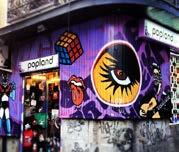
29 VOYAGER 7/2017
SHOPPING / MADRID
TOLEDO
Toledo shines under the sun like the sharpened Spanish sword that made this city famous. This small city, which one can cross in a day, carries an invisible trail of the former capital of Spain.

Its crisscrossed streets, crawling higher and higher contrary to the laws of physics, are filled in the evenings with the rustle of abanicos and the clicking of the castanets of past centuries.
The sharp contrast of light and shadows of the El Grecian figures overlooking the marble floors in Toledo Cathedral is the main tourist attraction of this city. It was in this city that the most modern of the classical artists lived for many years.
El Greco's house that is open to visitors may be a well-executed replica but it will still give you a good impression of typical Toledo architecture.
SEGOVIA
The body of a Roman aqueduct, twisted like a dragon and covered in stone scales, encircles the city. It either rises like a grandiose mountain, or gets lost in the walls of the small streets, but is always somewhere close.
It is strange; as well as this masterpiece of Roman engineering, Segovia is also famous for a much more trivial creature – one with a tail curled like a spring.


At the weekends, hordes of Spaniards with a voracious appetite hurry to this city to enjoy its famous cochinillo, or roasted pig. It takes 1.5 hours to get from Madrid to Segovia. The bus fare is 8 EUR on average; the train 15 EUR. You should purchase your tickets in advance.
If you plan a trip for gastronomic reasons, which is the usual story in Segovia, you should consider the following factors: reserve a table in advance. Every good restaurant opens its doors to customers after 8 PM but the last buses and trains leave at 9 PM.
An impressive collection of El Greco's works is displayed in two places in Toledo: the Museum of Santa Cruz and his personal museum. Entrance to the Santa Cruz museum is free of charge though you must pick up your ticket at the admission office.


COMMENT
Daggers and swords are the main souvenirs. To purchase a genuine piece of Toledo steel, you will need to visit an antique store but there is also a wide selection of quality replicas. You can find souvenir daggers of all sizes in Toledo.

It is easy to get to Toledo. If you take a bus from Madrid, you will be standing by its stone city wall in just one hour. The average ticket price is 8 EUR. You will not be able to reach the city by foot and should take a taxi.
Besides making a reservation in such restaurants, you will need to pre-order the cochinillo as well. A small pig is roasted for hours, and then to underline its tenderness, they cut it in front of you with a plate. Although you can only order a whole pig, it is so small that four gourmands could easily finish it between them.
You will never forget a pig that you have tried in Segovia, so it’s worth renting a car or even staying in this wonderful city for a night.

30 VOYAGER 7/2017
Mesón De Cándido Plaza Azoguejo 5, 40001 Segovia, Spain
Meson Don JIMENO Calle Daoiz 15, 40003 Segovia, Spain
Restaurante José María Calle Cronista Lecea 11, 40001 Segovia, Spain
TOLEDO / SEGOVIA

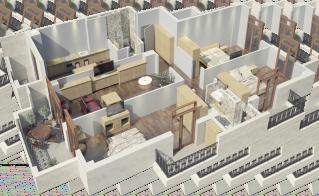




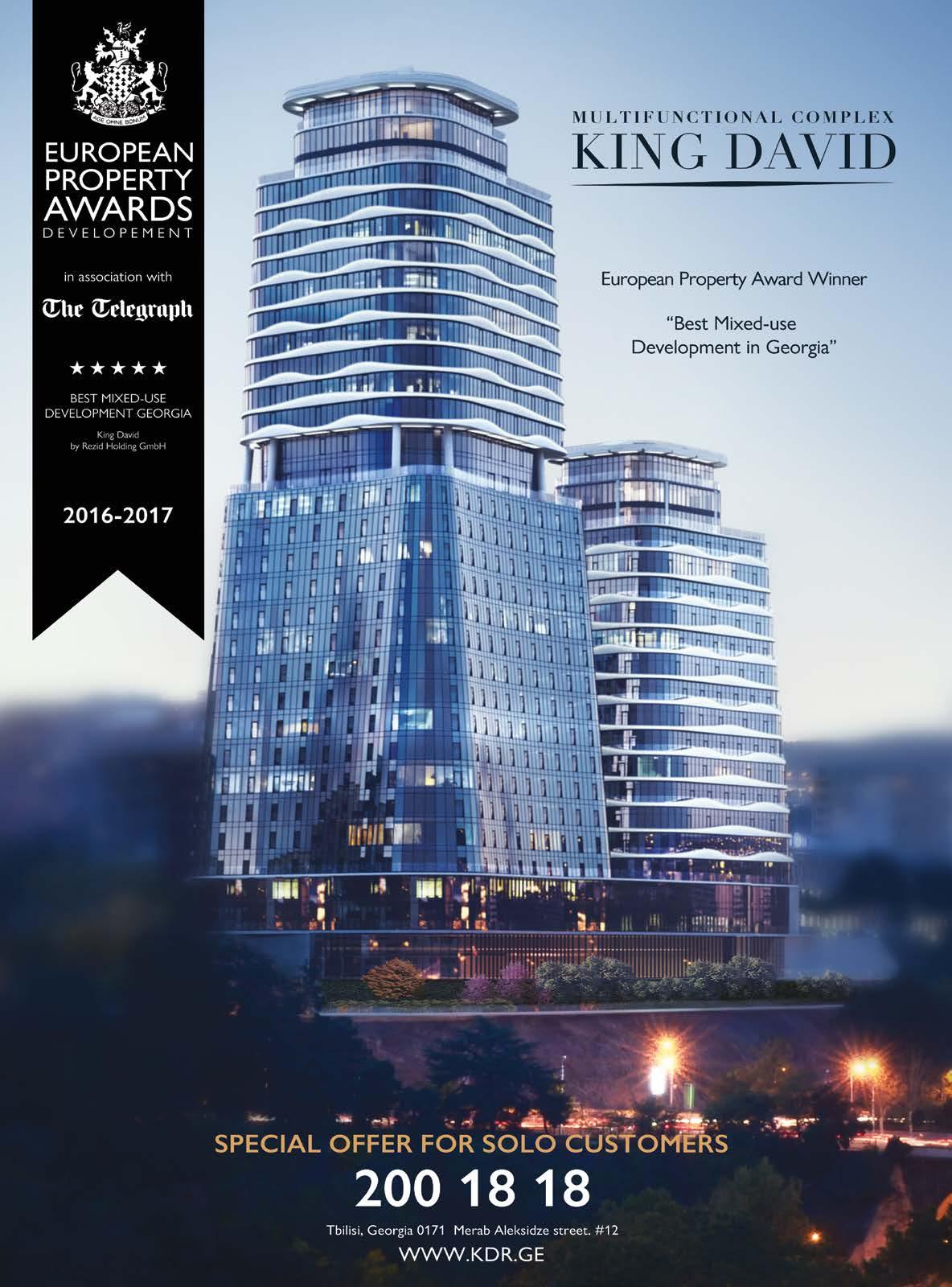

BARCELONA
Barcelona is the only city in the world with nine buildings listed on UNESCO's "Heritage of Humanity". These include: La Sagrada Família, the home of the Vicenus (La Casa Vicens), the Batlio House (La Casa Batlló), the Guillaume Colonial Crypt (la cripta de la Colònia Güell), La Pedrera (La Pedrera), the Guele Castle Palau Güell), St. Jury and St. Paul's Hospital, El Park Güell, and Catalonia Music Palace (El Palau de la Música Catalana).

Barcelona may be called the capital of the Mediterranean: there is no other place in the world thatmergesthesea,sky,medievalmood,architectural wonders, gastronomic feasts and healthy southern hedonism.


The summer is warm in Barcelona but the temperature rarely rises above + 31°C; winter is dry and comfortable with the average temperature above 10°C. The bathing season lasts from March to October.
LA SAGRADA FAMÍLIA
Barcelona's most important unfinished construction leaves no one indifferent. The history of the cathedral somewhat "fits" with medieval law. In 1882, the decision was made to build a church in the middle of the valley, to save people from their sins. The building was constructed by the unknown architect Willy, and later by the young Antonio Gaudi. Gaudi only managed to finish the fountain of Christ and the tower of Saint Barnabas. The architect did not have a preliminary outline of the project; even his sketches were burned by anarchists during the civil war, so everything constructed after 1926 is built after the death of Gaudi and represents the fantastic aspirations of his assistants.
In the 1980s, construction was hastened and, in theory, it should have been finished by the 100th anniversary of the death of the author, but only six of the 18 planned towers have been built yet (you can go up two of them by elevator). Construction is scheduled to be completed by 2026.
When purchasing tickets online, choose the exact date and visiting hours you require. Late entries are not permitted.
Open: March, October: Everyday 9.0019.00; April-September: Everyday 9.0020.00, November-February: Everyday 9.0018.00
Price of a ticket: 15 €. Children until 10 can enter for free.
Carrer de Mallorca 401 www.sagradafamilia.org
34 VOYAGER 7/2017
PLAÇA REIAL



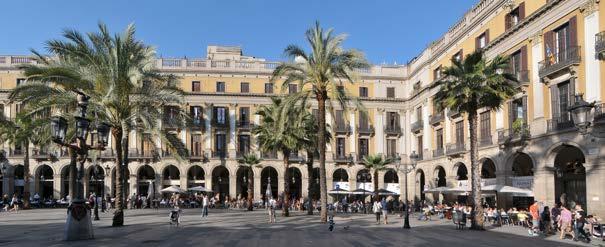
This beautiful XV-century square is the most breathtaking place in the medieval city. Only the entrance staircase located in the corner of the square remains from the original building of the Palau Reial Major, from which Catalonia was ruled by the dukes of Barcelona from the XI century.
According to legend, which is far from the truth, the royal couple Isabelle and Ferdinand stood on these stairs in 1493 to greet Christopher Columbus returning from his first overseas journey. This architectural ensemble is decorated by Antonio Gaudi’s lanterns, surrounded by houses with galleries and balconies and reminds you of the Parisian Place des Vosges, only adorned with palms.
The crowded and colorful boulevard La Rambla is the best place to get familiar with Barcelona. The boulevard begins from the sea coast, close to the Colombus monument. La Rambla is the heart of the city. Musicians' improvisations, opera singers, mimes, artists, human figures, flowers and birds kiosks, the food market la bokeria, an endless number of shops and cozy cafes - all of these will make your walk along La Rambla unforgettable.
The core of medieval Barcelona is located on a small piece of land around the Plaça Sant Jaume, which was enclosed with walls during the Ancient Roman Empire.


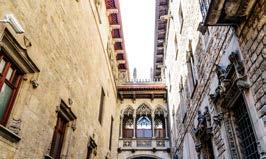
CASA DE L’ARDIACA
The main house of the deacon is located near the cathedral, at the left of the entrance. Do not miss the excellent modern details that have emerged as a result of the reconstruction at the beginning of the XX century, such as the marble images of swallows and turtles adorning the postbox. It was designed by Lluís Domènech i Montaner.
SANTA MARIA DEL PÍ
Santa Maria del Pi is one of the most important gothic temples of the city. The western facade is decorated with a huge vintage rose image.
SANTA MARIA DEL MAR
Santa Maria Del Mar is the most harmonious gothic cathedral in Catalonia. On May 25, 1329, the first stone in the foundation was placed by King Alfonso.


CATEDRAL as soon as you turn from the royal square around the corner, you will directly approach the apse of Barcelona's Catholic cathedral. If you look up, you will see the gargoyles on the roof of the gothic church; the most beautiful ones are located on this part.
HOSPITAL DE SANTA CREU St. Cross Hospital is an important part of the history of this quarter. The complex was built in 1401 and was the main hospital of the city until 1926 (Antonio Gaudi died here). Currently, it hosts the Catalonia Library and other institutions. In the inner courtyard of the former hospital, you will find a quiet place surrounded by rare greenery.
35 VOYAGER 7/2017
DISTRICTS / BARCELONA
EIXAMPLE DISTRICT
The Eixample district is a unique example of urban development in Europe. It features some of the best examples of modern architecture within a district designed by architect Ildefons Cerdà in 1860. The most famous buildings are located on Passeig de Gracia.
Architects Antoni Gaudí and Lluís Domènech i Montaner implemented their creative fantasies in homes commissioned by the Catalan bourgeoisie.
Among the most renowned buildings are the houses of Casa Batlló, Casa Amatller,




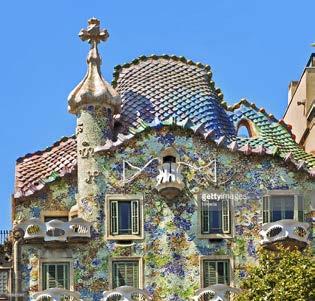

In 1900-1914, Antoni Gaudí built 17-18 hectares of park for Eusebi Guell. Gaudí’s house is located inside the park, where the famous architect lived from 1906 until his death in 1926. At present the house is a museum.
Open: 08.00 - 21.30.
Ticket prices start from €7.
Casa Vicens is one of the first works completed by Gaudí, constructed on the orders of the owner of a cement factory in 1883-1885. The history of the Batlio house is anecdotal because the local government was opposed to the construction, ordered by the textile magnate. Today, this house is a sightseeing location in the city.

CAMP NOU _ Camp Nou, home of Barcelona football club, is the biggest stadium not only in Spain but in Europe. It can seat 100,000 spectators, but that does not mean it's easy to get in. There are twice as many official members of the club as there are seats in the stadium, so you should look for tickets on the internet only for secondary matches, or just for stadium concerts.
The stadium also has a museum: Excursion ticket price: €23, with discount €18.
Arístides Maillol 12 www.fcbarcelona.com
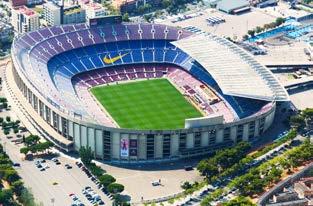
36 VOYAGER 7/2017
CASA BATLLÓ PASSEIG DE GRÀCIA 43 FROM € 23
CASA MILÀ - LA PEDRERA PASSEIG DE GRÀCIA 92 From € 25
Mila (Casa Mila, more famously La Pedrera). These incorporate the diversity and splendor of previously unseen architectural forms.
Casa Vicens
MUSEU PICASSO

Pablo Picasso lived in Barcelona from time to time. The museum’s collection contains Picasso's earliest works until the pink period, as well as some mid-period and late works. There is also a collection of ceramics by Jacqueline Picasso. The museum leaves a chaotic impression.

The vernissage opened in 1963 in the Dennigarh Palace in Bergerger, gradually taking over five other medieval houses, with its interior yards and stairways and a modern wing added later.
FUNDACIÓ JOAN MIRÓ

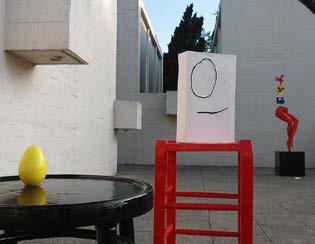
This museum was built with the artist’s involvement during his lifetime. Miró and his friend, architect Jacuzzi Luis Serti, together created a building full of light that has a collection featuring many of Miró’s paintings, sculptures and drawings from the earliest period when the artist was fascinated by fauvism until his late lyrical surrealism. Works by other artists that were given to Miró are also displayed, including the famous "mercury fountain" by American Alexander Calder.
Open: Monday - Saturday - 10.00-20.00, Sunday - 10.00-14.30
Ticket price: €12
Parc de Montjuïc www.fmirobcn.org
Buy a ticket in advance by selecting your desired date and time on the museum’s website. If you are more than 15 minutes late, the ticket will be canceled.
Ticket price: €11, children free. Entry for any visitor is free after 15:00 on the first Sunday of the month.
Open: Monday-Wednesday, Friday-Sunday - 9.00-19.00, Thursday - 9.00-21.30.

Montcada 15-23 www.museupicasso.bcn.cat
MERCAT DE SANT JOSEP DE LA BOQUERIA
This legendary market, known as La Boqueria, is famous for its excellent food stalls and restaurants, and it is one of the most beautiful of Barcelona’s markets.
Here, you can buy everything that represents the richness of Mediterranean cuisine, from artichokes and sea algae to fresh humus and rare species of dill. Just like in other Spanish markets, people go to La Boqueria not just to buy food but to have a breakfast at the stalls offering freshly prepared sea food.
Open: Monday-Saturday _ 8.00-20.30.
La Rambla 91 www.boqueria.info
COLMADO MÚRRIA
Established in 1898, this magnificent modernist gastronomic store still has its original façade. It is made up of colored mosaic tiles that advertise wine and liqueur.

Carefully chosen expensive delicacies are also displayed. French cheese, Russian caviar, Iberian ham and Belgian chocolate are on offer. The wine selection is diverse, including French and Spanish varieties.
Open: Wednesday-Friday - 10.0020.30, Saturday - 10.00-14.00, 17.0020.30
C/Roger de Llúria 85 murria.cat
Visiting Barcelona's museums and sights during peak season is difficult and often impossible due to long queues and limited tickets. Plan visits to Sagrada Familia, Guel Park and Picasso Museum in advance and buy tickets online if possible. In addition, you can buy the Articket (www.articketbcn.org) at tourist centers, which allows you to get into Barcelona's six best museums, including the Picasso, Juan Miro and Catalonian national museums.
37 VOYAGER 7/2017
COMMENT MUSEUMS / BARCELONA
THE COTTON HOUSE
There are 83 comfortable and elegant rooms in this hotel located in its legendary building. Five are spacious suites.
The lobby is completely decorated with mirrors; you will find two stairways in the hall: one is made of marble and the other is a 1950s spiral staircase, which deserves the admiration of architects. Here you will find a sophisticated library, a beautiful glass space, and a 300 m2 green terrace. On the 6th floor there is an outdoor pool, a small gym and a massage room.
The hotel's Cosmopolitan Cocktail Bar and Restaurant Bautar will offer you something that you won’t be able to find in many cities - non-stop service with finger food from 7am until noon.

You will find a long list of exclusive cocktails on the menu. The Gossypium Cocktail is especially tasty, which was specially designed for Cotton House Hotel and includes pisco, blue curacao, gin and lime.
Gossypium means "cotton flower" in Latin and in the space named after it, the hotel concierges offer guests extraordinary service.
They individually provide information about culture, cuisine or even practical things. These concierges are considered experts on Barcelona and provide comfort and satisfaction to their guests.
GRAN VÍA de les CORTS CATALANES 670 www.hotelcottonhouse.com
SOHO HOUSE BARCELONA
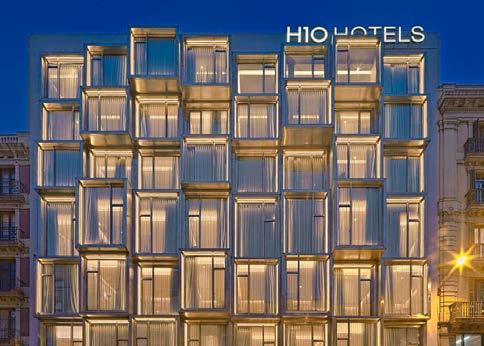



This hotel is located in a restored eighteenth-century building at the Plaça del Duc de Medinaceli. If you walk from here, you will soon reach the legendary Las Ramblas and Gaudi’s Palau Guell.

As well as its 57 rooms of different sizes, there are two restaurants in the hotel, a swimming pool on the roof, a 30-seat cinema and a distinguished Cowshed Spa, where you can enjoy British treatment products.
The building’s modern style and geometric shapes will remind you of the brutal architecture of the twentieth century with futuristic features and bright colors, drenched with natural light, due to its huge windows.
A delicious lunch is waiting for you at the Market restaurant. The Robotik Bar offers amazing cocktails and you will enjoy enchanting panoramic views from the eighth-floor pool terrace.
Plaça del Duc de
Medinaceli
4 www.sohohousebarcelona.com
Via Laietana 69 www.h10hotels.com
38 VOYAGER 7/2017
H10 CUBIK
MANDARIN ORIENTAL

This hotel is located in Passeig de Gràcia and is one of the most popular places in the city.


It is surrounded by modern gardens; you can enjoy the panoramic views from the hotel's hall, which perfectly blend style and fivestar comfort. Its modern design and timeless elegance make the hotel truly original.
The excellent interior, Michelin-starred restaurant and relaxation spa are the peak of luxury.

The interior decorated by designer Patricia Urquaiola's with 120 rooms and suites is among Barcelona's most luxurious places. There are 92 rooms, some with their own balcony, and 28 huge suites.
Here, distinguished dishes and drinks are prepared under the guidance of two Italian chefs, Carmé Ruskaleda and Raul Balami, both of whom have two Michelin stars.

The hotel spa is designed to make you feel in paradise: an open pool on the roof, as well as a relaxation zone, facial care procedures, an extensive list of Maribel Yébenes' facial care products, a huge variety of treatment methods and holistic therapy procedures are all you will need to soothe body and soul.
Passeig de Gràcia 38-40
www.mandarinoriental.com/barcelona

BISTREAU This restaurant is a masterpiece from Spanish designer Patricia Urquaiola. She designed the upper part of this huge space using a metal framework. The penetrating daylight creates an atmosphere like an underwater world. The high-backed leather cane-wood chairs are surprisingly comfortable. The menu is saturated with seafood and belongs to Chef Angel Leon.
I recommend you eat a pork burrata with miso and tomato or grilled paltus with yuzu and a Catalonian sparkling wine like Cava.
CASA BONAY
Casa Bonay, with its modern service and lifestyle, makes the hotel’s cultural heritage even more attractive. It was first opened in 1869.
The architect Francesco Batle designed the building in a neoclassical style; it was a residential building and home for artists. The renovated hotel's great, bright rooms await you with amazing comfort. The gardens on the roof of the hotel are a perfect spot to relax.
www.casabonay.com
39 VOYAGER 7/2017
Passeig de Gracia 38-40
Gran Via de les Corts Catalanes 700
HOTELS / BARCELONA
TICKETS
Ferran Adria is a world-renowned Catalan chef, who opened (and later closed) El Bulli, the most famous restaurant of the century, where fantastic molecular experiments on food were performed.
As for Tickets, this is a circus version of El Bulli where Albert Adria, Ferran's brother and world-famous chef works. Here chefs perform miraculous feats of balance of culinary work.
You will be served tapas, which can be perceived as kind of a phantom;
as well as ham sticks with Kimchi and Yamuto, called "Travel in Seoul".
The olive soup melts in your mouth and is delicious. Nearby, in the Albert Bar (41 Degrees) you will be offered magical seafood.
Open: Monday-Friday - 18.30-22.30, Saturday - 13.00-15.00, 19.00-22.30
Tickets should be booked two months in advance or you will need to arrive when it opens, hoping that someone is late. Dinner will cost you €40.
ENOTECA
Two of Paco Perez’s restaurants, Enoteca in Hotel Arts, and Miramar in the chef’s hometown village Lyons on the coast of Costa Brava, have two Michelin stars each. His other restaurant in Barcelona, Royale, offers breakfast for €20 and the best burgers in the city (Plaça del Camp 5, laroyale.es).
Today everyone is excited about Perez’s revolutionary initiative at the L'Eggs restaurant (Passeig de Gràcia 116, leggs.es). Many of the dishes are based around eggs and these masterpieces cost €30.
Enoteca remains the main scene for Perez.
Avinguda del Paraŀlel 164; www.ticketsbar.es
TEN’S, ABAC, ANGLE
The young Spanish chef, Jr. Croes, owns three restaurants in Barcelona: TEN'S is a very good tapas bar, where you will dine extremely well for €40.


Carrer del Rec 79, tensbarcelona.com
ANGLE restaurant holds one Michelin star and is located in Hotel Cram. Gourmets do not go here to look for the star, nor the modernity, rather the incomparable dishes, among which the chopped beans served with salted casserole. The tasting menu consists of 10 dishes and costs €90.
Carrer Aribau 54, restaurantangle.com
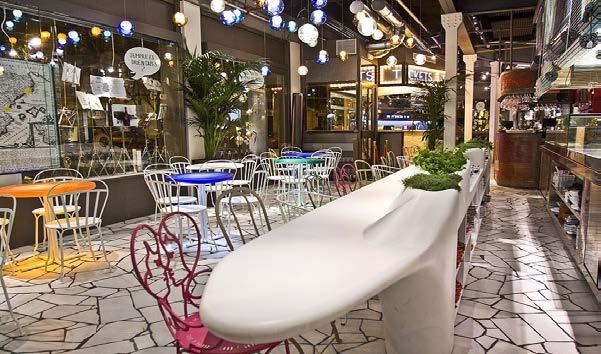
ABAC is Barcelona's most famous, two star restaurant where dinner costs €65.
Avinguda del Tibidabo 1, abacbarcelona.com
Here he uses decadent ingredients for elite cuisine - truffles, foie grass, sea urchin caviar, but the chef's dishes are not too esoteric, on the contrary, they have the influence of traditional Catalan cuisine.


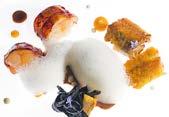
Among them are crispy cannelloni with black chicken and ham, and delicious beans (a la catalana) with pancetta, Catalonian pig sausage (botifarra) and tiny octopus.
Enoteca focuses on fish and seafood, Mediterranean dishes and new ingredients.
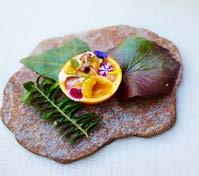
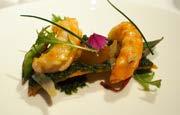
The wine list is also impressive – 700 brands from world and local producers.
Calle Marina 19-21
www.hotelartsbarcelona.com
40 VOYAGER 7/2017
PETIT COMITÈ
Petit Comitè is the best local (locavore) restaurant in Barcelona. The title “Locavore” should not be confusing as it only refers to an institution that works with local organic products and the traditions of ethnic cuisine. Chef Nandu Juban prepares traditional cuisine only with Catalan food.
The menu is seasonal, with the main dishes varying according to the day of the week: stewed beans with meat, broth with cloves, pig ears etc. Dinner will cost you €40.
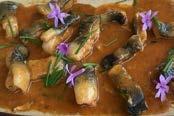

CECCONI’S
The menu in this classical Italian restaurant includes hand-made pasta, seafood and North Italian dishes prepared from the best ingredients.
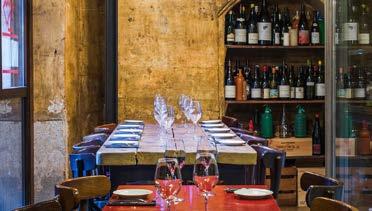
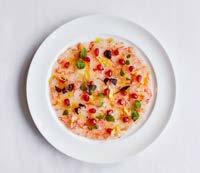
Open: Monday - Thursday - 12.00-01.00, Friday - Saturday - 12.00-02.00, Sunday - 12.00 - 00.00
Passeig de Colom 20
It's definitely worth paying a visit to this Italian restaurant in Barcelona, which is run by Venetian twin brothers Stefano and Max Colombo. They were industrial design specialists in their hometown, and created Xemei ("Gemini" in Venice Dialect) 10 years ago. Its impressive design makes you feel the twin brothers’ profession: graphite walls, eclectic furniture, souvenirs. Stefano also makes unforgettable cocktails. Make sure to taste red wine stewed cloves with mint and gnocchi, and sea scallop with polenta.
OCAÑA
Ocaña looks more like a vintage furniture store, with its old classroom tables, bended wooden chairs, faded red velvet seats and lamps placed on the floor.
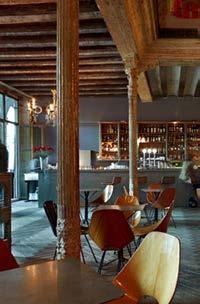

SUCULENT
Traditional Catalan and Spanish dishes are prepared in this small restaurant: crispy eggplant with sweet peppers, tomatoes and onions; salted cod with olive oil and garlic sauce; white beans with bacon and cheese.

The prices are quite affordable, for example, dinner will cost you €25.
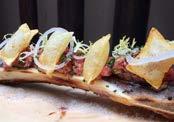
Rambla del Raval 43; suculent.com
Owner Khoikki Laguna found candlesticks from the Les Pic Original brand in Parisian flea markets.
An amazing contrast is created by the staircase and by dividing spaces made of concrete and steel. This place is a unique mix of styles.
Plaça Reial 13, 14, 15 www.ocana.cat/en
Average price of dishes: €20
Paseo de la Exposición 85; xemei.es
CAN CISA BAR BRUTAL
The Colombo brothers own this other beautiful place with its amusing interior and décor like in their Xemei restaurant.

In this bar you will be offered interesting flawless wine varieties, hence you can go there not only for dinner but drinks, too.
Carrer de la Princesa 14 cancisa.cat
COMMENT
In Spain, any cost that the client pays includes the cost of service, so tips are no longer mandatory, but it is common to leave a tip in bars and restaurants, hotels and in taxis, normally 5-10 percent of the total.

41 VOYAGER 7/2017
XEMEI
Passatge de la Concepció 13; petitcomite.cat
RESTAURANTS / BARCELONA
EL XAMPANYET

This bar is located near the Picasso Museum, and since the 1930s has pampered guests with local sparkling wines and tapas.
There are rarely spare tables, so it is always fun to be there in the evenings for a cheerful dinner.
Open: Monday-Saturday - 12.00-15.30, 19.0023.00, Sunday - 12.00-15.30
Carrer de Montcada 22
BAR DEL PLA

If you have time for just a tapas bar, you will definitely have to visit a place where you can taste new versions of classic tapas. Breakfast is supposed to be basic, but as soon as the plate is served, you will realise that the cooks have worked magic, as the tapas are accompanied by wasabi, truffle oil, a cuttlefish black ink or mango chutney.
Open: Monday - Wednesday - 12.00-23.00, Friday - Saturday - 12.00-00.00
Montcada 2; www.bardelpla.cat
SAGÀS PAGESOS, CUINERS & CO.

The name of this restaurant is translated as "peasant cooks". To prepare dishes, only those products that are delivered from the farm of the Rovira family living in Piriney are used. Special praise is given to cooked pork roulette.
Price of dish: €28
Pla del Palau 13 sagaspagesosicuiners.com
CAL PEP
The marble top of this amazing bar offers a delicious surprise – Pep or Jiuseppe is himself a culinary legend of Barcelona. He is trusted so much that dishes are ordered even without the menu.

It is well known that Pep has a skilled hand and prepares excellent fish and seafood, so his bar has found a place in every travel guide.
Open: Monday - 19.00-23.30, Tuesday - Friday13.00-15.45, 19.30-23.30, Saturday - 13.15-15.45, 19.30-23.30
Plaça de les Olles 8; www.calpep.com
QUIMET Y QUIMET
Delicious tapas are prepared in this small bar, which is decorated with wine bottles. Ferran Adria made this place famous.
It has the best tapas, including a favorite - salmon with yoghurt, honey and truffle oil. In the summer there are always a lot of people gathered outside the red door of the bar. Here you feel as if you were in the 1920s.

Open: Monday-Thursday - 12.00-16.00, 19.0022.30, Saturday - 12.00-16.00
Poeta Cabanyes 25
BAR NOU
The classic dish is from traditional Catalan cuisine - Pa amb tomàquet – tomato spread bread, which is prepared according to the guest’s preference, as they choose the bread, tomatoes, salt and olive oil the cooks use in preparation.
The décor reflects a combination of modernity and tradition. The arched ceiling creates a cozy atmosphere, sharp yellow furnishings and neon lighting installations reflect the pumping energy of Catalonia's capital.
Ronda Universitat 13
CAÑETE BARRA Y MANTEL
The French name suits this new generation bistro well.
The number of such small restaurants in Barcelona is increasing, with many people and a free atmosphere, and the food is delicious and filling.
The Cañete Barra y Mantel is a Catalan tavern and Andalusian tapas bar at the same time.

Enjoy fricadelle with cuttlefish souse, Belgian oysters and roast beef.
Price of the dish: 30 € Carrer de la Unió 17 www.barcanete.com
42 VOYAGER 7/2017
ROCA MOO
The Roca Moo, holder of a Michelin star, follows the old Moo tradition, while the Roca Bar is characterized by a freer atmosphere with tapas and cocktails inspired by street food.
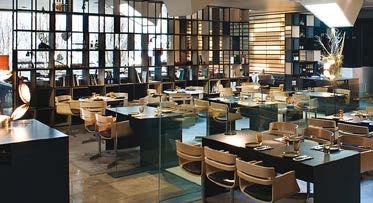
Carrer del Rosselló 265 www.hotelomm.com
BODEGA 1900
The bodegas, or small gastronomic institutions, are part of the cultural heritage. Anar a fer el Vermut (meeting with a glass of drink and small tapas) is a trend that is characteristic of Spanish and Catalan identity in recent years. Bodega 1900 prepares dishes using old recipes. Everything is a mixture of the 1900s and modernity.
Here you can enjoy salazones (salted products), dried fruits, marinades.

Open: ThursdaySaturday - 13.00-22.30
Carrer de Tamarit 91
www.bodega1900.com
SOLOMILLO
Under the leadership of Chef Enrique Valentine, this steakhouse turned into a cozy place like other modern small restaurants. The lower floor and bar offer delicious dinners, lunch, cheese and meat.

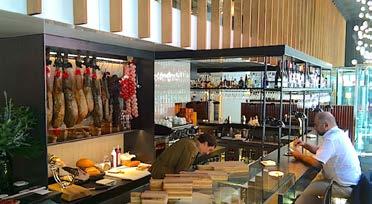
Calle Mallorca 251 www.restaurantesolomillo.com
COMMENT
LA DOLCE VITAE
This is one of the best bars in Barcelona. A wide variety of cocktails and sparkling wines will delight visitors with different tastes. You can completely relax and chill out in this bar. The best DJs play at nights and the best artists in the world are invited to participate in the programme (Majestic Sunset Sessions).
Passeig de Gràcia 68
PAKTA
Albert Adria’s current most interesting project is the Peruvian and Japanese cuisine. He owns a Michelin star restaurant in the Poble Sec district. Here you will be offered sashimi with peas and kimchi, sea-urchin with black truffle sauce and Japanese lemon, and soba in “tiger milk” with bottarga.
Price for dinner: €45
Carrer del Lleida 5 www. ca.pakta. es
DRY MARTINI
This cocktail bar is often referred to as "the best in the world". It's the only one in Spain to be nominated for this title. What should you drink? The name of the bar gives the answer.

Carrer d'Aribau 162-166
PACHA
This excellent bar offers you more than a night in a calm environment. Here you will find worldclass DJs, such as Hot Since 82 and Marco Carola. The huge terrace and the beach section of the Barceloneta makes this distinctive Spanish bar attractive for guests.
Passeig Marítim Barceloneta 38
APERITIVE AND DIGESTIVE
The evening in Catalonia is divided into three phases: Aperitif starts at 6, dinner at about 9, and cocktails at 11. An alternative name for the aperitif is la hora del vermut or vermouth time.
At the beginning of the century, when the Italians imported spiced wines, the Catalans fell in love with Vermouth, created new recipes and invented the verb - vermutear, meaning spending the evening with friends with a glass of vermouth, olive and a piece of orange.

7 PORTES
This is an old institution where traditional paia and botifarra are prepared. The café was opened in 1836 and the restaurant in 1929. During this period the café was visited by Marquez, Miro, Pele, Che Guevara, Orson Welles and Woody Allen. There are about 100 Catalan dishes on the menu; however, the restaurant is more focused on Valencian paias. Dinner: €40
Open: Monday-Sunday _ 13.00-01.00
43 VOYAGER 7/2017
Passeig Isabel II 14 www.7portes.com
RESTAURANTS / BARCELONA
Shopping in Barcelona is a real pleasure. A long range of famous shopping lines goes along the old city, starting from la Ramblas going through the Square of Catalonia as well as in the Paseo de Grazia and Diagonal Street (Pasacaig de Gracia, Diagonal).
This is a continuous range of stores stretching up to 5 km (a total of 35,000 stores). If you do not have the strength to go all the way, I recommend you stop at Grazia Street.
PASSEIG DE GRACIA
Here you will discover luxurious boutiques that you can only dream of, from Chanel and Louis Vuitton to Burberry and Dior Homme.



This avenue is considered to be the most expensive place in all of Spain. It is famous for its shops and hotels and you can enjoy the unique modern architectural design of Barcelona.
PICNIC CONCEPT STORE

SANTA EULALIA
Santa Eulalia has providing clothing for rich Barcelonians since 1843. It is the main place for purchasing brands like Marc Jacobs, Lanvin and Etro. However, Santa Eulalia, which is famous for its own style of shirts and clothes for men, carries a line of women's clothing too.

Santa Eulalia is the most prestigious department store in Barcelona. It is spread over 2000 sq. M. The women's and men's clothing units include pop-up stores, a café and a cozy terrace. The store has already turned into an important meeting place for
representatives from the world of fashion. It is often visited by famous stars, stylists, trend-setters and modern fashion lovers.
BERIESTAIN
This Chilean designer caused a great hubbub on Barcelona's artistic scene, and now invites his admirers to a calm, home environment.
Here you can taste Chilean cuisine as well as enjoy the minimalistic, eclectic and glamorous design of the 60-year-old Italian chandeliers. You can also buy original interior items, antique dishes, rare fragrances, books and flowers.
Milan's "Corso Como" and "Collette" were pioneers of conceptual shops in Paris. In its essence, the conceptual store is a place where the preference is given to an idea. In such shops, you don’t buy a particular item but a lifestyle.
WER-HAUS
This conceptual shop combines three different spaces: a department store, a coffee shop and restaurant, an art gallery and a rare book store.
"Wer-haus" is a union of the ideas of Nicolas Ross, Jean-Antonio Palgos and Marc Miro and, eventually, the overall result of their style, tastes and photography.
The conceptual "Picnic" in Barcelona does not present your usual fashionable items or accessories. The concept is central here.
Designers Enrique Rodriguez and Berta Fernandes have created a small space with aesthetic aplomb.
Concrete, natural wood, an old heater and beautiful lighting create a cozy harmony. You won’t find the latest fashion trends here; here you will purchase an eternal item.

44 VOYAGER 7/2017
Carrer d'Aragò 287
Pau Claris 167
Passeig de Gràcia 93
Carrer Verdi 17
MAR DE CAVA
One of the first conceptual stores in Barcelona specializes in handmade design items and furniture; the designers are artists from Spain or other parts of the world.

The 500 sq.m meter hall is located a few minutes’ walk from Passeig de Gracià and is reminiscent of Aladdin’s cave, where you will find painted bags, embroidered pillows, small gifts, candles, ceramics, books about design, etc.

Mar de Cava, Carrer de València 293
NUOVUM
This is the place where you can buy everything from jewels to backpacks and rare items that are placed on the hive-shaped shelves inspired by Scandinavian themes.

Nuovum, Carrer del Pintor Fortuny 30
BORN
The Born Bohemian district gathers together fashionable youths and avant-garde shops.
Here one will find lower-end and local brands, though there are also popular brands such as Custo, Lobby, Hugo Boss, Coquette, Hamptons,
Como Agua de Mayo, La Commercial, Marithe, François Girbaud.
The Born district also has expensive boutiques with beautiful and expensive modern clothing and accessories.

If you want to see high-end international brands, visit Turo Park.
Altair is also a publishing house that prints interesting reference books, other books and the best magazines.
ALTAÏR
One of the biggest travel literature shops in Europe is a true Mecca for any traveler or adventurer.

LA COMERCIAL HOMBRE
In six stores for men and women, you will find everything you need to be well dressed, starting with designer clothing and niche perfumery.
You can also buy Diptyque candles. In addition, you will find a collection of sophisticated jewelry, wallets, etc.
In this neighborhood, in # 75 Paul Smith's wide range of shoes is represented.
C/Rec 73

GREY STREET
This street offers an eclectic combination of styles, from pop culture to vintage. You can buy luxury items including fashionable clothes, family and stationery items, jewelry, art and etc.
Grey Street, Carrer del Peu de la Creu 25
Here you will find hundreds of guidebooks (including many in English), books written with pictures accompanied by maps, novels with the same theme, convenient equipment and travel diaries.
BON VENT
This conceptual shop is inspired by the Mediterranean lifestyle. You can buy vintage silver knives, antique fabrics, old-fashioned soaps, and items that look like they belong on old postcards. You can also find Spanish designer clothing and typical local fabrics like espadrilles.
Bon Vent, Carrer de l’Argenteria 41
MUSHI MUSHI COLLECTION
The narrow streets of Barça Grazia are full of shops, among which are beautiful boutiques. Mushi Mushi Collection is one such store – a small shop that offers a wide range of women's clothing from brands like French Sessún, Zero Cent Cinq and Des Petits Hauts, as well as British Orion London. Somewhat indifferent, loose-fitting clothes are romantic and feminine. There are also shoes and accessoriesbags and jewelry.
C/Bonavista 12
45 VOYAGER 7/2017
Gran Vía de les Corts
SHOPPING / BARCELONA
EL CORTE INGLÉS
Every floor of this not-so-attractive building on Catalonia Square is full of men’s, women’s and baby clothes, home appliances and furniture, cosmetics and perfumes.
Open: Monday-Saturday 9.30-21.30
Plaça de Catalunya 14
BOO
The brands presented in this store create an interesting picture of different styles. Here, old, already established and new brands are harmoniously combined. You can create an absolutely outstanding, individual wardrobe.

Carrer Bonavista 2
COMO AGUA DE MAYO
This shop offers a wide range of women's clothing and accessories. The shoes are particularly interesting and include products by brands such as Pedro García, Ras and Otto et Moi.
Nearby, at Les Petits del Agua de Mayo, you will discover jewelry, scarves, hats and small accessories, were the styles of the brand are charmingly blended with old fashion.
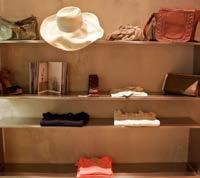
C/Argenteria 43
MERCAT
DELS ENCANTS
You have to go here early in the morning. You will definitely see something rare, like an old lamp or a two-centuries-old silver dining set.
On Saturdays, antiquities auctions are held here at 7.00 pm.
Avinguda Meridiana 69
CHERRY HEEL
In this fairytale boutique, you can discover your inner Carrie Bradshaw from the famous TV series, who was fascinated with buying shoes. It is full of Italian products that are designed by the most prestigious and popular designers.

The store is located in a beautiful modern building comprising several levels. Each of them is equipped with shelves, desirable footwear brands and matching bags and accessories.

C/Mallorca 273
The most common shopping hours are from Monday to Saturday 9.30-13.30 and 16.3020.00.
Big shopping centers and department stores are open from 10.00 to 21.00 or 22.00 in the evening without a break.
COQUETTE
Here you can purchase brands like Danish Hoss Intropia and French Isabel Marant, Laurence Doligé and Athé by Vanessa Bruno. Do not miss out on these bespoke accessory collections.
The retro bathing costumes are especially interesting.
C/Rec 65
LA MANUAL ALPARGATERA
This is the oldest Spanish store in Barcelona (Espardenyeria). Many famous people have bought hand-sewn shoes here, including Jack Nicholson, Salvador Dali and even two Popes.

In-store, you will find all styles of espadrilles, starting with the classic model that is worn during the traditional Catalan Sardana dance as well as more modern versions.
C/Avinyó 7
EL GANSO
British style incorporates the best suits, checkered shirts and colorful ties; the young Madrid brand El Ganso is saturated with nostalgia for the twentieth century, as if it is waiting for Woody Allen or Sean Connery to show up.
Rambla de Catalunya, 116
46 VOYAGER 7/2017
ORIOL BALAGUER
This pastry shop is an innovative take on modern sweet cuisine and can be referred to as alternative gastronomy. The designs and tastes of its products are made according to what is trending at the minute.
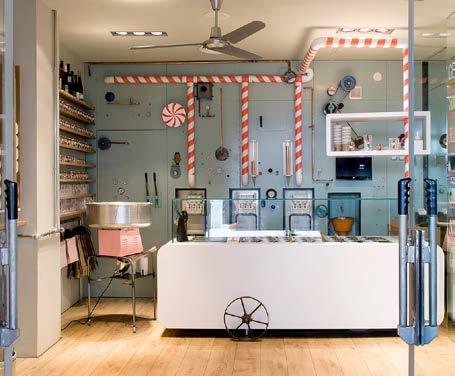
Here you can find high-tech chocolate; an Easter egg bearing a monkey's face; chocolate candy as a "nail-polished" fruit of cocoa. It is interesting that Oriol Balaguer calls his ultra-modern pastry shops boutiques or workshops.

PASTELERIA ESCRIBÀ
The historical patisserie and café Pasteleria Escriba is located in two locations in Barcelona, La Rambla and Gran Via. Anthony Escriba is also known as the "Chocolate Mozart" and, after his death, the century-old traditions of Pasteleria Escribà are maintained by Cristian Escriba. If you would like to spend a “sweet” day, you definitely must visit this place.
Open: Monday-Thursday - 12.00-17.00 and 20.00-23.00, Friday-Saturday - 12.00-17.00 and 20.00-00.00, Sunday - 12.00-17.00
www.escriba.es
BUBO
Charles Mammal is one of Spain's most famous confectioners. The confectionery network is Bubo's place where you can taste the delicious fruits of his creations. If you do not love desserts, you can get black and white candies as a souvenir that are often bought by travelers.
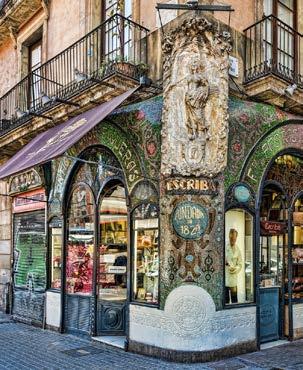
Gourmands come here to taste the socalled “upside down eclairs” or futuristically decorated biscuits. Apart from the biscuits, Bubo offers a variety of sizes and shapes of chocolates and caramels. You can order chocolate with candied peels, nuts or glazes.

ROCAMBOLESC
Maestra Heladera, or master of ice cream, Alejandra Rivas prepares cold desserts by hand. She is a genius. She is also George Rocka's wife and works with El Celler de Can Roca's team of confectioners.
Gelateria Rocambolesc in Madrid and Barcelona offer amazing violet sorbet wrapped in a sweet cotton ball.

The menu contains vanilla, yoghurt, chocolate or asparagus ice creams; baked

Carrer de les Caputxes 6; bubo.es BALUARD
There is always a long queue in front of this pastry shop due to its wonderful spinach pies, 10 kinds of bread and delicious croissants. Items start from 2 €.
Carrer del Baluard 38, baluardbarceloneta.com
FORN TRINITAT JORDA _ - This bakery has a lot of admirers thanks to

apples; 10 kinds of desserts including blueberry, strawberry, rose and other sorbets; berry porridges; baked cakes; caramelized nuts; truffles and appetizers.
Make sure to taste "hot" ice cream called “Panet”, which is cold on the inside but baked in a waffle. This recipe was invented and patented by George Rocka. The gelateria opens at 12.30.
La Rambla 51-59, 08002 Barcelona
El Corte Inglés, Calle de Serrano 52, 28001 Madrid
its distinctive breads, krendels with candied peels, and chocolate buns.
Plaça de la Trinitat 13, forntrinitat.jorda
LA XOCOLATERIA is heaven for ice-cream lovers. Ice creams start from 1,5 €.
Carrer de la Fusina 5, laxocolateria.es
47 VOYAGER 7/2017
Plaça Sant Gregori Taumaturg 2
PASTRIES / BARCELONA


RULER OF LANDS AND SEAS
Saint Victor writes that even in its greatest years, grand old Spain – ruler of the world and the continents; brutal, powerful, strict Spain, saturated with Catholicism; the Spain that opposed different views and many other things; the country of faint colors – was a rigid giant that stood upon sand; a world leader with an empty treasury, bound by numerous restrictions, had managed to reached a grand scale.

HISTORY
AKA MORCHILADZE
50 VOYAGER 7/2017
Europe was at war when Spain was great. It was a huge empire, with many wins following world-changing losses. In the end it lost as well, and this is how it stayed for a long time; this one-time famous but not-so-advanced country had to endure political storms throughout the twentieth century: the country overthrew its king and became a republic only to be ruled by a dictator. In the midst of these civil wars, Spain returned to a monarchy and is now one of the most colorful, open and wonderful countries in the world. It stays in your heart forever.
Every part of Spain is interesting, every part is beautiful and every part is unique due to the language, landscapes, environment and cuisine. Even dry, not-so-touristy Extremadura can never be mistaken for anywhere else. Every part of Spain has its own history and characteristics. Georgians will appreciate that Spain too used to hold various territories and rule the sea for years; as they said in olden times, it was more advanced.
The difference between Andalusia and Galicia is so obvious that it not only reminds us of our own country but of the Soviet republics as well, even if very faintly. More often than not, Spain is a union of radical differences. It is a sum of many countries. In other words, contemporary Spain is a country of national and regional autonomies. Autonomy is Spain’s political and governing entity.
We know about Basques and Catalonians for their fight for independence. We say that they have autonomies. However, Madrid is an autonomy as well, though a regional one. Andalusia on the other hand, with its beautiful capital Seville, is a national autonomy. It was recently announced as the world capital of hearts and feelings. Catalonia is also an autonomy, with Barcelona and much more. So too is Galicia, which includes Santiago de Compostela –an important Catholic site.
Santiago de Compostela is a national autonomy, as are Aragon and Navarre, not mentioning the Basque county. We know more about Basques since we were taught that Georgians are relatives of Basques. They seldom know about this fact, but we do know about them!!
Almost every region in Spain has its own language and a long, independent history. In the south, this is expressed through the Cordoba monuments from the time of the emirates, and the eternal sun that shines upon the walls, streets and districts. It is expressed in an intangible yet visible spirit. North is a whole other story of the Gascony-Basque heritage.

ALMOST EVERY REGION IN SPAIN HAS ITS OWN LANGUAGE AND A LONG, INDEPENDENT HISTORY.
SPAIN IS A COUNTRY THAT IS DISTINGUISHED BY THE POWERFUL BEAUTY AND UNIQUENESS OF BIG CITIES DUE TO ITS REGIONALITY AND DIVERSITY. THIS IS ALSO AN IMPERIAL INHERITANCE. THERE ARE VERY FEW COUNTRIES IN THE WORLD THAT HAVE SO MANY POWERFUL, IMPRESSIVE, WELL-PRESERVED AND HEARTPIERCING CITIES.
51 VOYAGER 7/2017
El Escorial
This Spanish unity is somehow old and stable, despite distances between the places and attitudes and occasional declarations of separation, Basque terrorism and loud statements of Catalonians. This unity was forged over centuries and despite the country’s diversity looks, it is closer to being in harmony rather than a forceful coercion of regions that want to part in different ways.
In general, Spain is a country that is distinguished by the striking beauty and uniqueness of its big cities due to this rationality and diversity. This is also an imperial inheritance. Very few countries in the world have so many powerful, impressive, well-preserved and heart-piercing cities. This is the result of centuries of building, saving, world leadership, expense and taste.
The small towns are pretty as well, as if here we see secrets of old Spain. It is as if Spain’s powerful empire did not go well with its past life which focused on strictness and closed spaces, despite its vastness.
The throne room in El Escorial is an image of that old, worse Spain. Bed-ridden Philip II watched the mass from this room.
The king thought that he was a monk and a spiritual leader, often of the whole world. He was clad in black and prayerful; he gave orders only through one-sentence notes that he passed under the door. However, this was no obstacle to ordering murders and burnings, which was his style.
An interesting thing happened when a very young Anna of Austria, his fourth wife, was brought to Spain for her wedding and all of Europe’s kings and nobility littered the roads with many requests and to ensure her safety. The girl saw stockings for sale and asked to stop the carriage so she could buy them.
The surprised cardinal she was traveling with asked her why she would ever need stockings in El Escorial as no one would be able to see even her ankles. The future queen fainted from fear.

HISTORY
52 VOYAGER 7/2017
Santiago de Compostela Cathedral
Many such things are not in favor of the county that was ruled by Philip II. However, modern, colorful Spain may result from such disagreements. It is known that you can never satisfy your appetite for Spain – not that anybody comes here to overindulge. And one more essential thing: the Spanish seaside is a place of peace and freedom. Don’t think resorts. There are many resorts. What is crucial is that any Spanish seaside town or village may become an eternal harbor for a person who gets there.
A person might think that this is exactly what he was looking for all of his life and stay forever: grab a quick lunch of paella with oysters, followed by two glasses of white wine, and then approach the seaside and dream of staying here forever, with these sounds and colors.
GOD GAVE SPAIN THE SEA AND AN OCEAN. THE SPANISH SEASIDE IS NOT JUST A SEASIDE; YES, EVERY COUNTRY HAS ITS OWN SEASIDE – ALL OF THEM ARE DISTINGUISHED AND MANY CONTAIN WORLD HISTORY BUT THE SPANISH COAST IS THE PLACE WHERE THE WORLD STARTED EXPANDING AND CHANGING AND WHERE A NEW TURBULENT WORLD HISTORY BEGAN.
EL ESCORIAL
El Escorial monastery – the palace and royal residence of King Philip II – was built as a symbol of the Spanish victory over the French in the battle of Saint-Quentin. It was erected as a symbol of the divine forces that supported Spain. The architecture of El Escorial depicts the doctrine of Spanish Absolutism in stone.

The monarch not only wished to see the altar at any time from his own bedroom but also to participate in the sacrament
SANTIAGO DE COMPOSTELA CATHEDRAL
This cathedral is the reputed burial place of Saint James the Great, one of the apostles of Jesus Christ, and is the third greatest sanctity in the Christian world after Jerusalem and Rome. Santiago de Compostela Cathedral is the last of the five ancient roads of the "Camino de Santiago" pilgrims who came from the north, France and Portugal.
The temple was built by King Alfonso III in the place where, according to legend, in 814 the monk Pelayo found the remains of St. James. In 997, the temple was burned by the order of
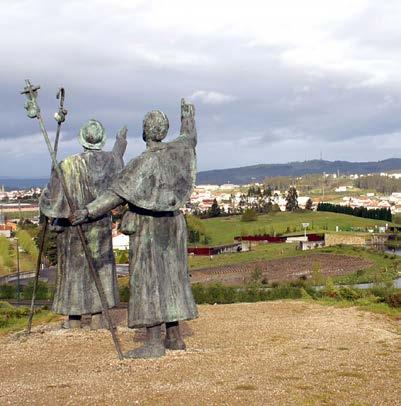

himself. At the time of Philip II, 200 monks lived in the monastery. They were in charge of the library with 40,000 books and manuscripts. It is a mausoleum of Spanish kings with only Philip V and Ferdinand VI buried elsewhere. You can also see the works of El Greco, Velasquez, Tintoretto, Titian and Veronese.
It takes an hour to get to El Escorial from Madrid.
The palace and monastery are open Tuesday-Sunday from 10.00 am - 20.00 pm. Closed Mondays. Tickets: 10 €
Al-Mansur and its door and bells moved to the mosque. The temple was rebuilt in the 11th century and has become a symbol of fighting against Muslims.
The cathedral is open every day from 07.00-20.30. Entrance is free except for the museum space, which costs 6 €.
COMMENT
53 VOYAGER 7/2017
Tour the roof of the cathedral and the seal of the saints for 12 €.
THE ROYAL FAMILY OF SPAIN

 TEA GVASALIA
TEA GVASALIA
"I am sorry. This was a mistake. It will not happen again " Like a misbehaved child, King of Spain Juan Carlos apologized to his people in 2012 after being hospitalized for a hip injury. Before we find out what happened and why the monarch left the throne to his son Felipe two years after this event, let’s look over the history of the Spanish Bourbons.
The first Bourbon king, who replaced childless Habsburg king Carlos II on the Spanish throne, was Philip, Duke d’Anjou, the grandson of French King Louis XIV. He was named Felipe V in 1700. He had mental problems, suffering from what was called "black melancholy", and in 1724 he passed the throne to his 16-year-old son, Luis. The boy died six months later, and Felipe was forced to reign for another 22 years.
The next Bourbon, Fernando VI was a soft, sensitive king. He married Barbara Braganza, the daughter of the Portuguese king and died soon after her death.
In the following years, Spain was ruled by Carlos III and Carlos IV, Joseph Bonapar-
te and Fernando VI. The latter had four wives and only the last one gave birth, a daughter born in 1833 who became Queen Isabel. The queen married her cousin Francisco de Asis, declared him a homosexual and impotent and raised 12 children by numerous lovers.
In 1878, much earlier than in Russia, the October Revolution took place in Spain. Isabel resigned, passing the throne to her son Alfonso XII and fled the country. The young king died of tuberculosis at the age of 28. His son, Alfonso XIII, was young, so a regent ruler was assigned.
Revolution hung in the air when the adult Alfonso was crowned. Anarchists had killed four prime ministers. Spain
His Majesty King Felipe VI of Bourbon and Greece
HISTORY 54 VOYAGER 7/2017
Queen Letizia of Spain and King Felipe VI
had lost Cuba and the Philippines, which had detracted from its political image, economy and national pride. All of this was accompanied by Alfonso’s family problems. His wife was a grandaugther of Queen Victoria of England. Queen Victoria Eugenia passed hemophilia to three of their five sons; the fourth – Jaime was born deaf, and only one of them, the Duke of Barcelona, was healthy.
Alfonso had hearing problems as well. He could not tell melodies apart, so he always brought a servant whose only duty was to give the king a sign that the Spanish anthem was being played, so that the king could rise.
Alfonso was overthrown in 1931 when the Republican government came to power. Prior to that, in 1920, Madrid's football club was named Real Madrid, meaning ‘royal’, by Alfonso XI.
Portugal sheltered the royal family, and civil war broke out in Spain. It ended with the defeat of the Republicans. Francesco Franco came to power and held a referendum in 1947 in which 95% of the population supported the restoration of the monarchy. Franco ignored Alfonso’s son Juan and brought his son Juan Carlos to the country. Juan Carlos had to attend military university, the University of Madrid, and then marry someone of stature.

At a royal party, Juan Carlos was introduced to Sofia, daughter of the Greek king. It was not love at first sight. At that time, Sophia liked Harlard, Prince of Norway, who rejected her and married a simple Norwegian girl. Juan Carlos was not very excited about marrying the princess either, though their marriage took place regardless, according to Catholic and Orthodox rule. They had three children - Elena, Cristina and Felipe.



throne.
Queen Sofia is one of the most distinguished members of the Spanish Royal Family. Besides Spanish and Greek, she speaks English, French, Italian, Portuguese and German fluently. She has published two books about Greek archeology, knows music very well and has a good voice.

After Franco's death in 1975, Juan Carlos took over the Spanish
Francesco Franco and Juan Carlos
Coronation of Juan Carlos
King Juan Carlos and Queen Sofia Wedding
55 VOYAGER 7/2017
King Juan Carlos, Queen Sofia, InfantasElena and Cristina, Prince Felipe
According to the Spanish Constitution, the king is the head of the country. The king approves the laws adopted by the Cortes (parliament), but he has no right to initiate laws or veto them. The king announces elections. With the agreement with the government, he has the right to dissolve parliament.

He has the right to propose or dismiss candidates for the chairmanship of the Cortes. He appoints or dismisses the members of the government proposed by the Cortes. The king appoints Spanish ambassadors, and he has the constitutional right to start or end a war.
Queen Sofia is one of the distinguished members of the Spanish Royal Family. Besides Spanish and Greek, she speaks English, French, Italian, Portuguese and German fluently. She has published two books about Greek archeology, knows music very well and has a good voice.
Donia Sophia was chosen as an honorary academician of the Royal Academy of History and Art of Spain. Cambridge, Oxford, Georgetown and New York universities have awarded her honorary doctorates. Spain houses her foundation and museum. The latter is located near the Prado museum and I recommend visiting it. The Reina Sofia museum primarily exhibits artists of the XX-XXI centuries.
THE YOUNG MONARCH DISTINGUISHED HIMSELF TWICE. IN 1981, WHEN THE MILITARY STAGED A COUP IN THE SPANISH PARLIAMENT, THE KING APPEARED ON TELEVISION AND URGED THE POPULATION NOT TO SUBMIT TO THE MILITARY DICTATORSHIP. THEN, IN CHILE IN 2007, WHEN DURING THE IBERO-AMERICAN SUMMIT THE PRESIDENT OF VENEZUELA HUGO CHAVEZ INTERRUPTED PRIME MINISTER JOSÉ LUIS RODRÍGUEZ ZAPATERO’S ADDRESS, JUAN CARLOS TURNED TO HUGO CHAVEZ AND PUBLICLY TOLD HIM TO SHUT UP.
Juan Carlos was not a model husband. Everyone acknowledged this except Queen Sophia, who cared for her family reputation. However, her patience ended in 2012.
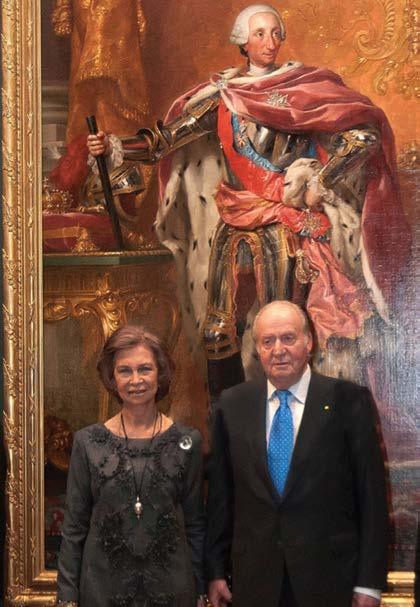
After an operation, the king went on a private visit to Botswana, where he went hunting and was photographed with a slain elephant. In addition to animal rights activists, ordinary Spaniards were upset as well. They calculated that the king's two-week holiday in Botswana had cost the country 55,000 dollars. The population of a country in crisis perceived this as a deadly insult. To add insult to injury, it turned out that the king was accompanied by his mistress Corinna Sayn-Wittgenstein, who is 28 years younger than him.
The image of the Monarch was destroyed along with the slain elephant. After returning from Botswana, he underwent surgery several times, publicly apologized and soon resigned.
In 2014, his son, Felipe the Sixth, took the throne. He has also received military education in his time, as well as attending Georgetown University in Washington. Felipe married former TV presenter Letizia Ortiz and has two daughters - Leonor and Sophie.
The last scandal around the royal court of Spain involved the husband of Juan Carlos's daughter Infanta Cristina, former handball player of Basque origin Iñaki Urdangarin. He was accused of corruption and misappropriation of state funds.
HISTORY
56 VOYAGER 7/2017
King Juan Carlos and Queen Sofia

An elegant building, with a pine forest rustling behind it, is full of surprises. An energetic man with a camera wanders around a bamboo garden illuminated by sun in a bright and transparent space. The street noise does not penetrate a feeling of coziness that is streaming through open doors of the rooms. The energetic man with a camera is an American designer Vicente Wolf and this bright space is his creation.
VICENTE WOLF: "The rhythm of life in the world is becoming more and more hectic. The environment is aggressive and is weighting us down with negative energy. That is why a person needs a place where he/she feels safe, comfortable and free. This place is home. "
Wolf, named among the ten most influential designers by "House Beautiful" and "Interior Design Magazine", manages to retain his relevance. Recently, he has published a new book, where has split examples of his light, eclectic and clear designs in 4 parts.


V. W. "I love to be inspired through the objects connected with the four elements. I have divided by new book to the respective chapters: - water, air, fire and earth. I consider important to include the colors and structures associated with this elements in my the design. The projects that I have created for the “Tbilisi Gardens” are filled with these elements. "
The New York designer is working on a new project in Tbilisi. All the strokes inherent to Vincente Wolf’s design are at the disposal of the residents of "Tbilisi Gardens".
V. W. "The interior is bright and sunny, saturated with natural materials; at the same time, the feeling of space present. We've used glass to decorate the bathrooms, I like its water-like color ".
 THE " TBILISI GARDENS" COMPLEX WILL BE UNIQUE AT LEAST DUE TO THE VAST GARDEN SURROUNDING IT. BELIEVE ME, THIS IS THE THE GREATEST LUXURY IN THE WHOLE WORLD. "
THE " TBILISI GARDENS" COMPLEX WILL BE UNIQUE AT LEAST DUE TO THE VAST GARDEN SURROUNDING IT. BELIEVE ME, THIS IS THE THE GREATEST LUXURY IN THE WHOLE WORLD. "
"MANAGE TO STAY INTERESTING, CONTINUOUSLY AND ALWAYS”
Advertorial
"Tbilisi Gardens" is trying to create a cozy and warm house. Residents will easily rest from the problems of the outside world. The bright terraces, where one can enjoy the view of the large part of Tbilisi, its own swimming pool and fitness center, kindergarten and event hall shape a truly unique living experience.
Vincente Wolf finds his inspiration in travel. Every new country is a new beginning for him. In all of his interiors, he manages to combine old items with their history and the cutting edge technologies and materials.
V. W. "Nowadays it is necessary to use the new materials. The new design ideas are often rooted in them. Currently there are new high-tech materials, very similar to natural, though simpler to maintain. I love to create items that are not for a single use. The whole world is infected with consumerism nowadays. I love you when I find and item that has hours of someone’s personal work invested in it and you can feel their energy in this item. I personally do all of my drawings by hand. I enjoy this process. I also love and have always loved to review the works of the designers for the last decades. Sadly, some, due to their ignorance, think that they have created something. At this time you can look through the history and find that someone had already come up with it. You can take this idea and transform it in your own way".
His works prove that nothing is impossible for him. He often works with clients who have large collections of works of art and antiqueties. Despite many dominant objects in the interior, there is always a lot of air in the space created by Wolf.

Vincente Wolf has long acquired the name as an innovative designer who is capable of creating modern interior which will not be cold and empty, but rather filled with human energy.

Wolf is able to create an interior full of details without overloading the space. This is his inherent talent.


V. W. "I can work with any customer. I love my clients, I still keep contact with the the lady who ordered me my first interior design. The only case when I decline the order is when I see that the clients do not know what they want. I could not bear such a headache "(laughs).
Vincente Wolf is a New Yorker, and you can see it on him. He likes to discuss politics. He instantly notices interesting details and happily gets to know new people. These traits of his are reflected in his interiors.
V.W. "Basically, I have lived the American dream. My parents are Cubans, the have escaped the Castro regime and despite the fact that they had their own business in Cuba, they had to start from scratch. This country gave me everything. It could be that if I had started my career with the same conditions today, I wouldn’t have achieved this. I turned up in a right place on a right time. Imagine a dyslexic kid, a child of immigrants, a young man with no decent education… I appeared, with my works directly on a cover of a magazine. "
Maybe an initial success of a novice designer was really a stroke of luck, but he achieved continual success with hard work and curiosity. Vincente Wolf has not slowed down a minute and when I ask him the secret of permanent success today, when the whole world is shaking, he thoughtlessly answers: "Manage to stay interesting, continuously and always."
WHEN THE WEATHER TURNS
BAD
AKA MORCHILADZE
“What are you eating, Lazarus?” – this is not a rhetorical question, and some time ago every Georgian would have known what it meant. It comes from a story about a poor nobleman who tried to calm his hunger-stricken belly with a piece of meat that his pauper servant-boy obtained.

For me, there was a time when Don Quixote was not the book one read to get acquainted with Spain. Don Quixote was for later. The first one was “The Life of Lazarillo de Tormes and of His Fortunes and Adversities” – the best gift for any teenager.
To tell you the truth, I don’t really know why there were several publications of “Life of Lazarillo” in Georgia. It was first translated by Petre Umilkashvili. The book was very popular at that time and a wonderful Georgian film was based on it. The dialogue and phrases in the film were exchanged harmoniously.
I would not go so far as to claim that “Lazarillo” was popular during the communist period chiefly due to its anti-clerical theme. Yes, that could be one of the reasons, though many books were written about the Spanish Inquisition, describing
LITERATURE
60 VOYAGER 7/2017
Spain and its medieval severity, written in different centuries and translated in the Soviet Union hundreds of years later, such as Diego Quevedo’s “Don Pablos”. “Lazarillo” was published in the nineteenth century when communists were not yet called communists and they held meetings underground rather than in big halls.
Anyway, this book was frequently the first channel through which Georgian citizens became acquainted with Spain. The most remarkable thing about it was not perhaps its unrefined humor but the contagious joy that poor Lazarillo described in his story. I did not pay attention to the fact that the book had no author on the cover. As the novel was published in three cities simultaneously, the author refrained from putting his name on such an anti-clerical work: this was the century of Felipe II, persecution, torture and punishment. I did not pay attention to the other fact that “Lazarillo” was not published for a second time until 300 years later. It was republished in Spain that was burdened with prohibition; the whole of Europe laughed as they had all been publishing and reading it for 300 years.
The joy starts from the very first word and is so natural that you’d think that Spain was endlessly joyful, despite the wretched stories described in the novel. They say now that the book was written by a famous poet, the nobleman Diego Urtrado de Mendosa, though I pay less attention to the origin. “Lazarillo’s Life” is a kind of book that makes a leap right to Bunuel. Although we love more eye-catching Spanish literature, in some way it all started with “The Life of Lazarillo de Tormes and of His Fortunes and Adversities”.
The energy of this simple book is so great that it reflects even those notions of Spanish literature that it tries to oppose. Sometimes getting so deep into the subject is rather out of place and needs special mastery, especially since Spain is the homeland of Velasquez and Cervantes. But if there is anything we can call a Spanish soul, then it is Lazarillo’s undefinable joy.
This joy makes you forget the perils that great Spanish artists experienced while creating their grand paintings; it makes you forget that landscape painting was prohibited before El Greco painted the view of Toledo with its stormy, heavy sky. He changed the city’s view and included fearful expectations in the old and immovable painting of the city and showed us the misfortunes of Lazarillo’s Spain.
I believe that this is the real bounty to be had from Spain – the joyful book on your table and the landscape on your wall. Two Spains, both real, both of the same time – the Spain of the Battle of Lepanto, the sinking of the Armada, Filipe II who persecuted everyone he could, and Lupe de Vega. This is Spain – forever mired in conflict and always heading for destruction.
This is also the time of Cervantes – a pauper whose hand was injured in the war against the Moors. As if the author had no doubt that his book would hold all the kindness and misfortune, all the honor and dishonor and would eternally establish necessity of a doomed yearning.
Cervantes was completely unappreciated in his own time. He was never respected as a playwright; rather he was a soldier dependent on his pension and tortured yet still powerful; he was a person with a rich understanding of the world. He had views so alien and different from those of our time. His views have now turned into a Spanish passport to the world and the world’s passport for itself. It is very difficult to be Don Quixote.
It is very difficult to be Cervantes but this book and its author are the best examples of what has and has not defeated the human soul. Those two are the same, like Spain, both joyful and stern as described by the grand artists. Know Don Quixote and know yourself – that’s what it’s like. Spain consists of things that are difficult to define and those things are souls of hardship and power encouraged by joy.
This is how it is in Don Quixote: there is no bad book that does not contain at least one good thing. The good bits give away so much… Lazarillo and Toledo waiting for the storm is enough to cover up the bad part of the book. Spain and books is another issue altogether, spanning two centuries after Don Quixote.

Spain was in fashion in the 1920s, not only due to the multitude of old masters nor because of its genius new artists of expressionism and surrealism but Spain as a whole.
Special people walked the streets of the country, looking for “another soul”. People went to see different sides to Spain, just like people now visit Tibet and Nepal.
This world was completely different from Europe at the time. It captivated visitors – corridas, exotic drinks, tapas, fierce women who are ready to die or kill for you, Carmen’s soul, bull fighters’ souls and thousands more. Many creative people flocked to Spain.
Ernest Hemingway was among those visitors – a man famous on both sides of the Atlantic, and perhaps as famous as David Beckham in his day if not more so. He was a river-like writer who danced in front of the bulls in Pamplona, and was also a womanizer and a drinker.
He wrote about Spain and how he fought for the Left and for his friends; he did not visit Spain for 20 years after the defeat until all of his friends were freed from prison.
He wrote two novels about Spain in the 1920-30s, several wonderful short stories which bore Spain’s soul, and a later book about toreros. A dangerous summer and a feeling of longing that lasts one’s whole life – this was the Spain that Hemingway gave to the world. Millions fell in love with it, copying the writer.
Contemporary Spain is no longer a place of secrets but a place of dreams. Hemingway has been dead for 60 years but his Spain follows you everywhere; it helps you and it is close to reality.
Hemingway or not, this is the land for the soul and it is never too late to partake of it.
61 VOYAGER 7/2017
DON JUAN
… A LIBERTINE, WOMANIZER, DEVIL’S ADVOCATE, LIAR, BLASPHEMER – DON JUAN DE MARANA, DON JUAN TENORIO, DON GUAN, DON GIOVANNI… ALL OF THIS, THE SAME MAN, OR DIFFERENT MEN, UNITED BY CULTURE UNDER ONE CHARACTER – DON JUAN … AN AMORAL (OR IMMORAL) SPANISH ARISTOCRAT…
Who is this Don Juan? Where did he come from?
Here is the scoundrel’s curriculum vitae:
Place of origin – Spain.
Place of birth – Seville.
Origin – Aristocracy (which he does not care for in general).
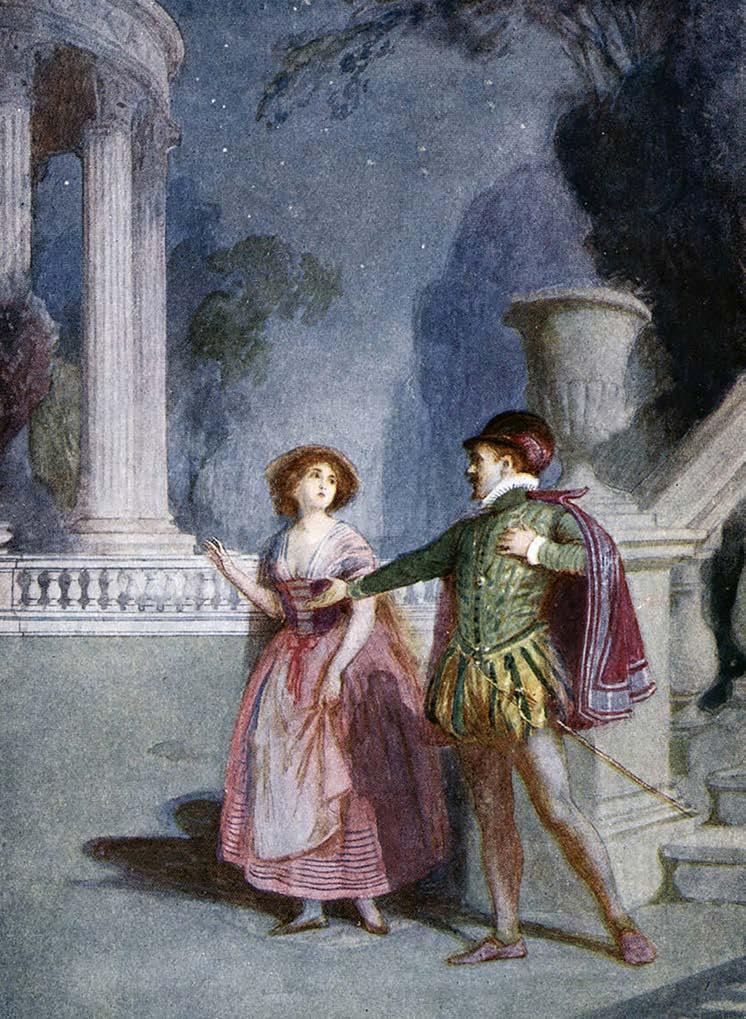
Moral belief – Non-existent in terms of sexuality.
Psycho-emotional state – Affective and caring lover ... but only for one night, or 24 hours at the most.
Age – From 25 to 33 years
Religious views – None. He is a cynical atheist and remains as such, even when a stone sculpture leaves its pedestal to join him at his last dinner.
STORY
LASHA BUGHADZE
62 VOYAGER 7/2017
The geographical quantity of the Beloved Women, according to the famous list of his servant Leporello (his aria from Mozart’s Don Giovanni, "Madamina, il catalogo questo ...") in Italy - 640, in Germany - 231, in France - 100, in Turkey - 91, and in Spain1003.
Aesthetic preferences – according to the same Leporello, he likes brunettes, as well as blonds, slim, as well as those on the plumper side, miniature and forbidding, the elite-aristocratic and working class-peasant, manically hygienic and perversely untidy, married and single, socially active and those that shun away from social life (for example, nuns, whom he has stolen away from monasteries from time to time).
The crime list (according to the norms and ethics of the period): formal and ironic attitude towards marriage, having two, three, five and ten wives simultaneously (and remaining formally a Christian); declaring freedom (including, of course, freedom from morals) as the main virtue; arrogant attitude towards "the high-born of this world" and the clergy; "indecent behavior" and disrespect towards the dead in the cemetery; an excessive desire towards the living body; murder of the old commendatore in an unequal fight (the poor, old man woke up and attempted to rescue his daughter Donna Anna from the masked Don Juan sneaking into her bedroom); attempting to incline a beggar to heretic temptation (according to Moliere's "Don Juan": "I will give you money and you denounce God"); ridiculing and deceiving his parents… here he is reminiscent of a later co-Spaniard Salvador Dali, who insulted his parents with a painting "Sometimes I spit on my mother's portrait ".
The "Electra complex" - the desire to punish the mother, as Freud used to say ... Nobody writes anything about Don Juan’s childhood – tales about him begin with his puberty, hence nobody knows if the young Sevillean was deprived of his mother’s love.
Permanent life companion – paradoxically, this is a man, not a woman. His servant, called Sganarelle according to Moliere or Leoporello according to Mozart, is a caricature of Don Juan himself, as Sancho Panza is a parody of Don Quixote. Sganarelle-Leoporello is a moralist; as he is not as talented or lucky as Don Juan. He therefore loves to preach. Only once does he get lucky, and that is when he is dressed as Don Juan. In reality, he is a materialist, not a moralist. The only thing he cries after his former master for when the stone commander drags Don Juan down to Hell is: "My salary, my salary!"
The most notable chronologists of Don Juan’s biography is Tirso de Molina, a playwright. His play depicts Don Juan stating for the first time that he does not care what people say about his actions. He lives by passion and not by morals.
Jean Baptiste Molière – a playwright. Here “the right to free sex” is not an expression of Dun Juan’s passion but his philosophy. Moliere’s Don Juan stands above the moral-abiding society. Others secretly sin but openly moralize but Don Juan,
unlike them, hides nothing and does not moralize. The cardinal of Paris banned Moliere’s Don Juan. Due to this play and “Tartuffe”, the church refused to perform burial rituals for the playwright who died in the theater; he was buried secretly, at night, outside of the Paris city walls, like an unforgivable sinner…
George Gordon Byron – the lame poet (like Nikoloz Baratashvili). His Don Juan falls in love with a “Megrelian Woman” … despite his many lovers, this woman is still the best.
Wolfgang Amadeus Mozart / Lorenzo da Ponte – a composer and a librettist. The “Don Giovanni” created by these two is more Venetian than Sevillean as the author of the libretto was Venetian (Abbate da Ponte). They say that while composing this opera, Mozart met with the most famous Don Juan of the 18th century in Prague, who was also a Venetian, albeit already in his old age. It may be that Mozart “copied” the character of his “merry” drama - dramma giocoso - from that man, Giacomo Casanova.
Ernst Theodor Amadeus Hoffmann – a writer and musician. In Hoffman’s short story, Don Juan, given immortality as his punishment, learns of his death from the music of Mozart’s “Don Giovanni”. Hoffmann’s Don Juan is the Ahasver, or Wandering Jew, bearing the curse of eternal desire.
Alexander Pushkin – a poet. His Don Juan falls in love with Lady Anna for a relatively long time … in any case, longer than twenty-four hours. This very fact becomes the cause of his death. However, in Pushkin’s poem, Don Juan calls out his beloved’s name before his death; in other stories, he either calls out “I will not repent” or “oh, I’m burning…”
Prosper Merimée – a writer. “ Souls of Purgatory”. According to Merimée, Don Juan does not die but is awakened by a gloomy vision – he watches his funeral and his decaying body in a coffin … and frightened, joins a monastery. Merimée intrudes onto Dostoevsky’s territory: from crime to sanctity - if Thomas Mann was to finish this text, Don Juan may have been elected as Pope in the end (Thomas Mann “The Holy Sinner”).
Max Frisch – a writer. His Don Juan is more attracted to geometry than to women. Or definitely the shape and not the content…
And the last Peter Handke – a writer. Handke’s Don Juan arrives in the Georgian capital of Tbilisi and steals a bride from her wedding. The Georgian woman is probably taken to Europe, but this is another story, possibly similar to “Medea”…
All in all, Don Juan is the most “cited” and popular character after Medea.
He’s hated but still attracts many.
Though to this day nobody can say what the secret is that he bears that makes us all talk about him so much.
63 VOYAGER 7/2017
ARCHITECTURE THE BILBAO EFFECT

THE CITY
The economic crisis was raging across Europe. A scattered landscape appeared after the dust had settled on the collapse of the coal industry. Many cities were left down on their luck in a hungry and grimy desert. Amidst this despair, the mayor of one French city was asked: "What are we to do when we all are in this dire state? - What we should do is order champagne !!!”
I want to start my story of Bilbao with this famous aphorism. Bilbao as the city and Bilbao as the creator of the "economic effect". The effect that justified the above aphorism, that in desperate situations, rather than give in to anguish and cry, it is always better to take control and improve your situation with an extraordinary decision.
What was Bilbao before the Guggenheim Museum – the capital of the Basque Country? A sea port? A train stop on the way to the wonderful San Sebastian bay? In my opinion, just a place where “the steel was tempered”. The architecture of Bilbao itself has a "steel-colored" tint to it. The houses reflect the daily life of the
shipbuilders that even Art Nouveau could not soften. I have never seen such sturdy Art Noveau anywhere.
There was an attempt at the end of the 19th century, to transfer the Barcelona model to Bilbao, through “Ensanches” of Ildefons Cerdà. The "Ensanches" are the Barcelonan blocks in a rectangular form with chamfered corners and an inner yard. The attempt failed.
In the 1990s, the heads of the town decided to improve the situation. The strict and gloomy city deserved it. It deserved to be improved, modernized, and to have something special – something that had not been there before.
They believed that a new landmark would turn the city around through its visual exterior and inner content. Moreover, the manufacturing industry was in crisis and there was an urgent need to grow the tourism service industry.
They followed the examples of other big cities. They liked the
64 VOYAGER 7/2017
NIKA CHKHAIDZE
FRANK GEHRY'S ARCHITECTURE
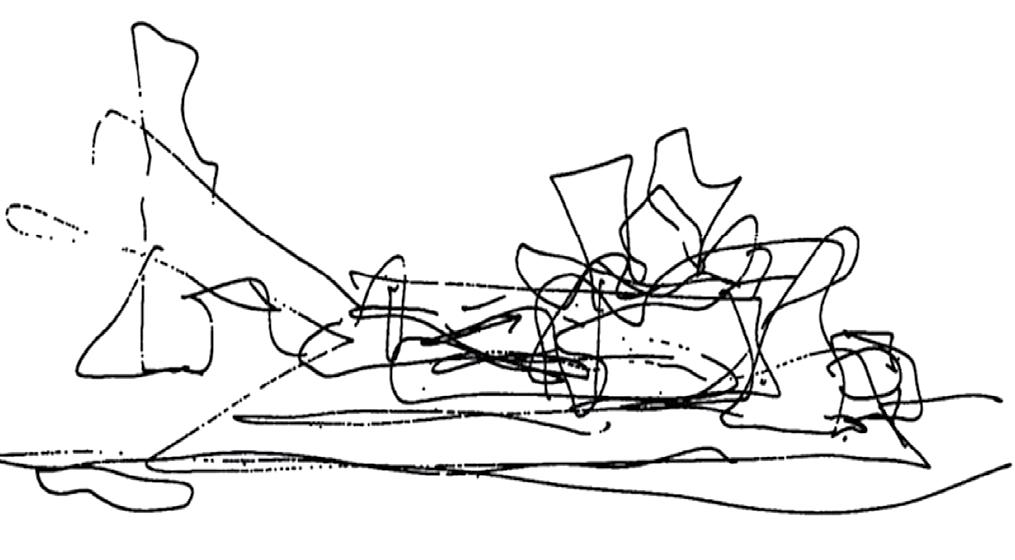

LOOKS LIKE THE EXECUTION OF AN ABSTRACT SKETCH IN REAL SPACE. AT FIRST GLANCE, IT’S A SOLUTION OF INCOMPREHENSIBLE PROBLEMS. ALL OF THE BUILDINGS SEEM TO BE MOLDED AS A SINGLE OBJECT, WHILE COMPOSITIONALLY IT’S BORDERING ON THE ABSURD.
case of New York and the Guggenheim Museum. The revolutionary building, built by Frank Lloyd Wright, is truly one of the main landmarks of New York and is one of the main centers of modern art as an institution. The two ideas match each other - the content and the architecture.
They reached out to the Guggenheim foundation, with no high hopes; to their surprise the Guggenheim foundation agreed to cooperate. The foundation was ready to cover part of the funding and, what is more important, to include the future museum in its collection circulation network.

65 VOYAGER 7/2017
THE ARCHITECT
It was time to select an architect. Like in the case of the New York Guggenheim, they needed a well- known architect with a distinctive style – one of the same stature as Frank Lloyd Wright.
Frank Gehry, an American architect, working in Los Angeles, was an exact match. His style and the buildings he created were hard to pin down or give any certain name.
Despite being called a deconstructivist or several other things, he does not align himself with any movement or style.
His architecture seems like an execution of an abstract sketch in open space. At first glance, it’s a solution of incomprehensible problems. All of the buildings seem to be molded as a single object, while compositionally it’s bordering on the absurd.
This, of course, was made possible through special software.
The architect had access to a program used in aeronautics, which gave him the ability to model and implement this type of structure.
THE BUILDING
A German art critic wrote of the the Bilbao Guggenheim building:

"THE BUILDING LOOKS LIKE AN ALIEN SPACESHIP, AS IF IT HAD ARRIVED FROM OTHER PLANET AND LANDED ON THE BANKS OF THE NERVION RIVER. HOWEVER, THE BUILDING FEELS LIKE IT HAS BEEN STANDING HERE FOR CENTURIES, ROOTING ITSELF INTO THE CITY. AS IF THIS SHIP, CLAD IN TITANIUM HAD LANDED HERE CENTURIES AGO AND SLOWLY IMBUED ITSELF INTO THE CITY, ITS STREETS, BRIDGES AND LANDSCAPE."
One is filled with a truly wonderful feeling when looking at the building. The facade is decorated with titanium tiles reflecting the magnificent history of shipbuilding in the city. Placed on an esplanade away from the city center, it flows down to the river bank in horizontal waves. One can recognize everything in the shapes
ARCHITECTURE 66 VOYAGER 7/2017
– a ship, a fish, waves. The interior is filled with marvelous atriums and "openings". The panoramic landscapes of the city can be seen from inside the interior. Moving through the exhibition spaces, one experiences an adventure with involving shapes, lighting, textures and colors.

FINALLY THE NUMBERS: THE MUSEUM HAS HAD A SIGNIFICANT IMPACT ON THE ECONOMY OF THE CITY, GIVING BIRTH TO THE CATCHPHRASE "THE BILBAO PHENOMENON". IN THREE YEARS, THE CITY’S INCOME SIGNIFICANTLY SURPASSED ITS INVESTMENTS. DURING THIS PERIOD, THE MUSEUM HOSTED 4 MILLION VISITORS, CREATED 4,415 NEW JOBS AND EARNED 500 MILLION EUROS.
EVERY YEAR, THE BASQUE REGION RECEIVED 30 MILLION EUROS.; VISITORS TO THE MUSEUM SPEND 100 MILLION EUROS ON HOTELS, DINING AND SHOPPING.

THE MUSEUM
The Bilbao Guggenheim Museum is noteworthy for its magnificent collection of contemporary art, housed in the 11,000 square meter exhibition space.


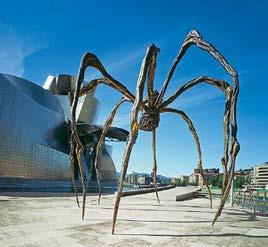


A floral “Puppy” by Jeff Koons sits at its entrance. Nearby, an enormous, alien-looking spider by Louise Bourgeois, lovingly named “Mommy”, is holding onto the floor on its towering legs. Shining under the sun is a large sculptural composition made of silver balls - "High tree and the eye" by Anish Kapoor. Take a few steps and you will be embodied in Fujiko Nakaya's mist sculpture ... And all this awaits you before you even enter the museum. This is why this space is always lively and filled with people.
The collection, which awaits you in the museum, is no less impressive: Basquiat, Andy Warhol, Anselm Kiefe, Rothko, and controversial and revolutionary art of XX and XXI century, which traditionally raises more questions than it gives answers.
Everybody starts their visit at the exhibition of Richard Serra's sculptural installations - "The Matter of Time". One truly loses sense of space and time when walking through the rusty metal curves. Losing theses senses is easy in this outstanding museum, where the art vibrates with thousands of emotions.
The museum is open from 10.00 to 20.00. Closed on Mondays, except January 2, April 10 and 17, May 1, every Monday in July-August, September 4 and 11 and December 4.
Admission fee: 10 €
Avenida Abandoibarra 2
67 VOYAGER 7/2017
TWO DREAMS
LASHA BUGADZE
quickly drafted. In several days and nights. Both of them were poor and unable to obtain money for the film. Fellow surrealists and actors helped them translate their dreams into the most unusual film in the history of film (and culture in general).
Luis Bunuel tells us that surrealists—admirers of categorical appraisal and scandal—like to pose simple questions such as “do I feel love?” They express their sympathy or antipathy without arguments or logic.
For example, Bunuel claimed: “I don’t like Borges, because he is obsessed with getting a Nobel Prize. At the same time, I am deaf and as a deaf person, I hate all blind people. Borges is blind. I love Sartre because he refuses prizes”; “I love rain, since rains create great civilizations”; “I don’t like music in movies, I have used music only twice: in my first film, ‘An Andalusian Dog’ and in the last film ‘That Obscure Object of Desire’. Both times it was Wagner.”
Bunuel mentioned Salvador Dali, his old friend, who also used to be a surrealist but was later cast away from the surrealists due to his sympathies towards General Franco. Dali’s answer was: “Where can they cast me away from? I am Surrealism”.
Old Bunuel was not friends with Dali, but Spain, surrealism and two dreams have tied them together forever.
In 1929 they created perhaps the most famous surrealistic film ‘An Andalusian Dog’. Bunuel later thought that Dali became a glamorous and scandalous artist and used surrealism only as an aesthetic advertisement; meaning that Dali had denied surrealistic ideals. Bunuel thought of himself as a loyal disciple of Surrealism.
Whatever the truth is, the cinematographic history of surrealism began with dreams of the two eccentric geniuses: Dali saw in a dream how somebody’s eye/egg yolk was cut up with a razor, while Bunuel dreamed of a hand stuck in a door and covered with ants (or was it vice versa, did Dali see this instead? does that even matter?!). This nightmarish-allegoric dream created many “illogical” and “irrational” images and the screenplay was
“An Andalusian Dog” turned surrealism into the best “ism”…and more importantly, it turned it into a scandalous psychological and aesthetic event, something that even the most scandalous surrealists could not dream of.
Elderly Bunuel recalled with nostalgia the times when “good surrealistic scandal” was possible – for example, running into a theatre and starting a fight or burning down an opera building or a library… “Gone are such spontaneous and crazy scandals!”
He could not forgive Dali for losing this spontaneity; Dali turned surrealistic philosophy into a source of income. There was a time when Dali’s youthful scandals were born out of his natural, scandalous self; “he turned scandal into a marketing piece…”

Bunuel believed that the “late” Dali was horribly artificial, a gifted and elite showman, who did everything to be shockingly original. Bunuel thought that Dali’s pragmatic wife, Galina Diakonova, was the reason for Dali’s transformation. Dali called her Gala, stressing the last letter. This Galina was an awful woman and Bunuel wanted to strangle her. The passionate Spaniard was very annoyed by a woman who at the same time was Paul Eluard’s wife, Salvador Dali’s “mother-lover” (Freud was Bunuel-Dali’s favorite) and also lover of several others…
“Can’t you see that she is messing you up?!” Bunuel told Dali. She did not mess him up. Gala created Dali who had to sell graphic silhouettes depicted on napkins for millions, Dali who walked in the streets of Paris with an anteater on a golden leash and played with his legendary moustache in chocolate TV commercials... Gala’s lovers are part of another story. Dali did not even hide the fact that he chose lovers for his wife (he was 10 years younger than Gala). When Gala moved away from Dali to the palace bought especially for her (or her passion; Wagnerian Bunuel called it “Venus grotto”), her genius husband was allowed to visit the place only after receiving a written notification “please come, I have a free evening”.
68 VOYAGER 7/2017
“I am happy that my wife has lovers” said Dali. “I am turned on by it”.
Evil journalists called it “an impotent originality”. Dali turned this life story into a super-scandalous episode. In the end, he was left alone - Gala died. His famous cat died as well (nobody knows the fate of the anteater).
This is when he contacted his oldest friend, Luis Bunuel, and half a century after ‘An Andalusian Dog’ tried to tell him about “yet another unusual dream”.
“Let’s shoot a sequel to ‘An Andalusian Dog’” he said. “A second part…we both need it, we will revive the Surrealistic movement…”
Bunuel refused, saying that he was deaf and old and that he smelled kitsch. Dali was surprised:
“Did you get that old?!” he asked, no, yelled (not because he was angry but due to Bunuel’s hearing problem). “Are you afraid of scandals?”
"What?”
“Scandals…”
“I can’t hear you.”
“Scandals!”
Their dialogue was impossible. The story was over.
Dali was unable to tell of his new dream, Bunuel was not going to say anything.
They never talked afterwards.
Dali returned to his brilliant loneliness, Bunuel to his memories and old surrealistic game, an old questionnaire, where he recorded very categorically:
“I love young and wide-eyed Dali, the most gifted and crazy person that I have ever met in my life”.
Inaugurated in 1974, the Dalí Theatre-Museum rises on the remains of the former Municipal Theatre of Figueres and is considered to be the last great work of Salvador Dalí. Everything in it was conceived and designed by the artist so as to offer visitors a real experience and draw them into his unique and captivating world. A visit to the museum is a unique experience, allowing visitors to experience and enjoy the genius’s works and thoughts.
The various collections of the Gala-Salvador Dalí Foundation include all types of works of art: paintings, drawings, sculptures, engravings, installations, holograms, stereoscopes, photography, etc. Among them 1,500 works are exhibited at the Dalí Theatre-Museum of Figueres.
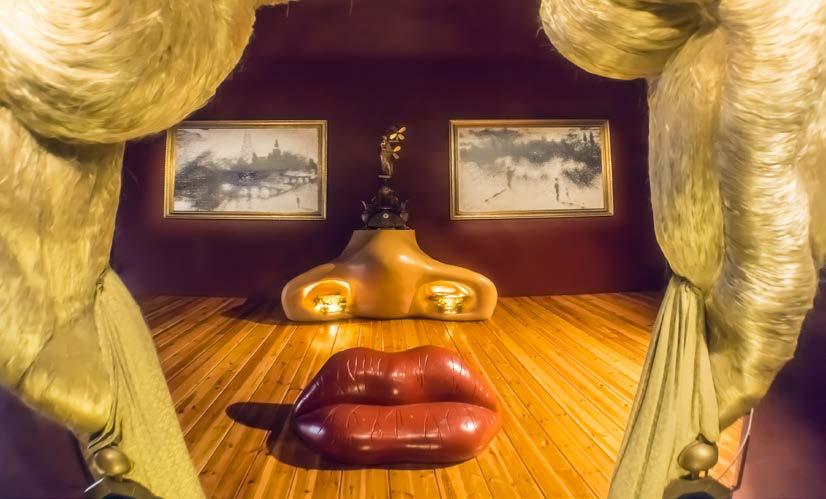 Plaça Gala i Salvador Dalí, 5, 17600 Figueres, Girona, Spain
Plaça Gala i Salvador Dalí, 5, 17600 Figueres, Girona, Spain
69 VOYAGER 7/2017
DALÍ THEATRE-MUSEUM
ALMADOVARLAND
SANDRO JANDIERI
Exterior. Suburbs of Madrid – 1970. Night time. Laborers are putting up Christmas decorations, ornaments and snowflakes. A woman’s scream pierces the Christmas setting. An elderly woman helps a young lady who is lying on a bed. The landlady (Pilar Bardem) takes the young woman (Penelope Cruz) outside. She tries in vain to stop the cars that seldom pass in the empty Christmas streets. After several futile attempts, the hostess makes a brave attempt to stop a bus that is heading towards the garage by standing in front of the vehicle.
The bus driver is forced to stop. The conversation that follows is easy to understand without subtitles: angry phrases, fighting in a Spanish character. The bus driver finally agrees to take the pregnant young woman to the hospital, though Isabel never makes it there – her water breaks in the bus. There is no other way, so the landlady roll up her sleeves: “Empujar, Empujar, muy buen, respirar!” (“push, push, good, breath”). This interesting lady, who was watching a Christmas show just minutes before, is now covered in blood, helping Isabel give birth. The bus stops again,
CINEMA
70 VOYAGER 7/2017
allowing us to focus on the moment. The bus driver, an accidental witness of this event, becomes the newborn’s godfather. In the next scene, we see that the bus stopped right under the Christmas decorations that were put up at the beginning of the film. Once again we are reminded that it is Christmas. However, that may be redundant now the birthing is over. The bus moves on, revealing graffiti painted in the style of the famous graffiti artist of the 1970s, Juan Carlos Arguelo – “Liberdad”, written clearly on the dark wall.
This is the opening scene of Pedro Almadovar’s 1997 film “Live Flesh”. The 48-year-old Spanish director was very productive, producing at least two films a year. “Live Flesh” marked the beginning of his ascent. “Everything About My Mother” (1999) received an Academy Award for Best Foreign Film. His next film, “Talk to Her” (2002), received an Oscar too for Best Screenplay. While an Oscar is not a guarantee of quality, “Talk to Her” – a film about two women in comas - is the peak of Almadovar’s work. It is a film that shows how new life is created as a result of selfless care and faith. It depicts metaphysics in film form.
Almadovar once told American journalist Charlie Rose that “Bunuel, Billy Wilder and Alfred Hitchcock are my holy trinity.” He uses Bunuel’s mysticism and somnambular anomaly, Wilder’s comedy and Hitchcock’s love for the crime genre. His characters – transvestites, transgenders, punks, goths, nuns or other deviants – are all involved in passionate psycho-sexual and amorous affairs. They wander through labyrinths where any limitations are extraneous, including limitations by the law. The rules of the games alter between rape and drugs, while murder and suicide turn into powerful story-driving tools.


Despite the fact that the generation of urban sub-culture that grew up watching those films and recognized their own mirror image in them is no longer young, Almadovar still remains the loudest, most extravagant and eccentric Spanish interpreter with a strong fan base. It is impossible to picture Pedro Almadovar’s world without Spain, just as it is impossible to picture Spanish culture without passion (pasión) and the freedom (liberdad) to express this passion.
Pedro Almadovar started filming in Madrid in the 1970s. Following Franco’s death, blood started to flow freely in 1975. New Spanish filmmaking joined the French and British New Waves. La Movida Madrileña, partly copying the New Wave, was initiated in the less prestigious districts of Madrid. This was a transition period that became the basis for the contemporary Spanish republic. La Modiva preached political and sexual freedom.
LIBERDAD UNITED THE NEW RELIGION OF HUNDREDS OF DEVIANTS. THESE DEVIANTS GOT INVOLVED IN BUILDING A NEW, DEMOCRATIC SPAIN.
71 VOYAGER 7/2017
ALMADOVAR STILL REMAINS THE LOUDEST, MOST EXTRAVAGANT AND ECCENTRIC SPANISH INTERPRETER WITH A STRONG FAN BASE
Pedro Alamdovar arrived in Madrid in 1967 from the countryside. In several years, he was right in the center of La Movida, one of its leaders and authors. The 18-year old Almadovar, with his hoopoe-hair, skinny pants, camera dangling from his shoulder and explicit sexual orientation was truly a deviant.

He was a director who dreamt of making films, took cocaine, and traveled in a white Fiat from bar to bar along with oddly-dressed libertines. At the same time, he was working for a phone company “Teleponica”, wrote screenplays in his spare time and shot his first film: “Pepi, Luci, and Bom” at the weekends. The shooting took 13 weeks; the screenplay changed according to which of his friends made it to the shooting.
“Pepi” was screened during the 1980 San Sebastian film festival. Despite its amateur shortcomings, the film that depicts women’s relations was well received. Madrid film theatres added a night screening of the film. Unexpectedly, it became financially successful. Producers reached out to Almadovar.
Pedro Almadovar often notes that he knew that cinematography would become his life as soon as he saw his first film. “This is why I was born, this is my world, I have never thought of anything else” – claimed the director in one of the interviews he gave in 2010. This faith has played an important role in his success. The word “liberdad” was heard many times as he battled with producers. He strived to protect his creative freedom.
In 1985, Pedro and his brother Augustin founded the company El Deseo. El Deseo, under Augustin’s leadership, has produced all of Almadovar’s films since “Labyrinth of Passion”. El Deseo was created to give Pero Almadovar artistic freedom. However, it adheres to certain principles that are strictly kept. For example, a film’s budget should not exceed 10 million dollars.
This poses some limitations for both the producer and the director. This is probably the reason why Almadovar’s film format is like a soap opera: the story takes place indoors with rapid successions of shots and close-ups. A paint factory cannot ex-
CINEMA
72 VOYAGER 7/2017
PEDRO ALMADOVAR OFTEN NOTES THAT HE KNEW THAT CINEMATOGRAPHY WOULD BECOME HIS LIFE AS SOON AS HE SAW HIS FIRST FILM. “THIS IS WHY I WAS BORN, THIS IS MY WORLD, I HAVE NEVER THOUGHT OF ANYTHING ELSE”.
plode in El Deseo films. They have to look for paint and colors in the diversity of characters and their conflicts and their struggle against subconscious desires, catharsis and seeking freedom from passion.
Over the years, Almadovar’s storylines have become more and more complicated. Even Almadovar fans now struggle to decipher what happens and why. “The Skin We Live In” (2011) tells us about a plastic surgeon who performed gender-reassignment surgery on a man who had raped his daughter. His goal is to create a woman out of the rapist and to make this woman his mistress. Everything is clear, right?
THEY HAVE TO LOOK FOR PAINT AND COLORS IN THE DIVERSITY OF CHARACTERS AND THEIR CONFLICTS AND THEIR STRUGGLE AGAINST SUBCONSCIOUS DESIRES, CATHARSIS AND SEEKING FREEDOM FROM PASSION.
Pedro Almadovar’s last film “Julietta” (2016) tells the story of an estranged mother and daughter. Since the screenplay is based on the work of the famous Canadian writer, Alice Munro, the film should have been shot in Canada and Massachusetts. However, Alamdovar came up with lots of excuses to shoot it in Spainclimate, difficulties with English etc. It is impossible to imagine Almadovar’s film without Spain, even for the director himself.
Today, Pedro Almadovar resides in one of Madrid’s prestigious districts – Malasana – with his cat, Lucia. This district has significantly changed over the last decade: newly constructed restaurants and designer shops opened alongside the traditional bodegas, wine cellars and bars.

The deviants of La Movida Madrileña moved away from the streets and into the Malasana bourgeoisie district; the mainstream absorbed the marginal. Malasana’s streets often witness a silhouette of a man with hoopoe-hair, dressed in Hermes polos, walking quickly towards a movie theater. Attending film screenings is Almadovar’s childhood tradition. “Madrid and I have a fifty-year old marriage, it’s more like routine vs. exciting expectation”, claims the 70-year-old director in his interview with the New Yorker.
Last year, Almadovar’s name was mentioned in the Panama Papers scandal: El Deseo had offshore accounts in Panama. An online petition called “Everything About My Money” circulat-
ed on social media. Almadovar was asked why 50,000 dollars were placed in an offshore company founded by the brothers. In the end, Augustin Almadovar released a written apology for “damaging Pedro Almadovar’s reputation”. It seemed that negative reviews of “Julietta” were a response to what happened: “ the least Spanish film of Almadovar features pretty characters who live in glossy apartments and use only the best facial cream” – this is what El Mundo’s blogger wrote. Almadovar cancelled the “Julietta” press conference due to the scandal. Madrid was upset.
Nevertheless, this is a regular occurrence in any marriage; Almadovar can’t be surprised by scandal. His 50-year affair with Madrid is always oriented towards the next film. Once Almadovar was asked what film he would make if one of the big Hollywood studios offered him lots of money. He gave an immediate answer: “my next one”. Once a deviant, this now respectable director is president of the 70th Cannes Film Festival.
ONCE ALMADOVAR WAS ASKED WHAT FILM HE WOULD MAKE IF ONE OF THE BIG HOLLYWOOD STUDIOS OFFERED HIM LOTS OF MONEY. HE GAVE AN IMMEDIATE ANSWER: “MY NEXT ONE”.
73 VOYAGER 7/2017
EUSKADI - BASQUE COUNTRY AND ITS HEROES



BIDZINA BARATASHVILI
World football in the early 21st century has been marked by a Spanish hegemony. Spanish clubs have won the Champions League and Europe League eight times, while the national team won the 2010 World Cup and the 2008 and 2012 European Championships.



This article reflects on the period when Spanish football was gaining its first big successes. Spain was the first to win a football match on the continent in 1929 against England (4:3), who set the benchmark at the time. Spain already had won a silver medal at the 1920 Olympic Games, and only Mussolini's interference and a dodgy referee in 1934 at the Italian World Cup saw the Iberians lose in the quarter finals.
The new generation of fans has heard a little about this team, the core of which comprised Basque players. Today, the prizes for the best forwards and goalkeepers in the Primera Division are named after Basque stars - Rafael Moreno Aranzadi, nicknamed Pichichi, and Ricardo Zamora.
I have often heard from fans about Barcelona’s 1937 tour in Tbilisi and two friendly matches here. The Georgians then seemed to be at a fairly equal level as the guests but were defeated twice: Dinamo Tbilisi lost 0-2 and the Georgian national team lost 1-3.
Since 1915, the Basque Country has had its own team (Selección de Euskadi, Vasconia, Equipo Vasco, etc.), and it still plays friendly matches. The history of Basque football began in 1913 when regional federations were established in parallel with the formation of the Spanish Football Federation. At the time, the Basques were united with Cantabria and the team was named Bas-Conia, which was sometimes called the North.
In 1922-1930, two championships were held because Biscay and Gipuzkoa formed separatist leagues and could not find a common language. The only exception was in 1922 when a united regional team went to compete with the strongest teams in South America. Most of the 19 players were from Gipuzkoa, and Biscay sent four players.
The team lost against Argentina 0-4, the Razaria province 1-2, Brazil’s São Paulo 1-2, and Uruguay's national team 0-4 and 1-3. However, it also had some success, drawing 1-1 against Porthenio from Buenos Aires and beating Argentine provincial council 4-0 and Brazil’s Santos 5-0.
In 1936, a civil war broke out in Spain, and the Basques decided to hold a propaganda tour in solidarity with the Republicans. The idea belonged to the president of Basque Autonomous Republic José Antonio Agios and Luis Regueiro. The team, which was named Euskadi (Basque Country), was created under their leadership. The European tour started with the defeat of Racing in Paris (3-0) and successfully continued to Czechoslovakia, Poland, the USSR and Scandinavia. In 1937, serious financial problems arose.
SPORT
74 VOYAGER 7/2017
Two players returned home, and Regueiro temporarily headed to Racing in Paris for shelter. In the end, footballers decided to travel to Mexico, where a strong diaspora of internally displaced people from Spain was already established.
20 friendly matches were followed by an unsuccessful voyage to South America, where local governments allowed only two games to be held, in Chile.
After returning to Mexico City, Euskadi played 10 more matches, after which due to fear of FIFA sanctions, the team was included in the local amateur championship.
At that time, the team was known as the Selesion Baska. This new club would have won the championship, but in 1939, Argentinean grands recruited nine team members. In the mid 1940s, most of these returned to Mexico under a new name, Real Spain, and the team maintained its leading position.
Eventually, most of the players settled in Mexico and spent their lives in Latin America.
The leaders of the Basques were some of the main participants in the 1934 World Cup, including José Muguerre, José Araragore, Leonardo Silaureni (who entered the symbolic world championship team), Eustro Tangara and the Regueiro brothers.
Luis (25 matches, 16 goals for Spain) was the greatest of the brothers, and is remembered as Regueiro I, while his brother Pedro was two years older. The third brother was Thomas, who only joined the American tour of the Euskado. Together, the brothers played for Real Madrid (1935-36) and then for Mexico’s Asturias. The older brothers spent much more time together with Irunbased Real, Euskadi and wore the Spanish national team shirt together on several occasions.
Luis Regueiro's role in Euskadi was not just football player and team captain, he was also the press secretary of the delegation and head of propaganda. Luis has held two Spanish records until recently:
1. In the 1931-32 season, he became the first player to score against all the teams in the league (in 2011-12, Cristiano Ronaldo managed the same);
2. In 1933, Regueiro became the Real Madrid player to score against Barcelona in three consecutive seasons in away matches (in 2012, Ronaldo bettered this).
Almost all of the Basque team refused to return to Francoist Spain, with the exception of Roberto Sebastia and Guillermo Gorostiza. The former was nostalgic for home, and the more renowned Gorostiza was convinced by the promises of the Franco regime in a private meeting during a match in Paris. Gorostiza had already won the national title with Atletico.
After returning to Spain, he helped Valencia win two championships and cups, while Franco’s followers use his name in propaganda rallies. The Basque found it difficult to carry such
psychological load - he had alcohol addiction problems and later in 1966 surrendered to a fatal disease. However, his list of achievements clearly demonstrates his talent: six championships, five royal cups, two top-scorer accolades and 326 goals in his career.
The most prominent of the teammates was the undefeated leader of the Euskadi, Isidro Langara. He is among a quartet – along with Alfredo Di Stefano, Romario and Ruud van Nistelrooy – they were lead goal scorers in three different championships. His phenomenal goal scoring instinct is proved by his 33 goals in 34 games for Spain and career total of 505 goals in 414 matches!
By the way, he was the first to score a penta-trick (five goals against Portugal in 1934) in the qualifying tournament for the World Cup.
In Spain, he first succeeded with modest Oviedo, then became the top scorer of Euskadi, then Argentina’s San Laurentios, and then Real Spain in Mexico. He finally returned to his native Oviedo and scored 18 goals at the age of 34!
On May 21, 1939, Langara arrived in Buenos Aires after being invited there by San Lorenzo. He took to the field that same evening against the invincible River Plate team, whose forwards Puchechlé, Moreno, Pedernera, Rongo and Westero were renowned across the continent. Langara was not familiar with his team mates, but he scored four goals in the first half and helped bring about a historic 4-2 victory for San Laurenzo !
Such a thing has happened only four times in the history of Rivera, but neither Cosso nor Caceres nor Garcia Cambon had performed poker in such a short time. Langara averaged 1.17 goals in official matches; this was the fifth best record in football history. He scored more than 100 goals in 3 championships and he scored seven goals against Mexico’s Monterrey, which still remains a unique achievement.
There are only a few clubs in the world defined along principles of nationality. Most of these are based in Latin America. The Italian team Piacenza tried a similar policy in Europe but was unable to withstand globalization and capitulated by buying Brazilian Matuzalem.
ONE OF THE FEW TEAMS THAT HAS MANAGED TO BEAT SPAIN'S BILLIONAIRE CLUBS TO THE LA LIGA TITLE IS ATLETICO BILBAO. ONLY PLAYERS FROM THE BASQUE COUNTRY (THREE SPANISH AND FOUR FRENCH PROVINCES) CAN PLAY FOR BILBAO AT SAN MAMA BARIA STADIUM, WHERE EVEN THE STARS OF REAL MADRID AND BARCELONA KNOW TO EXPECT A BATTLE.
75 VOYAGER 7/2017
Based on their ages, Spanish wines are divided into the following categories:
JOVEN – new wine, made from the harvest of the same year
CRIANZA –aged for at least two years (including six months in oak barrels);
RESERVA – aged for three years (at least one year in oak barrels);
GRAN RESERVA – aged for at least five years (two years in oak barrels).
SPANISH WINE
TEA SKHIERELI
Traditionally, it is believed that Spanish wines are stronger and more tarte than Italian and French wines. Spanish wine is truly characterized by a sharp bouquet. Such wines are the main part of the assortment sold in Spain as well as abroad, though they also make excellent light white and rosé wines.
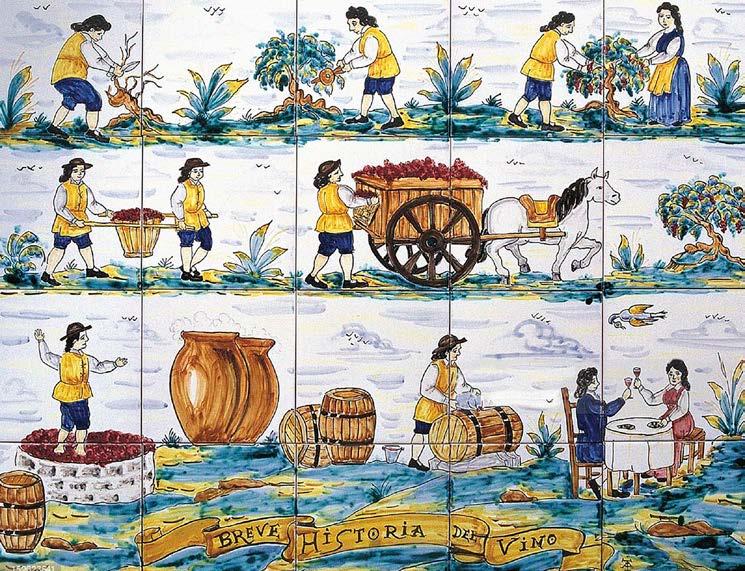
Spain ranks third in the world in terms of wine production (after Italy and France). There are more than one hundred certified winemaking regions. Among the white, rosé and red, Spanish red wine is considered one of the best in the world.

It is full-bodied, aromatic, with notes of fruit and oak. In Spain, you would rarely find demi-sec and semi-sweet wines. Almost all local wines are dry, excluding dessert wines (Vino de Postre, Vino Dulce, Vino de Licor), which, on the contrary, are very sweet.
The names of the regions that make the best wines are officially registered. They have the status of Denominación de Origen (D.O.), which indicates a high quality of wine and is always mentioned on the label.
The regions that have exceptionally good quality winemaking have Denominación de Origén Calificada (D.O.C.) status, which is similar to the Italian DOCG mark. This status is given to two regions of Spain: Rioja and Priorat (Catalonia).
GASTRONOMY
SPAIN HOLDS THE MOST VINEYARDS IN THE WHOLE WORLD – 15 PERCENT OF THE COUNTRY IS DEDICATED TO VINES.
76 VOYAGER 7/2017
RIOJA WINES
The best region of Spanish winemaking is Rioja, which is synonymous with Spanish wine in general for wine lovers.
Although Rioja wine production started 2,000 years ago, it is only in recent decades that it has found a global market. This was primarily helped by the phylloxera attack on French vines; as a result, famous French winemakers had to import grapes from abroad. It turned out that the climate and soil characteristics of the Rioja are unique; the local vines are also exceptionally sustainable.
Traditionally, the red wines of the Rioja region are more popular, although its white wines also taste wonderful. In 1991, Rioja wines were granted the highest status (DOC). It became the first Spanish region to achieve such a high-quality rating. The local vineyards are divided among three territories: Rioja Alavesa, Rioja Alta and Rio Baja. During the winemaking process, the grapes grown in different parts are mixed, giving the drink a special taste.
The Spanish grape variety Tempranillo is the main ingredient in the production of red wine (D.O.). It is mixed with Graciano, Mazuelo and Garnacha, which gives these wines a sharpness imbued with a fruity taste and tartness.
MARQUÉS DE RISCAL RESERVA
Manufacturer: Marques de Riscal;

Region: Rioja Alavesa
Excellent cherry red color: a mixture of piquant and balsamic aromas with notes of ripe dark berries and a hint of toasted wood. This creates a full-bodied feeling when touching the palette; the taste is delicious, it has a good structure, and features the taste of delicate and complete tannins. It lingers for a long time and induces a feeling of coolness infused with the oak aroma.
Grape varieties: Tempranillo, Graciano, Mazuelo. You can enjoy this wine with ham, a cheese with a non-distinct taste, dishes with a lower level of spiciness, beans and other cereals and red meat.


Price: starting from 25 €
GARNACHA MENGUANTE 2012
Manufacturer: Vinedos Y Bodegas Pablo;
Region: Carinena, Aragón.
Dark ruby colored; it offers piquant floral aromas of sugared red berries, cloves, vanilla, and incense. It gives a bright and cool feeling to the palate. The raspberry alcoholic aroma and herbal flavors are mixed with mineral properties. You will feel the taste of Pinot grapes. It leaves a strong and sustainable taste with a silky hint of tannins.
Price: starting from 21 €
MARQUES DE RISCAL
"The City of Wine", another masterpiece by architect Frank Gehry, is located in Elciego, in the Rioja region. The strange shape of the structure, clad in steel and titanium, with kilometer-long lined plates and decorated with golden, burgundy, silver and pink "wings", is more reminiscent of a coil than a winery. This unusual combination of colors is not accidental: pink and burgundy reminds us of the colors of bottled wine, while gold and silver suggest the distinct designs of wine bottles.
The steel framework hosts a factory, a wine museum, a Michelinstarred restaurant, a spa-salon and a unique hotel, also designed by Frank Gehry. Marqués de Riscal is among the world's top 10 wineries, most frequently visited by travelers.
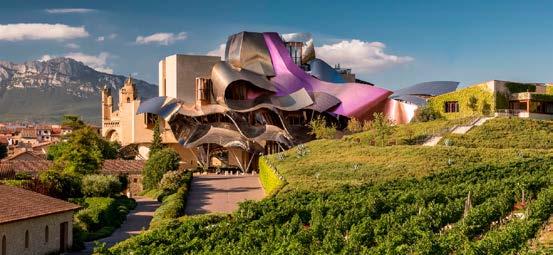
The 12 € tour includes a wine production demonstration and tasting of two types of wine, and viewing an ancient basement where the annual harvest wines have been kept since 1860.
Torrea 1, Elciego (Álava)
www.marquesderiscal.com
RIOJA CRIANZA 2013
Manufacturer: VIVANCO;
Region: Rioja Alta.
Light cherry red color. A well-balanced, sustainable taste.
Rioja Crianza is a firework of red berry flavors. Light notes of smoke, roasted vanilla and spices feature in the fruity taste. This wine, full of mature tannins, leaves an elegant and sustainable taste. It is an ideal pairing with Mediterranean cuisine.
Grape varieties: only hand-picked Tempranillo. The clusters are placed in a cold room for 36 hours until they are sorted and processed. It is aged for 16 months in French and American oak barrels, processed periodically, followed by six months ageing in bottles.
Price: starting from 24 €
RECOMMENDS
77 VOYAGER 7/2017
GALICIAN WINES

Because of the proximity to the Atlantic Ocean and the abundance of precipitation, grapes do not get fully ripe in Galicia, so the region’s wines are lighter and less sweet.
Several local vineyards have received D.O. status, most notable among them being D.O. Rias Baixas, which is famous for its white wines. Its vineyards are located in Pontevedra, the main grape variety being Albarino. A unique wine is made from it, which is saturated with a fruity and floral bouquet.
CASTILE AND LEÓN WINES
The wines of the Castile and Leon regions are exceptionally soft and delicate. There are several certified regions here:
D.O. Arribes – Vineyards are located in Zamora and Salamanca provinces, at the Portuguese border. The white wines are usually made of the Malvasia grape variety and the red wines of Tempranillo.
D.O. Bierzo – The Mencia wines (a variety of Cabernet), due to the balanced temperature in the area of the north-west of Léon, the sunny climate and the abundance of water, are distinguished by their fruity sourness and delicate structure.
D.O. Ribera del Duero – Tinta del Pais (a variety of Tempranillo) red wines are characterized by their intricate taste and plum aroma. They are aged for a long period of time.
D.O. Rueda – Experts believe that this is where they make the best white wines in Spain, infused with grass aromas, made from the Verdejo grape variety, which has been growing in this land for hundreds of years.
D.O. Toro – The Tinta del Toro (a variety of Tempranillo) grapes grown in Valladolid are high in sugar content and the resulting wine is strong.
CASTILLA-LA MANCHA WINES
This is the central region of Spain's winemaking – a large amount of wine is produced here. The local winemakers mainly make products for mass consumption, the majority of which are in the range of table wines (Vino de Mesa).
Specialists believe that these lands have not yet shown their full potential, and that Castilla-La Mancha wines will gain international recognition in the future. Among the ten regions with D.O. status, Valldepeñas and D.O. La Mancha are considered the best.
BASQUE COUNTRY WINES
The historical distinctness of the Basque Country influences its wine production. Wines from the oldest varieties, that have no similarity to other regions, such as white Hondarabbi, and red Hondarabbi Beltza, are made here. Basque wines are therefore very singular.
White wines are more common in the Basque Country with their district floral aromas.
MADRID WINES
The province of Madrid is also considered a winemaking region. The following grape varieties grow there: white - Malvar, Airen, Albillo; red - Tempranillo, Garnacha, Garnacha Nita. The winemakers of the capital make red, white and rosé wines.
Only one area is officially certified in this province - D.O. Vinos de Madrid.
GASTRONOMY 78 VOYAGER 7/2017
NAVARRA WINES
Navarra and Rioja are neighboring regions whose soils are similar to each other but climates differ. Navarra is a seaside region while Rioja has no access to the sea. Both regions grow the same grape varieties: Tempranillo, and Garnacha. When Navarra fought for recognition of its own winemaking industry, they placed their bets on the rosé wine made in Garnacha.
They also used popular varieties that were not cultivated by the conservative winemakers in Rioja - Merlot, Cabernet Sauvignon, and Chardonnay.
Most of D.O. Navarra's wines are made from a mixture Tempranillo and Merlot, as well as Cabernet Sauvignon. Chardonnay is used for white wines. The climatic conditions on the region affect the taste properties of the Navarra wines, and the vines uniquely grow in limestone soil.
CATALAN WINES
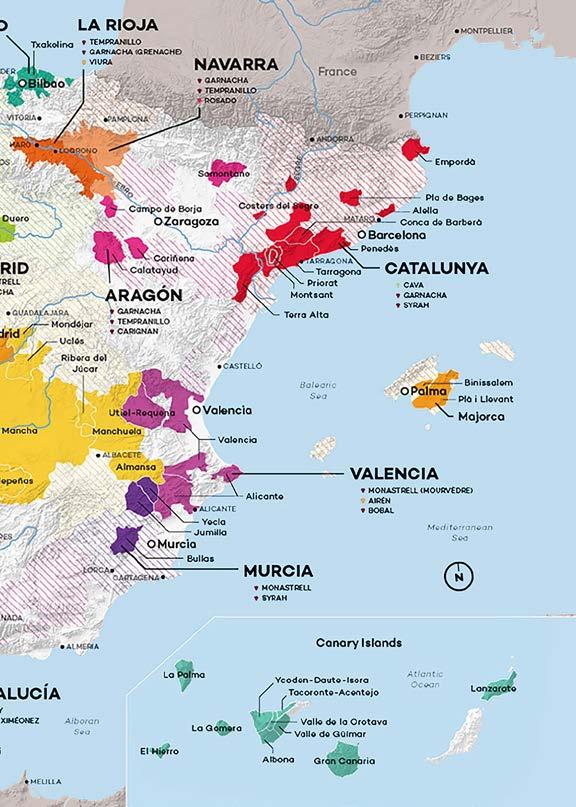
Catalan wines were already being made in the Roman period. The tradition lived on in the medieval period through monastery cellars. According to specialists, one of the most common grape varieties - Cabernet Sauvignon – is native of Catalonia. Many Catalan brands are D.O. certified. Among them are the most famous D.O. Penedés, DOCa Priorat and D.O. Cava.
D.O. PENEDÉS
The white sparkling wines made from the grapes grown in the Barcelona and Tarragon provinces are known for their fresh, fruity aroma. In recent times especially, the red wines of D.O. Penedés have been particularly popular. Here they grow famous French varieties as well, such as Cabernet Sauvignon and the traditional Spanish Tempranillo, which is called Ull de Llebre in Catalonia. D.O. Penedés wines are characterized by their soft velvety feel, especially Codorniu, Freixenet and Torres.
DOCA PRIORAT
The Priorat vineyards located in the Taraggon province are certified with DOCa status. The local wine is considered the best in Catalonia. Wines from Priorat are made from grapes varieties such as Garnacha, Merlot, Cabernet, Sirah and Cabernet Sauvignon. These celebrated, strong red wines have a specific taste that stays in the mouth a long time after consumption.
D.O. CAVA
These sparkling wines are called Catalan Champagne. The Cava recipe was created in a cellar in Codorniu by a family that was working to make their wine different from French champagne. The singular taste of Catalan sparkling wine is brought through such grape varieties as Macabeo, Parellada, Xarello, Chardonnay and Malvasia.
ANDALUSIAN WINES
Andalusia is home to sweet, fortified wines. The history of local winemaking begins in the first millennium BC. In the period of Arab domination, winemaking was forbidden almost everywhere. Andalusian winemaking was reborn after the region fell from Islamic control. The local climate is too hot for making dry wines, which is why sweet and fortified wines are made here.
The winemaking process implies mixing different harvests. Full barrels of wine are laid out in the form of a pyramid. The oldest wine is kept on the lowest tier. One third from each barrel on this tier is bottled annually, and the barrels are refilled from the next tier. Andalusian wines are strong and characterized by a complex taste.
79 VOYAGER 7/2017
YOUNG / GARNACHA
Tasting Notes: Strawberry, Red Grapefruit, Hibiscus, Black Tea.
Region: Calatayud, Somotano, Navarra, Cariñena, Campo de Borja, La Mancha. Garnacha is called Grenache in France, even though these grapes originate in Spain. This juicy and light wine has fruity and iced tea aromas.
HIGH-END / GARNACHA
Tasting Notes: Grilled quince, Licorice, Juniper.
Region: Vinos de Madrid, Campo de Borja, Priorat, Méntrida
The high-end Garnacha wine is saturated with aromas of berries and tannins. This kind of wine is aged for many years and is made of grapes harvested from old vineyards.
MONASTRELL

Tasting Notes: Blackberry, Chocolate, Smoke.
Region: Jumilla, Alicante, Valencia, Bullas, La Mancha, Yecla. Monastrell has a high tannin content and is saturated with aromas of black berries and black pepper; the longer it is aged in barrels, the stronger the aromas of mocha, chocolate and vanilla become.
YOUNG / TEMPRANILLO
Tasting Notes: Sour Cherry, Plum, Spicy Black Pepper and Bay Leaf
Region: Rioja Crianza, Ribera del Duero Roble and Crianza, Valdepeñas, Tinto de Toro, La Mancha, Castilla-León, Extremadura.
The aromatic Tempranillo wine is aged for no longer than a year. This is why it has a spicy, flashy and tarty taste. The best example is Rioja Crianza.
BOBAL
Tasting Notes: Black Cherry, Dried Green Herbs, Violet and Cocoa Powder
Region: Utiel-Requena, Manchuela
This wine is very common in the central regions of Spain, and is regarded for its deep purple color and high tannin content.
LANZAROTE is a volcanic island of the Canary archipelago with 300 craters. Its local winemaking history stretches back 1,500 years. The local sweet wines proudly stood on the tables of European kings and aristocrats.

In 1730-1736, three volcanoes erupted and the island became a lifeless desert. However, the local winemakers quickly discovered the unique properties of the volcanic soil (Picon). It absorbs the moisture from the air, stores it in the ground and prevents the evaporation of water. As a result, a dry method (enarenado) of cultivating vines was created, which is only used on this island. Lanzarote has a dry, sunny climate and rain is rare.
Here, the care and maintenance of vineyards can only be done manually, creating the need for a different planting process. Every vine is placed in so called phoso-craters (zocos), semi-circled with a border of volcanic soil (geria).
AGED / TEMPRANILLO
Tasting Notes: Cherry, Dried Fig, Vanilla and Cedar
Region: Rioja Reserva, Ribera del Duero Reserva, Toro Reserva, Aged Castilla-León. This full-bodied wine, high in tannins, is aged for several years in oak barrels and bottles. This is why it reveals the best properties of Tempranillo – it is higher in dryness, with a softer taste and an almost sweet aroma.
MENCÍA
Tasting Notes: Pomegranate, Licorice.
Region: Bierzo, Ribeira Sacra, Monterrei, Valdoerras.
This is a medium-bodied wine with a distinct taste, which mainly grows in Spain and Portugal. It was based on Grand Cru Burgundy wines with medium drying tannins and floral aromas.
Vines are grown in craters and one vine yields about 20 kg of harvest annually. The vineyards create an outstanding landscape, reminiscent of an alien planet.
80 VOYAGER 7/2017
GASTRONOMY SEVEN VARIETIES OF SPANISH RED
TXAKOLI
Txakoli is the most celebrated drink of the Basque Country. This light, slightly fizzy white wine with fruity aromas has a refreshing yet sour taste.
Txakoli wine is the best of the wines produced in the coastal cities of Getaria and Zarautz (they are also named "Getariako Txakolina"). It is aged for a short time and has an average alcohol content (9.50-11.50%).

The drink has a light yellow color and is characterized by its intense citrus, herbal and floral aromas. Refreshing, slightly tarty and easy to drink, Txakoli is most delicious when freshly removed from the refrigerator; it is poured into a glass from a height, and the liquid hits the edges of the glass, revealing a whole range of aromas.
Txakoli is most suited to fish and other sea seafood. We recommend that you try this wine with salty anchovies, and white tuna in oil.
JEREZ
Guéra La Guita Manzanilla jerez has the largest number of consumers in Spain (alcohol content is 15%, manufacturer: Hijos de Rainera Pérez Marín, Andalusia). La Guita Manzanilla is an expressive and harmonious wine filled with typical green olive, floral and dried fruit light notes, giving it a kind of tenderness. With a light taste of salt, minerals and hazelnuts, this is the best appetizer with tapas. Price: 15 €.
The real jerez (Xera, Sherish, Xeres, Sherry) is made in the region carrying the same name (DO JEREZ).
The winemaking tradition there stretches back 3,000 years. The climate supports the growth of three grape varieties: Palomino (used for dry wines), Pedro Ximénez and Moscatel (sweet wines).
a few weeks. Thanks to the natural climate, the grapes are often dried directly on the branches, which gives them a high sugar content but reduces the amount of tannins.
RECOMMENDS
AMEZTOI GETARIAKO TXAKOLINA –sour-tasting white with a distinct flavor (18 €); a wonderful rosé is Rubentis (20 €).

TXAKOLI TXOMIN ETXANIZCLOSE –white wine with fruity aromas and a light yellow-green color (23 €).
HIRUZTA TXAKOLINA – a distinct, fresh, slightly sour and sophisticated taste, ideal with local fish dishes and pinchos (18 €). Produced in Hondarribia.
GURRUTXAGA BIZKAIKO
TXAKOLINA – clear white (19 €) and a floral rose (19 €). Txakoli is mostly produced in the Basque Country. In the rest of Spain, one can try it in Basque restaurants.
Strabo l wrote that the Phoenicians had brought a jerez vine to this region in 1100 BC and initiated the local winemaking process. Following that, Jerez became a city of winemakers, whose products were exported to other Mediterranean countries and the Roman Empire.
In spite of the prohibition during the 500 years Arab rule, Jerez still remained a winemaking region.
In 1264, Castilian Alfonso X freed the region from the Arabs and called it Xeres de la Frontera. Soon winemaking flourished and jerez was sold in different countries, exchanged for English wool, enriching the Kingdom of Spain and spread all over the world. It “participated” in “conquering” the American continent with Columbus.
The grape varieties best suited for jerez grow in chalky, clay or sandy soils. To make sweet wines, the grapes are laid out under the sun for
The clusters are hand-picked and the juice is pressed and fermented. Jerez reduces the levels of bad cholesterol in the body, improves the digestion process and increases one’s appetite. It is rightfully considered to be the king of aperitifs. One should cool it down to 50C and sip it slowly.
Jerez usually comes in two varieties: Fino and Oloroso. Jerez Fino should be kept for at least three years before it is sold under a special layer, created by a special type of wine yeast. The beverage is made from Palomino grapes that grow in chalky soil. This type of jerez is always dry and 180 proof. It is stored in barrels that gather the above-mentioned yeast for decades. Under its effect, the beverage gains a wonderful taste and aroma.
Jerez Oloroso matures under the yeast for a short period of time. The name of this variety is translated as "aromatic". This wine, for several reasons, does not produce the yeast by itself, hence it is a dessert jerez.
81 VOYAGER 7/2017
The best jamón – Iberico – is made from the thighs of black Iberian pigs, which are kept on a special diet of acorns and cereals (such jamón is called recebo), or only acorns (bellota). Even the hoofs of the black pigs are black, which is why they are called pata negra.

COMMENT
JAMÓN, JAMÓN
Everyday life in Spain is unthinkable without black pork thigh ham. Jamón is not a product with a cult status in the country – it is something very obvious, something that has always been there and will always be there in the future.
Jamón is available in tapas-bars, and this ritual has its own charm. However, in order to feel the whole diversity of this unique product, it is better to visit a specialized jamón shop. Here, in the world of elegant pork calves, which neatly line the store ceiling, you will discover the truth. The truth is that before this moment, you either had no idea of what ham really is, or you had very vague, provincial knowledge. With jamón iberico de bellota, you conquer new heights of taste. This divine ambrosia can only be described in such an artistic manner. It comes in a dark purple or tender pink color and can have little or a lot of fat but its sweet taste and structure that melts in your mouth is unforgettable.
The simplest method of determining the quality of jamón is its price. The price for one kilogram starts from 30 euros and goes beyond 300 euros. You can conduct a simple tasting: buy 100 grams of jamón in different price categories: 40, 70 and 200 euros; you can venture into more expensive products if you so desire.
Specially trained personnel will delicately cut the ham and wrap it for you. Start with a relatively inexpensive variety. I am sure you will like it very much. Keep on going and when you finally try the most expensive jamón, you will appreciate the difference in taste and structure of the meat. Jamón has a sweet and intense but not disturbing taste. Even though it may be a bit hard, it melts in your mouth and does not turn into a rubber-like mass when you chew it. Please also note that all respectable Iberian pigs have black hoofs, and this how to tell them apart from relatively cheap varieties.
The story of smoked pork thighs goes back 2,000 years. According to legend, Spaniards tried jamón for the first time when they saved a pig from drowning in a river and later ate it. The source of the river was a salty spring; the body of the pig, who had floundered for a long time in the water, had absorbed the salt and thus its meat proved to be very tasty. This is how the tradition of salting pork began.
After the Reconquista, or the end of Moorish rule, only Arabs and Jews who converted to Christianity were allowed to remain is Spain. To prove their loyalty to the new religion, they would publicly eat salted pork thigh surrounded by cheering crowds.
Jamón can be stored for a long time and retain its taste. Hence, it became the food of travelers and sailors. It was among the main nutrients of the sailors who discovered America.
The "elite" breed of Iberian black pigs live in gorgeous oak groves where they make multi-kilometer trips in search of their daily rations of acorn and grass. This is why their meat is distinctively delicious. The fat is layered in the muscles in thin threads, and when you eat jamón, you can easily taste the flavors and light sweetness of the grass. Meat from a freshly slaughtered pig is kept in salt for several days; this method of storage expels excess fluid from the meat. After the salt "bath", the meat is washed and dried.
An average Spaniard eats 5 kg of jamón on average annually, so Spain is the world leader not only in production but also consumption.
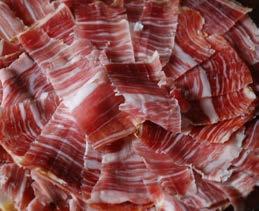

GASTRONOMY 82 VOYAGER 7/2017
Consequently, it is moved from one basement to another. Each of the basements has different temperatures and humidity levels. Thus, jamón masters form the taste of this delicacy and only they know definitely when it is ready.
Many indicators are used for this purpose but the most important is the aroma - that is why jamón is pierced in advance with a thin bone needle. Making jamón can take as long as eight years, though this kind of aging is very rare.

Jamón iberico de bellota cannot be a daily treat for mere mortals. The price for 100 grams is 20 euros, and a 7 kg thigh is worth about 500 euros. However, if you cannot afford the back foot (that's what jamón means) you can buy the front thigh (paleta, or delantero). There is less meat in it and therefore it weighs less (4-5 kg). As for the brands, for many years, 5 J (Cinco Jotas) and Joselito have been considered the best producers.
Jamón Serrano is made of white breeds of pig. Its quality and taste are inferior to "Iberico" but this does not mean that the ham is not tasty; it's just different. One such thigh is worth around 70 euros.
One thigh of the rare Manchado de Jabugo jamón is worth 4,100 euros. There are only 51 adult pigs of this breed left in the world. The Dehesa Maladúa company calls the jamón made from their meat "white gold".
The produce of Jamón Serrano Gran Reserva that is aged for 15 months is considered the best. La Hoguera and Navidul are among the worthy brands. The price of a thigh of a pig that has only been fed cereals (Serrano) is relatively cheaper. Shoulders made like jamón are also relatively cheaper and called "lomos".
Like with the finest wines, the "origin" of jamón is very important. The Denominacion de Origen is a kind of mark of quality that guarantees that jamón is made according to certain rules and in a certain province, which is indicated on the label, for example: Jamón de Huelva, Jamón de Teruel, Jamón de Trevelez, Cecina de
Jamón is very good for one’s health. It contains a small amount of cholesterol and large amount of oleanolic acid.
Jamón does not remain a decoration for a long time – in the end, it must be eaten. This is preceded by a complex, spectacular process of carving. The masters of this process are called contadores, and the boards on which the thighs are carved are called jamóneres.

This is a distinct show, demonstrating the quality of the jamón and the skills of the contadore, whose weapon is a long, thinly sharpened knife. The thigh is fixed on the board, with the hoof side up. It is firstly “opened” with the tip of a short knife - the cut is made in the direction of the carver and it separates the skin and fat before the meat appears.
Then it is cut into thin, 6-7 cm long slices. In the areas where the thigh cannot be cut thinly, they use the small knife again.
Leon etc. Each thigh should have a designated label which should indicate the name of the pasture, the pig's number, the weight of the leg before salting, the date the salting process began, the time spent in the storage, and the duration of the drying period.
Pork for high-quality jamón should be at least three-quarters Iberia breed. During the acorn season, from October 15 to February 15, the pigs live freely in the grove (only up to 15 per hectare). Before slaughtering on March 31, they must gain a certain weight. Jamón receives its unique taste and aroma through a long process of aging in special basements and, like wine, waits for the right time. Modern products are less salty; the so-called mass product is only aged for six months while high-quality jamón is aged for at least a year and a half.
Sometimes jamón that is made from the meat of the same pig can have different tastes. It also depends on which side the pig lay on. Spaniards love hanging jamón in their kitchens. The prepared ham looks so good that it’s a pity to eat it.
Try jamón with melon for a combination of sweet and salty tastes. Jamón also pairs well with olives, herbs and cheese; the perfect combination is jamón, bread and tomatoes; eggplant, squash, cauliflower, green beans, fried potatoes and pasta compliment it very well. Jamón is typically accompanied by dry red wine, Jerez or beer.

83 VOYAGER 7/2017
Cheese lovers will love exploring Spain. The local cheese map counts more than one hundred varieties: hard, medium or soft, new /aged, aged in wine/oil, or seasoned with truffles.



Each of the seventeen Spanish regions have their own traditions and unique recipes of cheese-making. Each is protected through a certificate of authenticity (DOP) similar to the French AOC. If you want to try authentic cheese and not a copy, be sure to search for the DOP-certified varieties.
It is worth paying special attention to the varieties of goats’ cheese on offer; in this regard Spaniards have no competition.
IDIAZABAL DE PASTOR (DOP), BASQUE AND NAVARRA
MANCHEGO (DOP), CASTILE-LA MANCHA
Manchego is the most famous Spanish cheese outside of Spain and the most imitated.

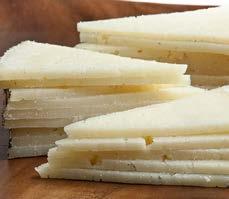
The characters created by Cervantes used to tend to their hunger with this variety of sheep cheese. Manchego means a resident of La Mancha; it is also the breed of the sheep whose milk is used to make this cheese.
There are different delicious varieties based on their aging: for example, Semicurado (at least 30 days), the sharper tasting Curado (60 days) and Añejo (two years).
PETITOT PEQ, CATALONIA
The taste of this hard cheese from Basque and Navarra is defined through the quality of the sheep milk and the mastery of the cheese makers as well as the shepherds' experience.
Today, only 116 people have the honorary right to shepherd the Latxa breed of sheep.
Thus, behind every head of cheese stands a distinct shepherd. These small and whimsical sheep are only milked from February to July, and the milk has the aroma of grass and almonds.
This goat cheese is made in the Terradelles village. The flawless, high-quality goat milk used is rich with mushroom and grass flavors; this soft cheese will be a true discovery for gourmands. Its unforgettable taste opens up gradually: at first it is sour, followed by saltiness, and finally is slightly hot.
Traditionally, cheese in Spain is kept in pruning jars filled with olive oil.

Rulito de Cabra, especially delicious among such varieties, is made in Castillo Canena with Vega de San Martin olive oil made through cold extraction.
RULITO DE CABRA MADRID CABRALES (DOP), ASTURIAS
This is the most popular, bluemold Spanish cheese made from a mixture of sheep, cow and goat milk. The animals consume delicious grass 800 meters above sea level so do not be concerned about the quality of the milk.
The sharp and piquant taste of the cheese is due to the limestone caves where it is
TORTA DEL CASAR (DOP), EXTREMADURA
This delicacy, made from fresh sheep’s milk, is only produced in one city - Extremadura. It will remind you of a warm fondue because Torta should be removed from the refrigerator four hours before consumption.
Its hard surface substitutes a plate for this cheese. Just remove the outer layer and the "dish" is ready. Torta del Casar is eaten with bread.
aged for half a year. You can have this delicacy at dinner or as a dessert with figs and nuts.
GASTRONOMY
84 VOYAGER 7/2017
QUESO MAJORERO (DOP), CANARY ISLANDS (FERTÉVENTURA, LAS PALMAS, LA OLIVA)
A small amount of sheep milk is used to prepare this goat cheese. It comes in three varieties with different tastes according to their aging process: Tierno is delicate; Semicurado is balanced; and Curado is more saturated. This cheese is swilled in corn flour or sweet red pepper powder.
TETILLA (DOP), GALICIA
This young cheese made from cow milk is a little salty. It melts in the mouth and is delicious for breakfast with quince marmalade or dried fruits; at dinner, pair it with Galician Ribeiro & Albariño wines.

TAPAS AND PINCHOS
Tapas are different types of snack food – they are small-portion dishes.

What are tapas made of? Remember that you may encounter any ingredient in tapas - a piece of tuna and sweet onion with olive oil on a long stick; a hot chorizo sausage; slowcooked beef with potato puree etc.
When the workday ends, Spaniards go to bars to have tapas, especially since they like to dine after 9 p.m. Tapas are also consumed before special holidays. Tasting these dishes is an integral part of daily Spanish culture. In Catalonia (Barcelona), you will surely be offered tapas. This word is derived from the word “tapear”, which means "to cover". In the Basque Country on the other hand, you will have pinchos – this comes from the word “pinchar”, which means "making a hole".
SPANISH MEAL SCHEDULE
The average Spaniard eats four or five times a day, and approaches their food with seriousness and pleasure. Meal schedules can differ in time and content by region but mainly look as follows:
QUESO FRESCO (BLANCO) VALENCIA
This young cheese made from cow milk is produced all around Spain but the best is from the Belda cheese factory in Valencia.
This variety might remind you of gentle Mozarella.
Usually, this young cheese is served with quince marmalade at breakfast and with anchovies and tomatoes at dinner; at that time, you will enjoy its fresh and sweet taste. It is an excellent snack.

07.00 - 08.00, el desayuno (breakfast). This is for those who leave their home early. Breakfast in Spain is usually light: coffee, cola cao (a drink similar to hot cocoa) and toasted bread with jam or a croissant.
You can buy such a breakfast for around 10 €
10.00 - 11.00, el almuerzo (second breakfast). Spaniards prefer to have this breakfast in cafes. Here one can have a sandwich (bocadillo), churros dipped in hot chocolate, a croissant, cake and coffee.
A café breakfast costs around 10 € on average.
14.00 - 15.00, la comida (lunch). During lunch, a salad (ensalada) is a must, usually made with salad leaves, tomatoes, onions and sometimes chopped boiled eggs.
The main difference between pinchos and tapas is that wooden sticks are used in the preparation of the former to stop the topping foods separating from the thin slices of bread underneath.
Pinchos are composed of a lot more different ingredients and a more creative approach is employed in their preparation.

COMMENT
The essential ingredient is olive oil. One will never find cucumber in a Spanish salad. Spaniards do not like soups. Gazpacho is popular in the summer and is consumed cold. It is made of mashed tomatoes mixed with garlic, olive oil and other ingredients.
The second course is diverse and depends on what you prefer - meat, fish or vegetable dishes.
Lunch will often be accompanied with a glass of wine.
Dessert is usually a slice of cake, some ice cream, a flan or jelly-like sweets, usually with coffee.
Lunch starts from around 20 € on average. You can visit a cafe or restaurant that will offer you a lunch menu (menu del dia) (price starting from 12 €).
16.30 - 17.30, afternoon snack (la merienda). At this time, the best options are pinchos or tapas or small sandwiches. However, there is no limit to the imagination in their preparation. Northern Spain is famous for its pinchos, particularly the Basque Country.
21.00, dinner. Spaniards love to dine out. They go to restaurants with their whole family or with friends. Dinner menus are diverse and depend on the specifics of the city and the restaurant. Prices vary accordingly, starting from 15 €.
85 VOYAGER 7/2017
GASPACHO
Generally, Spaniards are not big lovers of soups, but gazpacho is an exception. This cold tomato soup was invented in Andalusia, Spain's hottest region, where temperatures rise beyond 40 degrees in summer. So, for a tourist wandering the streets of Seville, Grenada or Cordoba, cold gazpacho is a true delight.
Other than mashed tomato, it can contain bread pieces, sweet peppers, garlic, olive oil and vinegar. This classic recipe varies by region.
COCHINILLO ASADO
A real gourmand from Madrid, if he or she wants oven-roasted pig, will not shy away from driving an hour to Segovia and ordering it in a restaurant near the grandiose aqueduct left behind by the Romans. A waiter or the restaurant owner will masterfully split the pig into four equal parts.

PAELLA

Valencian paella is considered to be the most delicious. This why you will find “Paella Valenciana” written in cafe and restaurant menus in other towns. The base of paella is rice, which can be prepared with seafood (the most popular), chicken, beef and even rabbit. Paella can contain vegetables as well. The tastes of hot and cold paellas differ, and I suggest you try both.
TORTILLA DE PATATAS
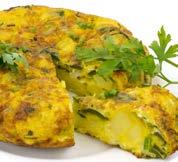
The story has it that a poor Navarre woman prepared tortilla for a Spanish general in 1817. Since she had almost nothing at home, she took potatoes and onions, poured eggs over them and baked the lot together.

PULPO A LA GALLEGA
As can be deduced from the name, this dish was invented by Galicians.
This dish is a lot like paella but is made with vermicelli. The rest of the ingredients are almost the same.
CROQUETAS
The favorite dish of Spanish children. Croquetas can be made of fish, meat, ham, chicken, and vegetables. France is considered to be the home of croquetas. It is very popular in Sicily

It doesn’t seem like much, but the general was so impressed that he asked for the recipe. Since then, this dish has been very popular among Spaniards as well as tourists. The thickness and texture of Tortilla changes according to the region.
ALDONDIGAS
This dish is very similar to gupta (Georgian meatballs). It is made with the same ingredients and in the same way.
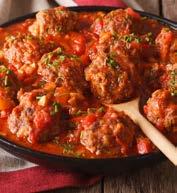
You can order dry albondigas, in its own juice, or with a sauce. It's a winter dish.
Other dishes are more suited to the summer climate.
EMPANADAS
Empanadas are Spanish pies. And like all pies, they may contain meat, chicken, fish, ham, vegetables and so on.
It is often eaten for lunch (merienda) by office workers or by children during break time.
as well. Croquetas are not difficult to prepare. In Spain, it’s associated with grandmas, because as a rule, every grandmother spoils her grandchildren with their favorite croquetas.
In general, they love octopus in Galicia and prepare it in many ways.

Octopus is cooked, then chopped and sprayed with olive oil. It can also be served with potatoes. The Galician wine Albarino suits this dish very well.
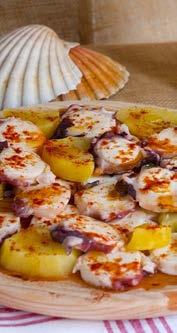
GAMBAS AL AJILLO
You should order this easy and fast dish in seaside towns or resorts so that you can be sure that the shrimps were caught on the same day. Wellcleaned, freshly caught shrimps are fried in olive oil with garlic, which gives it a special aroma and taste.
86 VOYAGER 7/2017
GASTRONOMY
You can find roasted pig in many restaurants in Castilla-La Mancha, but the aqueduct is only in Segovia.
FIDEUA
MIGAS
In the past, this dish was prepared by poor families in the south of Spain. The housewife would take dry bread, chop it and put it into water.
Then she would chop everything else she had in the house. She would braise peppers, chorizo (Spanish sausage) and onions in olive oil, add garlic and then the softened bread.
After stirring well, Migas is ready. They will serve you Migas cooked in the same manner in a restaurant.
ARROZ NEGRO
This dish has a rice base and is full of seafood. It includes royal shrimps, prawns, octopus, calamari and mollusks.
The rice is colored black with black calamari ink. The essential ingredients are pepper, garlic, olive oil and white wine.

This dish is the most delicious in Catalonia.
BACALAO CON PIL PIL
This is a Basque dish. Basques love cod very much and prepare it in many ways.

The most popular is with pil –a variety of spicy pepper. The cod is glazed with olive oil and garlic and pepper are added. Finally, all of it is cooked for approximately five minutes over low heat.
PIMIENTOS DEL PADRON

The idea of roasting peppers on a grill belongs to the Galicians as well. They serve them sprinkled with salt.
Despite the scary look, the peppers are not hot.
PATATAS BRAVAS

PAN CON TOMATE
FABADA ASTURIANA
RABO DE TORO

Initially, the tail of bulls defeated in bullfights were used to prepare this dish. But the soup became so popular that Andalusians did not spare even non-fighting bulls.
Generally, it is not easy to soften a bull’s tail, so it’s cooked for a long time in a sauce, with the addition of chopped carrots, onions, garlic and pepper.
Thickly chopped potatoes are fried in olive oil. Firstly openly, then coverd with a lid. Afterwards, the potatoes are sprinkled with sweet paprika and tomato mixed with vinegar is added. This is kept on heat for three minutes and then served. Other than the potatoes, the main ingredient of patatas bravas is the paprika pepper, which gives it special smoky flavor and a bordeaux color.
ALLIOLI
In old times, peasants used to eat bread prepared in this way for breakfast. Today, you can request it in a bar at any time of the day.

It comprises toasted bread smeared with garlic, sprinkled with olive oil and topped with blended tomatoes.

Sometimes, it is offered as an appetizer in restaurants.
This sauce, which is reminiscent of mayonnaise, was created in Catalonia. Aioli is the most famous of the four typical Catalan sauces and is made of garlic and olive oil only. Although it is very tasty and suits many dishes, if you have a business meeting or a date, you may want to postpone the pungent Aioli for another time.

This dish will be interesting for bean lovers. Its homeland is Asturias. Located in the north of Spain, it’s quite a cold region. Hence, local dishes are hot and nutritious.

In olden times in Asturias, the beans were cooked in clay pots with ham and sausage.

In restaurants, Fabada is usually served in a clay pan.
ACEITUNAS RELLENAS
Piquant olives with a filling are very typical in Spain, which is the world leader in olive and olive oil production.
Aceitunas rellenas are mainly made with anchovies, but you may find them with cheese.
87 VOYAGER 7/2017
TURRON
Turron was traditionally prepared for Christmas, though today is a popular every day dessert. It resembles gozinaki with nuts mixed in nougat. The main ingredients are honey, almond and egg whites. Alicante Turron is considered the best.

POLVORON
Andalusia is not only famous for its long summer and fun celebrations but also for Polvoron cake. This is also a traditional Christmas pastry, made from almonds, cinnamon and sesame – it is so airy that it simply melts in the mouth.

FLAN
Spanish flan is an airy, soft caramel pudding. It is made in the same way in all parts of the country. Flan is very similar to the French crème brûlée, but the caramel is under the pudding rather than on the surface and is therefore not hardened or burnt.

LECHE FRITA
The biscuits of this creamy dessert are made from rice flour. Each chef has their own method of preparing the cream and milk filling. San Sebastian – the Mecca of Spanish cuisine – is considered its homeland but they serve this dessert everywhere in Spain.

BIENMESABE
If you decide to enjoy the azure coast of the Canary Islands, be sure to try locals’ favorite dessert –Bienmesabe. This is the most gentle and delicious mousse with a distinguished taste of almonds and cinnamon.

TARTA DE ALMENDRAS
Their love for almonds, which are added to almost every dessert in Spain, inspired the Spaniards to create this wonderful cake. This most delicious dessert is decorated with the Knights’ Cross, which indicates the old glory of the region.

CHURROS
Churros are very well suited to hot chocolate. It is best if the chocolate is thick for dipping these small elongated dough cakes in.
Churros are a constant part of traditional Spanish breakfast.

CREMA CATALANA

Catalans still dispute the origin of this dessert with the British and the French; one thing is clear – it is the oldest European dessert. Cream is poured into heat-resistant bowls then cooked; the hardened cream is then left to cool before the sugary top is burned/ caramelized with a torch.
EXOTIC FRUIT - Spain is not a tropical country but thanks to its warm climate, various exotic fruits grow here.




HIGO CHUMBO
This Indian fig is a variety of cactus. Its fruit is very sweet and tasty and, most importantly, contains a large amount of Vitamin C. One must first soak it in cold water then clean all of the needles thoroughly. To do this, you can hold it over a fire or clean it with a hard, impermeable cloth.
CHIRIMOYA

This fruit, which should be served cold, will remind you of plum ice-cream.
Before consuming it, you should completely remove all of the Chirimoya seeds then remove the pulp and consume it with or without yogurt.
The pulp of this fruit is often used in salads.
KIWANO
Kiwano, which is called the milky melon, simultaneously resembles a cucumber and a banana. This unique fruit contains carbohydrates, proteins and fats. Kiwano is often used raw and eaten as a main course or as a side dish for meat or fish. You should cut the fruit in half, remove the pulp and remove the seeds.
TAMARILLO
Cut the skinned Tamarillo in half and eat it with a spoon. An excellent juice is made from the pulp of this fruit. Do not eat the skin as it has a stringent taste unlike the internal pulp.
Tamarillo contains many useful elements, vitamins and microelements and is low in calories.
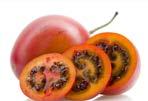
GUAYABA
This fruit is sweet but has a very slight sourness to it. In the summer, it is consumed while ripe and still a little sour and bitter to cool one’s body in the heat. Guayaba contains seven times more vitamin C than an orange; it is also considered a source of vitamins A and B. It can be eaten with or without its skin.
GASTRONOMY 88 VOYAGER 7/2017
SIDRA
This is a carbonated apple wine that is very popular in the north of Spain. You can enjoy a true Spanish cider in the province of Asturias, as well as in special bars (sidrerias).
PACHARÁN
This traditional liqueur of the Navarra province has been made here since the 14th century. This delicious drink is made from blackthorn and its alcohol content reaches 20-30 degrees.
It is believed that Pacharan improves digestion so it is often consumed after a meal.
SANGRÍA
This is a famous Spanish light alcoholic drink. According to the traditional recipe, it is made of dry red wine, a carbonated drink (soda water, tonic), sugar, "Cointreau" liqueur, various fruits and ice. Some modern recipes use white wine and various spices.
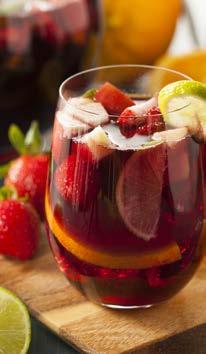
TINTO DE VERANO
This soft drink is made from red wine with the addition of carbonated water, ice and lemon or orange. It is especially popular in the summer.

CALIMOCHO
SPANISH BRANDY
In Spain, Jerez brandy can only be aged in Andalusia in the province of Cadiz in the area called the Triangle of Jerez. Airen and Palomina grape varieties are used to prepare Spanish brandy. 76 million bottles of high quality Spanish brandy are produced annually.
Spanish cognac is also known as Jerez brandy. It is made in the south, from alcohol and distilled wine materials, which are aged in oak casks for more than six months. In addition, the same casks should hold Jerez for at least three years prior to the brandy materials. Aging is done according to the "soles" system: The old brandy is constantly mixed with new brandy, which gives the drink a diverse taste. During the aging process, Spanish brandy loses its alcohol content (down to 36-45°).
Sometimes Jerez is mixed into Jerez brandy, sometimes other additives are used, like orange and caramel, though the best drink is made without additives.

REBUJITO
In Andalusia, they consume this drink very often. It is made of dry white wine mixed with soda water or Sprite. The cocktail is complimented with peppermint, ice and slices of lemon.

CLARA
Fresh Sangria is served in cafes in a pitcher or jug – a so-called “jara”. Bottled Sangria is available in shops.

This unusual lowalcohol drink is an equal mixture of beer and lemon Fanta; it is a perfect thirst quencher in the summer heat.
In this cocktail, a young red wine is supplemented with Coca-Cola and ice. Besides the classical recipe, there are different variations, with the addition of anise or fruit liqueur. These drinks are especially popular among young people.
TORRES
Torres 10 Gran Reserva is the most popular Spanish brandy in the world. It has been made in Catalonia since 1928. The numbers on the bottle indicate the age of the oldest alcohol used in the blend. This dark brown colored drink has a tint of red wood and amber tones. The deep, intense and interesting flavors are combined with sweet notes of vanilla, cinnamon, walnuts, spices and dried fruits. Its complex and at the same time soft, balanced and harmonious taste arouses pleasant sensations.
The price for one bottle (700 ml) of Spanish brandy Torres 10 Gran Reserva is 10-17 euros.


89 VOYAGER 7/2017
THE LABORATORY OF THE SENSES
SALOME DADUNASHVILI
The food that you will taste in "Mugaritz" is not food at all – it is a highly intellectual, theatrical performance during which you can put all of your senses to test, play with your taste buds, cheat your own eyes and feelings, and discover something completely new. This is the "Mugaritz" – an amazing place which refused the status of a restaurant a few years ago and calls itself a “sensorium”.
The "Mugaritz" restaurant is located a mere 30-minute walk from San Sebastian on a hill surrounded by lush green fields. A giant oak, which lends this amazing place its name, seemingly guards the surrounding pastoral peace.
The history of "Mugaritz" began in 1998; since then it has continuously retained its position among the best restaurants in the world.

The person at the center of the “Mugaritz” idea is a true philosopher. He simply uses food instead of books to deliver his thoughts to the public, and more precisely the feelings that his food arouse in them.
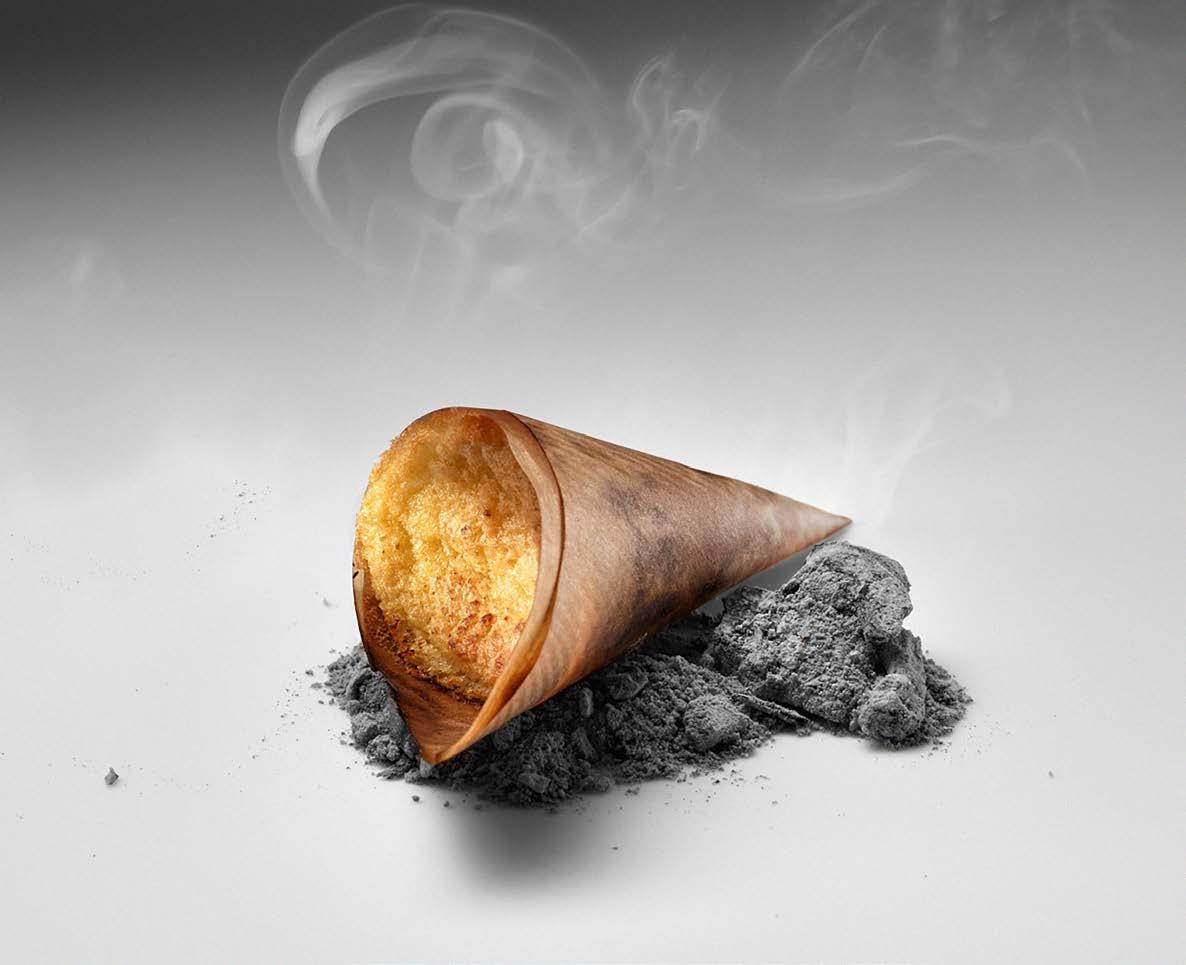
90 VOYAGER 7/2017 CHEF
Andoni Luis Aduriz will not be embarrassed to offer you a noble fungus grown on a piece of bread. The most banal thing that can appear on your plate is live flower. Most importantly, these amazing creations are so beautiful that one feels bad breaking them.

During your presentations, you talked about rituals, but the ritual is a story – what kind of story do you want to tell your guests?
Andoni Luis Aduriz: What we do is our essence. We want to share our memories and experience. We want to explain where we come from and show everything that we have invented. We try to put all of this in our dishes. When people come here to taste the food, I ask them: what are your expectations? In most cases, they do not know. The thing is that people usually do not know what they want. But they know what they do not want. They do not want to leave a restaurant without a story.
Is there a boundary where this magic can develop?
Reality is the only limit.
But you have already changed reality, haven’t you?
Our possibilities are the limit. The things we cannot do yet. Our food is not for everyday consumption. It is for waking up our senses. The most important thing for me is diversity. My dream is to have access to all seasonal products constantly because to create the unusual, one needs the most trivial ingredients.
Apart from the fact that the food you prepare is absolutely fantastic, you are trying to teach us about the ingredients that people have not eaten for centuries. In fact, while driving us towards the future, you are taking us back to the Stone Age – the period when people tasted everything.
WHEN PEOPLE COME HERE TO TASTE THE FOOD, I ASK THEM: WHAT ARE YOUR EXPECTATIONS? IN MOST CASES, THEY DO NOT KNOW. THE THING IS THAT PEOPLE USUALLY DO NOT KNOW WHAT THEY WANT. BUT THEY KNOW WHAT THEY DO NOT WANT. THEY DO NOT WANT TO LEAVE A RESTAURANT WITHOUT A STORY.
We have to be more tolerant and open-minded and try everything. We have lost this property of our ancestors due to civilization.
We are mainly afraid of what is different. Overcoming this fear is what Sensorium is about. For me, preparing food is self-development. I always ask myself the difficult questions. What we do is simultaneously a battle with the self and a dialogue.
Everything we discover is an answer to these difficult questions.

91 VOYAGER 7/2017
Ramon Perise, Andoni’s sous-chef, is the driving force of “Mugaritz”. Andoni Luis Aduriz is so popular that he spends most of his time travelling, while Ramon Perise looks after the “Mugaritz”.
The food that you make – I cannot even call it food. This is truly a new challenge, a philosophy. You do not make this food just to feed people – it's something new.
This is the food that inspires us. In “Mugaritz”, we use our food to provoke our guests. This is the food that allows them to create their own story. This food is a journey.
You come to the restaurant as a guest and leave it as an accomplice. It may seem strange to you, but this is the goal: to discover something unexpected. Your creativity is growing because you need to understand and guess what it is that you’re eating.
THIS IS THE FOOD THAT INSPIRES US. IN “MUGARITZ”, WE USE OUR FOOD TO PROVOKE OUR GUESTS. THIS IS THE FOOD THAT ALLOWS THEM TO CREATE THEIR OWN STORY. THIS FOOD IS A JOURNEY. YOU COME TO THE RESTAURANT AS A GUEST AND LEAVE IT AS AN ACCOMPLICE.
Yesterday I tried your amazing "Gummy Bull" (bull-shaped jellybon) and was tremendously confused: although the taste was very familiar, I could not fully untangle what I ate. Perhaps because you have completely changed the structure of the food, and fooled my senses ...
That is the most important thing. When we invent a fantastic new dish, we are sure to include a very familiar taste. When tasting strange dishes, people need a familiar taste to hold on to like a life-ring. The "Gummy Bull", which you tried, is a concentrated meat broth. It is the taste of the stock that you will find in any restaurant because there is no kitchen without such a broth. It is also important how we consume such food.

We always explain this to people in our restaurant. You should place the "Gummy Bull" on your tongue and wait until the body temperature melts its structure. This is when you feel most strongly the effect we want you to achieve.
We awaken the dormant senses in our customers. We do not try to please them – we try to move them.
Food is structure. There are people whose taste receptors are not very developed; people who do not see or feel the smell, but everybody eats and everybody knows the structure of familiar food. Your cuisine fools all of my senses, the sight, the smell ... as if you are putting me in a vacuum and offering me to try your new food structures.
It's amazing. This is exactly what we want. This is what we are trying to achieve. Nothing should be connected to familiar sensations.
A famous neuropathologist was at "Mugaritz" and the thing that impressed him most was that we awaken the dormant senses in our customers. We do not try to please them – we try to move them.

92 VOYAGER 7/2017
CHEF
And what reaction do you get from your customers?
There are those who are very open to such experiments and those who are frightened by them. Everything comes down to expectations. But when you go to a restaurant, you expect something else, and when you come to "Mugaritz" you get "Mugaritz"! It's been three years since we removed the word "restaurant" from our name. This is a place where something interesting happens and you can also dine here.
"Mugaritz" is our creative laboratory. We are financing it from different projects.

From projects where you offer just steaks to people?
Yes, exactly (laughs). We work in many directions. New technologies in the kitchen, different projects ... "Mugaritz" is the apotheosis of our creative freedom – a place where we do what we want.
MUGARITZ



“Mugaritz” is open seasonally from April 12 to December 10. It is closed from Sunday evening to Tuesday afternoon. Reservations are required.
Mugaritz. Aldura Aldea 20, 20100 Errenteria
Gipuzkoa, Tel. + 34 943 522 455; + 34 943 518 343
E-mail: reservas@mugaritz.com


93 VOYAGER 7/2017
THIS IS THE SENSORIUM. IT IS A TEST OF OUR FEELINGS AND CREATIVE THINKING. THIS IS MUCH MORE THAN A RESTAURANT.
THE BASQUE GASTRONOMICAL MIRACLE
SALOME DADUNASHVILI
Thousands of culinary professionals gather in San Sebastian every year to try the latest novelties in the world of cuisine. From an enormous stage, speakers and famous chefs share their latest discoveries and prepare dishes in front of the audience. It is hard to call these dishes mere food; rather, they are like divine ambrosia turned into various forms by the chefs using novel methods. For example, a jello shaped like a bull’s head will turn out to be an intense-tasting broth, and an olive placed on an appetizer stick will be gazpacho.
The sand-covered gulf of San Sebastian, adorned by surfers, has another center of gravity. Every autumn, the streets of the town are filled with unique aromas as crowds of people mill around the seaside conference center. This is San Sebastian’s Gastronomika – one of the world’s biggest and most prestigious culinary events. It serves one holy purpose: to feed people visiting from all over the world with the most delicious food.
Gastronomika will be held on October 8-11 this year. Those who want to attend should register before June 30.
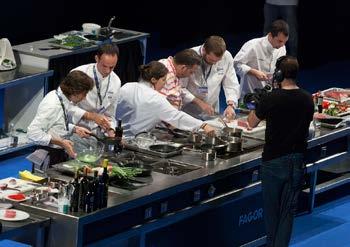


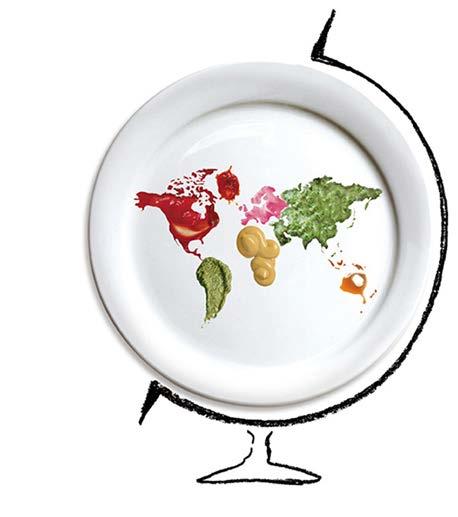
Price: €300
It’s been a long time since chefs stopped being thought of as mere onion cutters and turned into international stars. Today, San Sebastian’s Gastronomika proves that the stars have turned into magicians. No one is only interested in cooking tasty food anymore – the fact that food must be tasty goes without saying. No, the main thing nowadays is the concept behind food. What we eat, how we prepare it, and, most importantly, how we present it to the consumer.
Accredited specialists can try any of these new inventions at Gastronomika. To cater for this, dozens of people work non-stop in the enormous kitchen. During the presentations, which are held every two hours, scores of waiters bring plates out into the main hall. San Sebastian's main goal is the exchange of new ideas among professionals and facilitating the establishment of new contacts. Each year, the organizers of the conference focus on one country or cuisine. For example, it could be the culinary world of New York one year and Asian cuisine the next.
The whole city joins in this wonderful culinary celebration. Not only are the professionals exposed to amazing food –street kitchens pop up here and there to offer by-passers samples of that year’s cuisine. It is not very surprising that an event of such size and prestige takes place in this town. The Basque Country is known for having numerous restaurants with Michelin stars. In fact, San Sebastian has the highest concentration of Michelin stars per square meter in the world. The main focus in San Sebastian is on natural, seasonal produce.
94 VOYAGER 7/2017 GASTRONOMY
What is happening in this region and what kind of magic is in the air that gets so many chefs to come and work together?
I posed this question to two super popular chefs, Eduard Xatruch and Oriol Castro. They are students of Ferran Adria and had worked with him in the three-Michelin star restaurant El Bulli. Together with their colleague Mateu Casanas, they are the chefs of the oneMichelin star DISFRUTAR – one of the most popular eateries in Barcelona. DISFRUTAR was named Best New Restaurant in Europe in 2017 (DISFRUTAR / Calle Villarroel 163, Barcelona).
approach and freedom can rejuvenate even the most traditional cuisine. And most importantly, everything must taste very good.
Name three products that you cannot imagine your kitchen without.
Tomatoes, olive oil and, of course, almonds. This is a very interesting product that we use, for example, in the preparation of a soup together with tomatoes, garlic and olive oil. All three of these products are local and of very high quality.
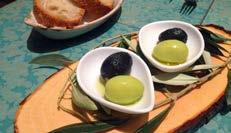
Tasty food is the wisdom and culture of the Spanish people. Something that our mothers and grandmothers used to make. I still remember the seafood pasta prepared by my grandmother.
Eduard Xatruch: Spain definitely has great culinary traditions, but the main thing is that for years many wonderful chefs have worked in this region and have brought up several generations of chefs like Pedro Subijana or Juan Mari Arzak. Everything changed with the arrival of Ferran Adria. The most important thing is probably free thinking. It is not necessary to make a dish as it is done traditionally. An important factor is that people in this region are open to new things.

Often chefs work alone and do not want to divide power in the kitchen. But the three of you manage it...


Oriol Castro: The main thing is to think creatively. We have been working together for 18 years and are like brothers to each other. Our main goal now is not to take care of our personal success but the success of our common restaurant. As for the "strange cosmic" food we create through molecular gastronomy, it is a necessary part of the business.
Not every dish is made that way in our restaurant. Today, going to a restaurant does not only mean eating food. People need a show. You need to amaze them. As soon as you stop being able to do that, you are in trouble.
Traditional food, where a chicken is like a chicken and fruits are like fruits, will of course never disappear. We eat that sort of food at home. You cannot thrive on the show alone but a creative
I even published a book with my mother. My mother made the food that made me who I am today. I began cooking with her. I made cakes (laughs) ... These are my best memories. The ones where I was making a lemon tart with her. I do not use the same recipes directly but they are the sources of my inspiration. I love home-made, warm, real food.
The technologies should make the food tastier. We study a lot; it is a scientific work and after that you need to choose what are you going to use and what you are not.
RESTAURANTE MARTIN BERASATEGUI
Three Michelin stars
Loidi Kalea 4, 20160 Lasarte-Oria, Gipuzkoa, Spain

95 VOYAGER 7/2017
Martín Berasategui: I want to make people happier and one of the best ways to do this is to prepare very tasty food. This is something I can do with my hands and this sensation is the most important thing for me.
Every big chef is trying to invent something new. How far do you think a customer can follow you in such experiments?
Those who come to our restaurant have a special sensitivity to good food. They would not spend so much money otherwise –this is why it is often easy for us to set up a relationship with a customer. They know that this is not a restaurant where they fill up on food. For example, we serve one appetizer in a beer can with a chopped off top. Some think that we are simply having fun with it; some understand that we promoting recycling; and others think that we just preferred not to spend money on plates. In the end, the most important thing is that everyone will think that the dish itself was delicious, otherwise it has no point.
Ellen Arzac – daughter Juan Mari Arzak, one of the pioneers, a legendary chef; chef at the Arzak restaurant.
You have said that you would never give a customer a dish that is not tasty. What do you mean when you say "tasty" –what does this word mean for you?
Taste is what we create in the first place. After that, you can invent a concept or philosophy. Sometimes a dish may be very beautiful but does not have an ideal taste.
When me and my father cook, the taste should be ideal, not for you, but for us. And our demands are very high. Understanding what is tasty differs from country to country. It may mean different things in Georgia or in Iceland when they say "tasty". We do have very good cuisine in Basque, but it is probably an average taste standard and acceptable to everyone.
ARZAK
This restaurant is considered one of the main attractions of the Basque Country and specifically San Sebastian. It is closed on Sunday and Mondays.
Juan Mari Arzak – probably the most famous Basque chef, and the patriarch of modern Spanish and specifically Basque cuisine – has held on to his three Michelin stars since 1989.




Chef’s menu: Starting from 160 € (per person)

Av Alcalde Elósegui 273, San Sebastián
Your style of relationship with food is very romantic. I think that such a tender attitude towards food is characteristic of your family – your brother talks about wine the same way…
I do not know where to start. This idea comes from our tradition, our history, the landscape of our country, our traditional family. Our mother, who has her own restaurant, cooks every day and we have dinner together.
This is the idea of labor, hospitality and brotherhood. We are very fortunate that Josep is a sommelier and Jordi prepares desserts. It is very easy for us to work together and it helps to create the romantic attitude we have towards food.
96 VOYAGER 7/2017
This three-Michelin star restaurant in Catalonia is owned by three star brothers. Juan is the chef, Josep the sommelier and Jordi the dessert master.
Juan Roca, Chef
GASTRONOMY
You are preparing food that cannot be recreated. These are not the kinds of dishes I can repeat if I had a recipe. This is an inaccessible height. When you cross new borders, do you sometimes control yourself – do you look back?
Sometimes I start to think that everything has already been done, invented, what else could we do?! But we still come up with something... every time it is a discovery. This is the most important thing in any kitchen. This is a new challenge – the new border that we cross. We are not conformists, we are creators and that is a constant challenge for us.
This is a very difficult profession, which implies physical stress. It is impossible to do this thing without passion? Where do you get the energy to go on working continuously?
There are three of us and that is important. It is the power of three that drives us forward. If one is sleeping, the other 2 will be working (laughs). Our brotherhood gives us energy and strength. The most important thing for my mother is that we are working together again and not how many Michelin stars we have.

Three Michelin stars


Can Sunyer 48, 17007
Girona
Judging by the results of this congress, food as we traditionally perceive it will no longer exist. You are a sommelier, and food and wine have gone “hand in hand” together for centuries. Can such radical a change in the concept of cuisine change the role of wine, and create a need for new drinks to be paired with new cuisine?
We have new ideas and, for instance, have already made fig and honey wines to be paired with certain dishes, but these are only experiments. I think we should abolish everything we have changed so far in the wine industry (laughs). This is a field where nothing should be touched. Many things have already changed for the worse in oenology. Now we must to try and restore the health of the soil and the intuitive spirit of our profession.
That is what I liked in Georgia. Your tradition of aging wine in Qvevri – that is pure gold.

This is what takes us back to the archaic roots of this craft. This wine contains the wealth and history of your country. This is what we – the prospectors of exclusive wines – are trying to find all around the world. After my visit to Georgia, we presented several varieties of wine from Georgia in our restaurant (the Roca brothers’ wine cellar is very special and known around the world, along with their unique dishes).
One must listen to the soil in this craft. We need an ecological revolution. I love wine and therefore I am interested in what's behind this wine – what its history is. The main reason for my trip was to discover the polyphonic essence of this wine – to learn the truth and your traditions. This simplicity, which is the most true attitude that one can have towards wine, still exists in Georgia.
97 VOYAGER 7/2017
Josép Roca, Sommelier
El Celler de Can Roca
SAN SEBASTIAN
Among the main charms of San Sebastian, or Donostia, is its unique location. This most beautiful Basque city is located in the northwest of Spain, near the French border. The geography of the old town, Parte Vieja, is a complex combination of typical small Spanish streets surrounding the main square, Plaza Constitución.
In the 19th century, this seaside town became a favorite destination for members of high society, who came here to enjoy the sunshine and experience the healing properties of the sea water. The traditional evening walk was a unique opportunity to show oneself in society, and the countless cafes and terraces were filled with aristocracy. San Sebastian turned from a small fishing town into a cosmopolitan city, which created a need to build modern and luxurious buildings for noble and demanding clients.
The broad European streets and bourgeois houses of the new city are influenced by French architecture. The city has three unique beaches: the elegant shell-shaped La Concha, with Santa Clara Island located at its heart; the relatively small Playa de la Ondarreta; and Playa de la Zurriola, favored by surfers. The city is divided in half by the Urumea river, which has several beautiful bridges.
Today, San Sebastian is associated around the world with the Basque revolution and modern Spanish cuisine. There are several Michelin starred restaurants in the city and its surroundings, and the refinement of the local delicacy pinchos exceeds expectations.


HOTEL MARIA CRISTINA

The city's construction boom coincided with the Belle Epoque period, and today most of the buildings that surround La Concha, including Hotel María Cristina, are built in this style. This beautiful hotel was designed by French architect Charles Mewes, who also designed the Ritz hotel in Madrid.
The convenient location of the building near the river and bay, along with the sophisticated architecture, made Hotel Maria Cristina a favorite destination for the world’s high society. The regent of the Spanish kingdom, Maria Cristina, was the first guest to step into her namesake hotel in July 1912. In 1953, the hotel hosted the grand opening of the first San Sebastian
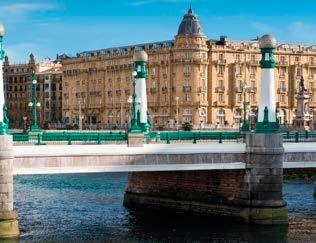
film festival, and since then, it has welcomed famous stars such as Elizabeth Taylor, Betty Davis, Woody Allen, Julia Roberts, Richard Gere and Brad Pitt.
Price: starting from €450 República Argentina kalea 4

98 VOYAGER 7/2017
The antique fishing town of San Sebastian was chosen by Queen Maria Christina as her summer residence at the turn of the 20th century and it suddenly turned into an aristocratic resort.
HOTEL DE LONDRES
Hotel de Londres was founded more than 100 years ago. This 4-star luxury hotel is right on the sea front and offers marvelous views. The hotel has been visited by Henri Marie de Toulouse-Lautrec, Elisabeth Marie, daughter of the Archduke of Austria, David Strauss and spy Mata Hari.
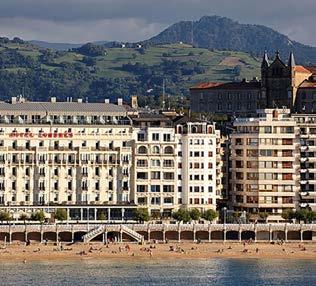
Currently, there are 167 rooms in the hotel, including 11 suites, and several great salons, including the Bristol, Wellington, Windsor and Victoria, which together form the so-called Britannia Hall. Guests also have access to the Swing bar and Mari Galant Brasserie restaurant.
Prices: starting from €250
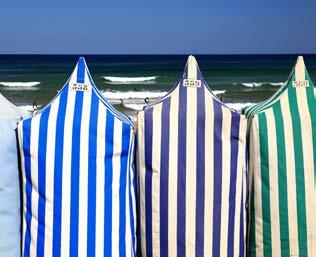
Zubieta kalea
The San Sebastian International Film Festival was founded in 1953. It is the most important film festival in Spain and Spanish-speaking countries. Jazzaldia is one of the most important jazz music festivals in Europe.

COMMENT
Noventa Grados exquisite clothes from the famous European designer, accessories, perfumes and a an excellent hair salon all located on the same premises. Closed on Mondays.
Calle Mayor 3
Berriz interesting choice of products from French designers.
Getaria kalea 20
Alboka store selling handmade Basque souvenirs.
Constitución Plaza 8
The climate of San Sebastian is moderately Oceanic. The summer is not as hot here as in the south of Spain, and the temperature rarely rises above +25°C. The best period is from May to September. Many Europeans chose to spend their holidays here, attracted by the exquisite beaches, beautiful architecture, magnificent nature and cuisine. The closer to the coast, the stronger one can feel the spirit of the Atlantic. San Sebastian is on the shore of the Bay of Biscay, where the water warms up well in the summer and attracts sea- and sun-loving tourists.
San Sebastian Aquarium – museum of the city's naval history and an impressive little museum in located fishing district. This is a great place for both children and parents.

Open: every day - 10.00-19.00
Plaza de Carlos Blasco Imaz 1
LA PERLA
The history of San Sebastian as a resort began in 1912 when Queen Maria Kristina and her aristocratic circle decided to take advantage of the balneological properties of the ocean’s thermal waters. A beautiful new city was built with a light French architectural influence and a unique spa that has attracted numerous tourists for more than a century.
The La Perla center was built on La Concha, the main coastline of the city, which is shaped like a sea shell. Hence La Perla,
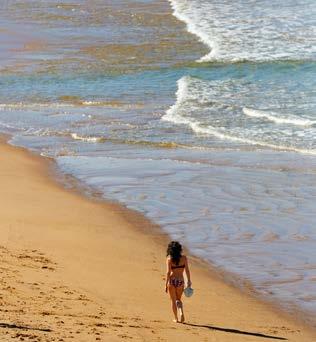
or the pearl, is located at the center of La Concha. This spa offers unique hydro-massage pools and high-quality aesthetic medicine services. It uses real ocean water, heated and cleaned.
La Perla San Sebastián Kontxa Pasealekua
99 VOYAGER 7/2017
SAN SEBASTIAN
RECOMMENDS
Txikiteo, or bar hopping, to eat pinchos with Txiki (small beers) or Txakoli wines has gained world gastronomic importance in San Sebastian. The sophistication of the pinchos and the quality of the ingredients are brought to the highest level here. The most important thing is to go beyond whatever is offered on the bar stands and try the dishes that each bar is proud of. Get to know San Sebastian’s golden five gastronomical bars, scattered around the old town district of the city.
The average price of a pincho is from €3 to €5.


GANDARIAS
This traditional bar is always crowded and is favored by locals. You should try the risotto de idiazabal con hongos (risotto with idiazabal cheese and mushrooms); tartaleta de txangurro (crab tartlet); solomillo (sirloin steak pincho and a Rioja of the barman’s choice).
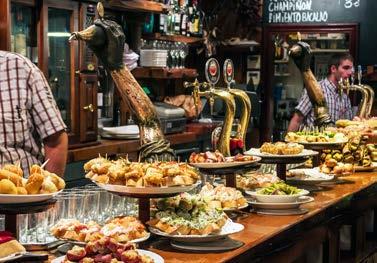
Calle 31 de Agosto 23
San Sebastian is, first of all, a gastronomic mecca. The city is distinguished by its excellent location: the ocean provides it with a variety of seafood, while the surrounding mountains are rich in pastures and thus high-quality meat and dairy products are readily available.

LA RAMPA
LA CUCHARA DE SAN TELMO
Here, there are no pre-made pinchos laid out on the bar, so you should order yourself, and we suggest that you try everything.
Calle 31 de Augosto 28
ZERUKO
This bar offers a modern variation of pinchos that have undergone a gastronomic transformation. Do not be alarmed if instead of traditional pinchos you get to try abstract works of art in food form.
Kalea Pescaderia 10
ATARI
Atari, located in the shadow of Santa Maria cathedral, is one of the city’s most important bars. Here, the chef creates non-traditional pinchos, and unforgettable gin + tonics are available as well! Make sure to try foie plancha (grilled foie gras), salmon curando en casa (home pickled salmon) and the legendary carrilleras guisados con su salsa (slow cooked beef cheeks).
Calle Mayor 18
GANBARA
This legendary bar is for lovers of mushrooms. Unique seasonal products are on offer, including unforgettable mini croissants baked on the spot with ham and white asparagus.
Closed on Sunday evenings and Mondays. San Jeronimo 21
The fishing district is full of restaurants, the most famous of which is La Rampa, known for three dishes: txopitos (grilled mini calamari), gambas a la plancha (grilled giant prawns), and unforgettable rodaballo (wild plaice). Perfect if paired with cold txakoli.
Price of dinner: €100 (for 2 persons)
Kaiko Paseolekua 26
SALTXIPI
This restaurant, which follows family traditions, is headed by the second generation of chefs, brothers Gorka and Jon Ortega.
This place is famous for txangurro al horno (oven-baked crabs), though other varieties of seafood are no less important, for instance rodaballo a la brasa and steak txuleta a la brasa, which they make wonderfully on a grill using a secret family recipe.
Dinner price: € 100 (for 2 persons)
Calzada Vieja de Ategorrieta 3

100 VOYAGER 7/2017
SAN SEBASTIAN
POPULATION SIZE: 46 069 212
69% SPANISH
18% CATALAN
8% GALICIAN
2% BASQUE
THE LARGEST CITIES: MADRID – 3 165 541
BARCELONA – 1 608 746 VALENCIA – 790 201
SPAIN IS CONSIDERED ONE OF THE LEAST DENSELY POPULATED COUNTRIES IN THE WORLD.
ITS POPULATION DENSITY IS 202 INHABITANTS PER SQ. MI.
THERE ARE 500 000 ROMA IN SPAIN; HALF OF THEM LIVE IN THE SOUTH OF THE COUNTRY. THE ROMA MOVED HERE IN THE 15TH CENTURY FROM INDIA.
SPAIN RANKS FIRST IN THE WORLD IN NUMBERS OF ORGAN DONORS.
THERE IS A TILE IN MADRID’S PUERTA DEL SOL SQUARE CALLED KILOMETRO CERO (THE ZERO KILOMETER) – IT COULD BE THE STARTING POINT FOR ANY JOURNEY. IT APPEARED IN THE 18TH CENTURY DURING THE REIGN OF FELIPE V.
SPAIN HAS THE LARGEST GOLD MINES IN THE WORLD. IT IS ALSO ONE OF THE MOST IMPORTANT COUNTRIES IN TERMS OF GRANITE AND MARBLE MINING.
SPAIN REMAINED NEUTRAL DURING WWI AND WWII BUT WENT THROUGH A DEVASTATING CIVIL WAR IN 1936-1939, WHICH CLAIMED THE LIVES OF 500 000 PEOPLE.
SPAIN
TOTAL AREA OF SPAIN IS 504 782 SQ.KM.
SPAIN IS THE MOST MOUNTAINOUS COUNTRY IN EUROPE. MOUNTAINS COVER 80% OF ITS TERRITORY.
LOCATED IN THE VERY MIDDLE OF SPAIN, MADRID IS THE “HIGHEST” CAPITAL ABOVE THE SEA LEVEL ON THE CONTINENT (667 M).
TABERNAS - THE ONLY DESERT IN EUROPE IS LOCATED IN THE PROVINCE OF ALMERIA IN ANDALUSIA.
GNP OF SPAIN FOR THE PREVIOUS YEAR WAS 1.252 TRILLION USD
GNP PER CAPITA WAS 30 465 USD
THE EXPRESSION “BLUE BLOOD” WAS COINED IN SPAIN.
THE LOCAL NOBILITY COULD BE RECOGNIZED BY THEIR PALE SKIN WHERE THE BLUE VEINS COULD BE DISTINGUISHED.
THEY ALSO EMPHASIZED THAT THEY, UNLIKE COMMON SPANISH PEOPLE, HAD NO MOORISH OR AFRICAN BLOOD IN THEM.
THE EARLIEST CAVE PAINTINGS WERE DISCOVERED IN THE EL CASTILLO CAVE. IT DATES BACK 40 000 YEARS.
THE ALTAMIRA CAVE IS FAMOUS FOR ITS CAVE PAINTINGS, CALLED THE “SISTINE CHAPEL” OF THE PARIETAL ART.
SPAIN HAS THE LARGEST QUANTITY OF BEACHES IN THE WORLD (200). THEIR TOTAL LENGTH SPANS 8 000 KM.
SANTA MARIA DE LA SEDE IN SEVILLE IS THE LARGEST CATHEDRAL IN THE WORLD. IT WAS BUILT FROM 1402-1519. ITS LENGTH IS 126.2 M, WIDTH – 82.6 M, HEIGHT OF DOME– 30.5M.
THE FIRST HIGH SPEED TRAIN IN THE WORLD WAS THE SPANISH TALGO
THE SUN SHINES FOR 3,000 HOURS IN SPAIN ANNUALLY; THE CENTRAL AND SOUTH-EAST REGIONS HAVE A SUBTROPICAL CLIMATE WITH A DRY SUMMER (+18°C - +28°C) AND A MILD WINTER (+8°C - +12°C). THE AVERAGE ANNUAL TEMPERATURE ON THE COASTLINE IS 22ºC.
101 VOYAGER 7/2017
CORRIDA
TEA GVASALIA
The bull has been worshipped on the peninsula inhabited by the Iberians as far back as the Bronze Age. It was considered a sacred animal and only the priest had the honor of sacrificing a bull and in accordance with a strict ritual. The bull sacrifice lost its religious importance in the following period but instead gained a military one. While Spain was occupied by the Arabs, Spanish knights went through military training by fighting bulls, which at that time required strength, dexterity and good handling of both sword and spear. The Reconquista ended in the 15th century, which meant that the Arabs were finally banished from the peninsula.
Bullfighting became a favorite spectacle of high society in united Spain. But back then the knight – or caballero – fought the bull on horseback. Such fights were usually held on a "Plaza Major" or the main square of large cities. Coronations and unpleasant public burnings of heretics were held on the same sites.
In the 16th century, Pope Pius V banned bullfighting and threatened to excommunicate those who did not obey him. The King of Spain, Felipe II, who was a big fan of bullfighting, convinced the Pontiff that it was not mere entertainment but a place to forge real knights.
Felipe V was of a different opinion. The descendant of the French Bourbons considered the fights between a horseman and a bull to be plebian entertainment. No one dared to contradict him or risk being seen as a lame Spaniard in the eyes of his French Majesty.
Corrida was revived in Andalusia in the 18th century but had turned into a form of amusement for poor Andalusians. At that time, no Andalusian peasants in their right mind would have spared a horse to fight a bull, even if they had one to begin with. Thus young people had to fight a raging bull on foot in the village squares.

TRADITION
102 VOYAGER 7/2017
The rules of bullfighting were established over the following decades and have barely changed ever since. The first half of the twentieth century is considered to be the golden age of this spectacle. Mаtadors – Josе Gomez, Juan Belmonte and Rafael Gonzаlez – became national heroes, and Corrida even spread to South America.
After Ernest Hemingway traveled to the capital of Navarre, Pamplona, he was inspired by the Fiesta dedicated to the city's patron saint, San Ferminа, and upon returning wrote the novel "The Sun Also Rises (Fiesta)". American women became entranced with the brave, handsome and hot-blooded matadors. Ava Gardner, Rita Hayworth and Lauren Bacall were the successive lovers of Luis Miguel Dominguin – a famous matador of the time. Ava Gardner also had an affair with the attractive Mario Cabre, who between bullfights acted in relatively successful films.

Corrida is conducted in specially designated arenas. The largest arena - Las Ventas - is located in Madrid and can hold 25,000 spectators; the oldest is in Salamanca (built in 1677). The bulls are brought up on special farms and should be at least four years old. Their weight should not exceed 450 kilograms. The show is divided into three parts.
In the first part, the matador and his companions enrage the bull using a special mantle. One side of the mantle is pink, the other yellow. The Picadors then come out onto the arena on horseback. They pierce the bull in the neck and its back with their spears. The bull then tries to ward them off. Often the bull manages to strike down a horse and the picador may fall off.
In the second part, the matador's assistants - banderilleros - come into the arena on foot. They strike the bull in the back with small spears - banderillas. These banderillas are often decorated with the colors of the Spanish or Andalusian flags. Sometimes the matador takes the function of banderilleros onto himself.
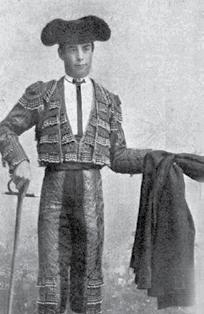
The matador has 10 minutes for this job. If he cannot get it done in this time, he receives the first warning; a second is given another three minutes later, after which he is given two additional
minutes. If he is unlucky and cannot finish the task in those two minutes, the bull it taken away from the arena and the disgraced matador is jeered off the arena floor with whistling and pillows thrown at them.
When the matador does everything in a beautiful and clean manner, and pleases the crowd with dangerous moves before finally killing the bull without their hands shaking, he gets the bull’s ear as a reward. Two ears is a higher reward. If the matador is also allowed to cut off the bull’s tail, it means that after the corrida is over, they will be carried out on the spectators’ hands from the arena. Six bulls participate in each corrida.
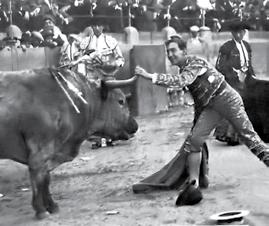
than a bullfighting arena. The beautiful arches give the tribunes a unique look; at 66-meters in diameter, this is the largest arena in the world.
The most famous matador of all time - Pedro Romerotook part in the first bullfight held here.
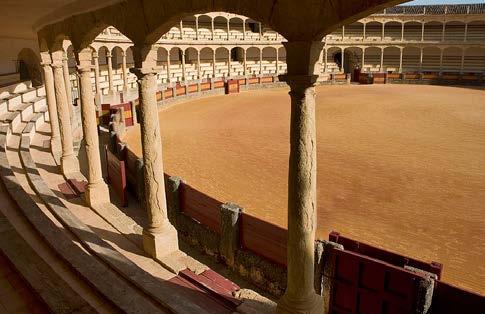
On the bicentennial anniversary of his birthday, in 1954, a festival was founded which is still held at the beginning of September of each year.

It is called Corrida Goyesca de Ronda or the Rondo Goya style Corrida, and is distinguished by the fact that the matadors wear the clothes from the Goya period and fight the bulls in the respective style of that period. Ticket prices vary between 70 and 160 euros.
There has been a school for future toreros in Ronda since 2000. Currently they have 30 students. The youngest is seven years old; the oldest is twenty.
One of Spain's oldest and most beautiful corrida arenas is located in RONDA, near
Malaga. It was opened in 1785 and looks more like the palace of Carlos V in Granada
1. Jose Gomez
2. Ava Gardner and Luise Miguel Dominguin
3. Rafael Gonzalez
1 2 3
103 VOYAGER 7/2017
THE THIRD PART IS DEDICATED TO A SOLO OUTING BY THE MATADOR. FIRSTLY, HE IRRITATES AN ALREADY ENRAGED AND TIRED BULL WITH A RED MULLET, AND THEN KILLS IT WITH A SPECIAL SWORD – ESTOC.
The meat of the killed bulls was distributed to the poor and to hospitals in the past; now it is sold to restaurants but it should be noted that it does not taste particularly good. The life of modern matadors is a favorite topic in the Spanish yellow press and public discussions. Like soccer players, many companies select matadors to be the face of their products, and they spend as much time on ad shootings as they do in the arena. Jose Mari Manzanares, Cayetano Rivera Ordусez or Enrique Ponce pose in front of camera better than models. The latter is considered to be one of the richest matadors with his wealth estimated at 58 million USD.
A 29-year-old matador Victor Barrio died on the Teruel arena in 2016. This was the first case in the last 30 years when a fight between a bull and a man ended in the death of the latter.

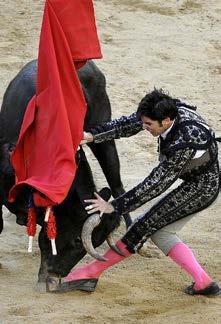
MODERN SPANIARDS ARE NOT VERY MUCH IN FAVOR OF CORRIDA; 82% OF THEM ARE INDIFFERENT TOWARDS THE SPECTACLE. ARENAS ARE FILLED WITH TRAVELERS ALONG WITH A FEW LOCALS.
Corrida season starts in Spain in late March and lasts until mid-October. The ticket price ranges from 6 to 200 euros. The prices are determined by the arena, the matadors that participate in the corrida, and their place on the tribunes. Seats are divided into two main parts: one part is called "Sol", the other "Sombra".
The seats on the sunny side, or the "Sol", are much cheaper than those in the shade or "Sombra". In Madrid, in "Las Ventas" the cheapest ticket is 6 euros, and the most expensive is 150 but it depends on the date and participating matadors.
It is better to book a ticket in advance online. The best sites for this purpose are tauroentrada.com and toroticket.com.
You will not be able to attend a corrida in Barcelona; this spectacle was banned by the Catalan government in 2012.
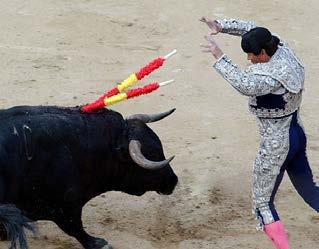

In the first part, the matador and his companions enrage the bull with a special mantle. One side of the mantle is pink, the other yellow.
Picadors pierce the bull in the neck and back with their spears. The bull then tries to ward them off.
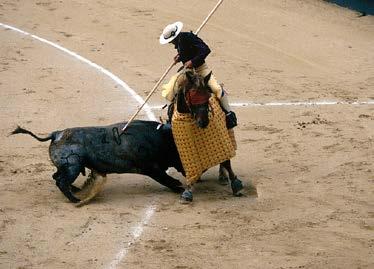
La Chaquetilla
A short and rigid jacket, with shoulder reinforcements, with an open cut of the sleeve to allow the free movement of the arms.
La Taleguilla
High-waisted, narrow and close-fitting pants which cover down to the knees. They are held up with suspenders and decorated with stripes and tassels.
Las Medias
This set of socks is comprised of white cotton inner socks and outer pink silk socks.
A very narrow tie.
The winning toreador receives the bull’s ear as a prize.
La Montera
An Astrakhan fur hat, worn by a matador and all the members of his team. The hat is usually worn during the first two-thirds of the show.
Las Zapatillas
are low-rise black boots that are decorated with a bow.
TRADITION
El Corbatin
104 VOYAGER 7/2017
FIESTA IN PAMPLONA

Fiesta has been held in Pamplona for eight centuries and continues for a week. It begins at noon on the day before San Fermin’s day, when they fire a so-called chupinazo (a rocket) from the balcony of a municipality building constructed in the 16th century. The cult running of the bulls takes place on San Fermin’s day.
This event simultaneously inspires fear and joy with excitement and causes rushes of adrenaline in both the participants and spectators of the ritual.
The first race is held on July 7 at 8 a.m. Each day of the festival begins in the same manner with only one run per day. Following a crazy marathon, the streets of the city are filled with dancing and joy. This event essentially consists of three different celebrations – the remembrance day of the saint, the large annual market, and the fiesta.
A special two-sided fence is built along the entire route in order to direct the bulls. It is built so that a person could fit in between the planks but not the bull. The next line of defense is built for the spectators.
The runner participants hide between the first and second fences.
A church service is carried out before the run, accompanied by chanting and receiving blessings, ending with the exclamation “Viva San Fermin! Gora San Fermin!” The participants of the run are traditionally dressed in white shirts and white

Anytime you travel to Spain, you will find yourself at one of the celebrations, which are characterized by the spectacle of corrida – the bright costumes, large-scale performances and emotional energy.
pants; they have a red belt and a tie the same color. In their hands, they hold a newspaper – their only means of defense against the bull. It is forbidden to swing anything else than the newspaper at the bull, or ward the bull off with your hands.
As a rule, no race ends without injuries - 200-300 come back from the celebration with cuts or bruises. Since 1974, the participation of women in the run has been banned. The squash created near the arena, where the streets narrow and a chaotic state is created is also dangerous, as the bulls trample and gore people.
The best places to watch the spectacle are the balconies but you need to plan getting there in advance as millions of others want to get there as well. Ernest Hemingway perfectly described the Pamplona Fiesta in his book "The Sun also Rises (Fiesta)".
105 VOYAGER 7/2017
-14 JULY
The duration of the whole run is four minutes and the corridor is 826 m long. It all takes place in the central streets of the city (Santo Domingo, Town Hall Square, Mercaderes and Estafeta).
6
OBSESSED WITH FLAMENCO
SALOME DADUNASHVILI
Conspirators gather in the Andalusian night for the last supper; they sing. They are united in a circle, banging the metal heels on their shoes and snapping their callused fingers. They encourage each other with raspy voices that are used to screaming, sometimes sounding like a sigh and sometimes like a whiplash. They have to endure this night, withstand another dark song about love and then it will be dawn. Just one more and then they will go home before the rooster sounds trice.
This is how the Flamenco-obsessed sing and cry in the Andalusian night. Women spread their hands, covered in scarves with silk tassels, like birds of paradise. Flowerembroidered textiles hug their hips or fly up in the air. The scarf is like a naked blade. It knows no mercy and is as deadly as Toledo steel. Voices talk to guitar chords in the coagulated Andalusian night. They whisper, scream, beg, and fight with the same passion as centuries ago, by the Roma fires, under the indifferent stare of the cold stars.
What do the Roma women sing about? The first wedding night, sheets covered in blood, proof of innocence, the honor or shame that this night brings. Doves wounded and headed towards the waterfront. They sing as if they cry, as if they continuously moan, but this moan is better than the silence, the moan

CULTURE
106 VOYAGER 7/2017
is a sound, a sound that shatters the walls of patriarchal silence. Waves of guitar chords, angry eyebrows, straight backs, and hands clutching fans with agony have been lost in the Andalusian night for hundreds of years. If you could just know the storm that those fans caused!
15th century was good.
Ferdinand and Isabella, driven by Christian passion, had completed the Reconquista. America, lost in the blue of the ocean, had finally been discovered. Old Byzantium was tearing apart at the seams and nobody wanted to get trapped under its ruins. This is when the Roma people came to Andalusia. They were persecuted everywhere; they had nothing but flexible limbs and strong voices.
Al Andalus opened its Mauritanian-Arabic-Jewish-Spanish arms, and Andalusian music, already over-saturated with a thousand spices, received one more passionate tune. This tune was like a glycinea, it hugged all sounds, all songs, put them all into its sweet rhythm and blossomed victoriously.
Still, the locals did not like the Roma people. They would not let them come close. The Roma people, on the other hand, were like free birds who enjoyed fruit in Granada gardens. They gathered strange rhythms and sang. For many years, their closed society – accepted at times, chased away at times – had been breeding and
rearing, cutting and grafting fruits of rhythmic songs. The fruit grew large; it was sweet and sour. It burned and made the eyes water like an onion.

Later, the fruit gained conscience, adopted rules and allowed strict sciences to study its ups and downs. It developed a system and started demonstrating strictness. Castanets ruin real flamenco. Flamenco is Flamenco only when there are no more than 20 people in the circle. It is not right to mix dramatic Flamenco song – cante hondo/jondo, cante grande and cante chico – with modern Flamenco. Scientists can’t even agree on its true origin.
FLAMENCO LIVES BY ITS OWN RULES. IT REIGNS IN JERES, SEVILLE, GRANADA, CORDOBA AND MADRID. IT IS DIFFERENT EVERYWHERE, SINCE IT IS ALIVE. IT IS A RHYTHM THAT PEOPLE BREATHED SOUL INTO CENTURIES AGO. IT DOES NOT WANT TO OBEY HUMANS ANYMORE. IT OVERTAKES, ENSLAVES AND PLAYS WITH PEOPLE. ITS FIRE MAKES THEM STAY UP ALL NIGHT, DANCING AND SINGING, MOANING IN PURE FLAMENCO RHYTHM.
107 VOYAGER 7/2017
ANDALUCÍA


The Andalusian spring is short, colorful and transparent as a morning. The fields burnt by the sun begin to blossom in wild colors in early April due to the heavy rains.
Soon the summer will come with its unbearable heat and small shards of coolness hidden in the blue shadows of the white walls. But in the spring Andalusia blooms and is entangled in the aromas of thousands of white flowers. The smell of the orange flowers in the streets is so intoxicating that it completely bewilders pedestrians, warmed up by the new sun.
Water bubbles up everywhere from hidden springs in small patios and small streams in closed gardens, perambulating and rejuvenating the brick-colored, almost red ground. Flowers sturdily climbs the walls as if to give themselves enough time to blossom before the burning summer heat comes and the condensed nights retain only the dry rustle of the palm trees.
Nowhere do they dance Flamenco as they do in Andalusia; nowhere do women sway their hips like this, nowhere do they ruffle their shawls with elongated silk brushes and nowhere do they stamp their feet with such severity as they do in Andalusia.
Carmen was probably like this, dancing by the fire in the blue Andalusian night and trampling the poor sergeant’s heart with her feet. The tobacco factory yard where Carmen threw the fatal flower at Jose still stands in Seville. Today there is a university there. Different dramas are played out in the beautiful patios and interior yards.
Andalusia borders the Atlantic Ocean on one side and the Gibraltar Strait and Mediterranean Sea on the other.
The best time to travel to Andalusia (if you want to witness the blossoms) is from the end of March to the beginning of April. At this time, the average temperature reaches 22-25 degrees Celsius. The tourist season continues until June. After that, troubled by the unbearable heat, the Andalusians themselves try to get away from here. Everything is closed during the day and life only begins at night.
108 VOYAGER 7/2017
Mulhacen - the highest peak of the Iberian Peninsula (3478 m) - overlooks it from the Sierra Nevada range. This unique geographical location was the reason for the inception and flourishing of such a unique culture in the Iberian Peninsula, which still surprises us with its openness and tolerance.
Andalusia is a word of Arab origin, like almost everything in this wonderful land, but mixed with Jewish and Romance cultures.


By the year 713, Muslims had conquered most of the peninsula and often without any bloodshed. The Arabs retained the titles, lands and influence of the local rulers in exchange for the recognition of the hegemony of the Damascus Caliphate; nobody was forced to change their religion but in the first decade of occupation the population was actively moving to Islam. This was particularly convenient for slaves, servants, artisans and merchants who found new freedom and rights to own property.
The population spoke Arabic for centuries and called the Mediterranean the Syrian Sea but
in return had all of the wisdom and scientific achievements of the Islamic culture at their disposal.
This knowledge was more prevalent in the medieval darkness of Europe, so Andalusia flourished with all the colors of oriental glazed tiles.
In 1492, the dream of Ferdinand and Isabel was finally achieved: Granada fell and the last Emir escaped from Spain.
The most impressive religious parades are held in Andalusia. Two weeks after Easter, the Seville Fair or the open market celebration begins. Everyone wears flamenco costumes and travels around the city on horseback.


109 VOYAGER 7/2017
ANDALUSIA
ONE OF THE OLDEST AND POSSIBLY THE OLDEST CITY IN EUROPE, CADIZ, IS LOCATED IN WESTERN ANDALUSIA.
Muslims and Jews who did not want to convert to Christianity were banished from the country, and the rest were declared vassals of the Catholic monarchs. However, Andalusia had such strong foundations that instead of surrendering, it influenced the culture and architecture of Spain for centuries to come.
There are three important tourist areas in Andalusia: Granada with the Alhambra - the medieval palace of Islamic Architecture and the only one of its kind left in the world; Cordoba with its unique mosque/cathedral; and Seville with the unique Alcazar, whose Moresque interior is recognizable from its usage in the “Game of Thrones” series. Cinema lovers too will recognize the glazed tile walls of Alcazar from “Lawrence of Arabia”.
Travelling between the cities is not difficult. Even if you do not plan to rent a car, you can do it easily. Spain has a very flexible and comfortable system of buses. You can easily move between these cities for only 12 euros. Tickets can be purchased at the station. Buses leave several times a day so you should have no trouble buying a ticket. If you want to plan everything in advance, you can buy bus tickets online (www. busbud.com) but this will cost you at least 10 euros more.
It takes about two hours to travel between the cities. If you are going from Andalusia to Madrid, it is better to take a train. It's much quicker but you should book your tickets in advance as the prices increase substantially shortly before departure.

The bus and the train stations are astonishingly clean. This is where I would put a monument to the labor of the Spanish janitors who wash their country with soapy water from dawn until dusk and manage it perfectly. The cleanliness is really
impressive given the quantity of tourists. Despite the emotional and open nature of Spaniards in general, and especially Andalusians, the “freedom” to throw your trash on the ground is not granted here.
Andalusia is inhabited by smiling, beautiful and kind people but they tend not to speak English, so if this language is your chosen means of communication, it is better to work on your pantomime skills – they will come in handy. I hope that your trip will go as you want it because without seeing Andalusia, you cannot understand what Spain is.
In the 11th century, the Arabs brought the bitter orange to Spain as a medicinal plant. Wonderful aromatic mixtures were made of its flowers and the juice was used for treatments. The Spaniards fell in love with oranges and they become the national symbol of love and happiness. Currently, Spain ranks first in Europe in terms of orange exports.

SHOW "HOW THE ANDALUSIAN HORSES DANCE"


The unique show, "How the Andalusian Horses Dance", is an equestrian ballet accompanied by quintessential Spanish music and 18th century styled costumes, all put together and choreographed using movements based upon Classical Dressage, Doma Vaquera (countrystyle riding) and traditional equestrian chores. Each show consists of between six and eight different choreographies, with the same degree of difficulty and entertainment value and scheduled by the school according to the following repertoire: Fundación Real Escuela Andaluza Del Arte Ecuestre Av. Duque de Abrantes, s/n, 11407 Jerez de la Frontera, Cádiz.
Corrida was born in Andalusia in the city of Ronda. The Romero family are considered the founders. Ronda houses the largest corrida arena in the world (66m diameter) built in 1785.
110 VOYAGER 7/2017
SPAIN RANKS THIRD IN THE WORLD FOR WINE PRODUCTION AND FOURTH FOR CITRUS FRUIT PRODUCTION. IT ALSO PRODUCES 45% OF THE WORLD'S OLIVE OIL.
El Veleta is Europe's most southern mountain ski resort located in the Sierra Nevada mountains, 100 kilometers from the coast. The peak can be seen from Granada in good weather. Skiing is possible here until the beginning of May, and after the end of the ski season visitors travel here to see the highest observatory in Europe. Watching stars from here is a great pleasure, especially if you make a wish and see the sunrise from the height of 3,395 meters.

The 12-car exotic train is the best means to travel around Andalusia. The belle epoque design will create an inexhaustible mood for you. This cozy train travels between Seville and Cadiz with stops in Cordoba, Granada and Ronda. Passengers are offered excursions and dinner at each stop. On the way, naturally, they are served delicious dishes accompanied by live music. Most of the train cars date back to 1929, although the compartments, easily referred to as luxury class rooms, are fully in accordance with modern five-star hotel standards. That is why crossing Andalusia accompanied by the "clickety-clack" of this unique train is an unforgettable pleasure. The six-day trip costs between 900 and 3000 euros.

The Kingdom of Spain - REINO DE ESPAÑA – is a constitutional monarchy. The legislative body is Cortes Generales; the head of state is King Felipe VI. The Kingdom of Spain consists of 17 autonomous regions, as well as two autonomous cities, Ceuta and Melilla, located on the North African coast.
THE SPANISH/CASTILIAN LANGUAGE (Spanish, Castellano) belongs to the Ibero-Roman subgroup of Romance languages. The writing system is based on the Latin alphabet.
An underground cave complex spanning approximately 5 km was discovered in the vicinity of the city of Nerch in 1959. Sketches of a seal found on the walls of the cave created by Neanderthals date back 42,000 years. A music and dance festival has been held in these stalactic caves since 1961. Maya Plisetskaya, Montserrat Caballe, Mstislav Rostropovich, José Carreras and Kiri Te Kanawa have all performed here over the years.

The Costa Del Sol shoreline stretches from Tarifa to Cadiz. This is where the waves of the Atlantic Ocean and the Mediterranean Sea meet, creating ideal conditions for windsurfing and kitesurfing. Tarifa is the southernmost city of Europe. It is only 14 km away from Africa and is recognized as the capital of European surfing. It is also called the Spanish Hawaii. There are numerous beaches with golden sand in Costa de la Luz, but the most popular among them are Bologna and El Palmar.
Under Article 3 of the Spanish Constitution of 1978, the state language of the whole territory of the country is Castilian/ Spanish. In some autonomous unions, Catalan, Galician and Basque languages are equalized to the official language.
Aragonese and Asturian are only partially recognized officially. These languages are spoken in parallel to Spanish in the corresponding regions. The Catalan dialect is spoken in the Balearic islands.

The Spanish language ranks third in the world according to the territories where it is considered to be native.
APPROXIMATELY 548 MILLION PEOPLE SPEAK SPANISH and 20 MILLION LEARN IT AS A FOREIGN LANGUAGE. The largest Spanish-speaking population is in Mexico (120 million), and the largest Spanish-speaking country is Argentina. Nine out of ten Spanish-speakers live in the western hemisphere.
111 VOYAGER 7/2017
ANDALUSIA
The queen saw tiled roofs, cypresses and orange trees, listened to the water glugging in a small, four-leaf, flower-shaped pool, felt the scent of orange blossoms and myrtle, and most importantly, looked at the Granada that spread out in white on the opposite slope. Her loving husband, Muhammad V, built her the court of lions and decorated the domed ceiling of her room with 5,407 alabaster details... and beheaded 36 noblemen because he could not find out which one of them his wife had spoken to in the palace gardens.
THE EARTHY GARDEN OF EDEN
SALOME DADUNASHVILI
This is one of the legends of the Alhambra. Alhambra loves legends – it seems that the boiling nights of Andalusia awaken the imagination. However, the 12 marble lions, each with a different expression, still guard the pool in the lion patio. Each lion weighs 350 kg. Twelve is a symbolic number in Islam. Here, in this palace, they loved symbols and often repeated the name of God. The words “There is no victor but Allah” are inscribed 9,000 times on the walls of the Alhambra.
The court of lions is decorated with 124 marble columns; their heads and bottoms are surrounded with a lead circle. However, the columns are not fixed but can move. The genius of Islamic architecture took into account the seismic activity of the area. During an earthquake, the columns move but do not break. According to legend, the blood of the 36 beheaded nobleman, executed by the emir Muhammad lies at the bottom of the rust-colored pool. Possessed by jealousy and stoked by the hot Andalusian sun, Muhammad sacrificed the young men of all of the local noble families.
For centuries, the Alhambra has moved but has not broken either. It has been there since the La Sabika hill, inhabited well before the Roman period, was conquered in 1228 by the first emir of the Nasrid dynasty – the red bearded Mohammed I.
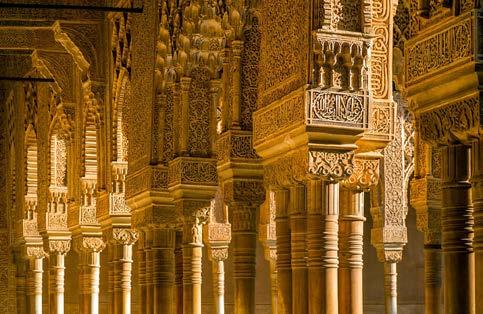



The name given to the castle was the same as the color of the first emir’s beard (Alhambra means red in Arabic). Its walls were painted white following an Andalusian tradition to retain the precious coolness.
Something attracted people there – probably the snowy mountain range of Sierra Nevada, which seemingly hang in the middle of the blue sky, or the merry twinkling of the orange trees, or

112 VOYAGER 7/2017
the streams that flow from the snowy mountains.
Mohammed I built a six-kilometer aqueduct in 1238, which nourishes the Alhambra gardens to this day. Soon the fortress began to turn into an elegant palace. The orange trees and myrtle shrubs, which in Islam are believed to be the plants from the Garden of Eden, were surrounded with stuccoed alabaster walls and marble tiles. Today, the alabaster is ivory colored but back in the day it was painted in all shades of Granada’s sky and earth.
The Queen's Eyes is the name given to a double-arched open window from which the queen used to enjoy the Granada landscape. The bougainvillea did not blossomed here back then, nor did the magnolias spread their heavy scent. Europe had not yet been introduced to the wild assortment of flora from the new continents.
Soon after, right here in the Alhambra, a few steps from the Queen’s room, under the star-studded ceiling of the Ambassador’s Room, made of 8,017 wooden details, a courageous adventurer bowed his head in front of Isabella and Ferdinand and received enough funds to finance an expedition.
Columbus was thereafter to travel to find the shortest route to India, filling the Alhambra gardens with exotic plants in the process.

Isabella and Ferdinand accomplished a long-time dream and conquered the Alhambra in 1492, ending the Granada Emirate and establishing Catholic rule.
Within 10 years, Isabella of Castile and Ferdinand of Aragon had turned all of the mosques into churches and forcefully Christianized the population; however, they were so fascinated with the Moorish architecture that rather than changing it, they spread the style throughout the region, known now as Muresque; it can be seen all across Andalusia and Castile.
Carlos V ordered the construction of a new palace in the Alhambra in 1526. The palace project was designed by Pedro Machuca, one of Leonardo da Vinci’s students. This unique building, squareshaped from the outside but with a circular inner yard, stood unfinished and without a roof until 1957 as Carlos V never made time to visit it. He was too busy reinforcing the boundaries of his empire on which the sun never set.
The creator, the architect of this world, is among the 99 names of Allah. Generalife means the paradise of the creator, and this truly is a garden of paradise. The Generalife gardens were planted in the 1930s and do not follow the rules of traditional oriental gardens.
An oriental garden is always hidden, locked away, placed between four walls, where only birds and water can reach freely.
The Alhambra ticket office opens at 9 a.m. and within 10 minutes every ticket is already sold. This palace is the most popular tourist destination in Spain so we recommend that you book your tickets in advance.


Getting into the Alhambra is not easy. You should buy the tickets online (www.alhambradegranada.org).
A guided tour costs 35 euros and lasts for 2 hours; it is very worthwhile. You can also buy an individual tour ticket which costs up to 100 euros. The regular ticket price is 14 euros. Children up to 12 years old are admitted for free.
Please keep in mind that when buying your tickets you should indicate the number of children; all visitors should have their own ticket. Ticket prices for children from 12 to 15 of age is 8 euros. You should strictly follow the time of the visit indicated on the ticket. Be by the entrance 15 minutes in advance or you might not get in.
113 VOYAGER 7/2017
“THERE IS NO VICTOR BUT ALLAH” – THESE WORDS ARE INSCRIBED 9,000 TIMES ON THE WALLS OF THE ALHAMBRA.
GRANADA
COMMENT
Granada is the capital of the eponymous province in the south of Spain on the slopes of Sierra Nevada - the highest mountain range on the Iberian Peninsula. Moorish, Gothic and Renaissance architecture is abundant in this region, the most distinguished being the Alhambra palace, the Generalife Gardens and the Albayzin Quarter from the Moorish period, all named world heritage sites by UNESCO.
Iliberri Municipium was located in Granada during the Roman period, which included a settlement called Garnata. In the eighth century, during the Arab rule, it was named Granada. In 1492, the Catholic Monarchs took over the city, concluding the liberation of the Iberian Peninsula.

CAPILLA REAL


In 1504, on the order of the Catholic monarchs, the architect Enrique Egas constructed the chapel in which Isabella of Castile and Ferdinand of Aragon are entombed. There are important pieces of art, jewelry, sculptures, and Flemish paintings preserved within, including the "Passion" triptych by Dieric Bouts, which is part of the Queen's collection and is the largest of the paintings preserved in Granada.

Visit this location: spring and summer opening hours are 10.15-13.30, 16.00-19.30; Sundays and public holidays - 11.00-13.30, 16.00-19.00.
Ticket price: 4 €
PLAZA DE ISABEL CATÓLICA
This square, located at the intersection of two of the most important streets of Granada (Calle Reyes Católicos and Gran Vía de Colón), is decorated with a monument of the Queen and Columbus. The figures are sculpted signing Columbus’ permit to travel to "India" through the western nautical way on April 17 1492. This document is also called the Capitulations of Santa Fe (Capitulaciones de Santa Fe).

GRANADA
CATEDRAL

The cathedral located in the city (Gran Vía) is considered to be the first religious building of the Spanish Renaissance. It was constructed on the orders of Isabelle of Castile in the vicinity of a former mosque. The five-nave cathedral was initially conceived as a Gothic project from 1563 the architect Diego de Siloe turned it into a work of Purism. The first chapel (Capella Mayor) is especially interesting.
Visit this site: Monday to Saturday - 10.45-13.30 and 16.00-20.00; Sundays and public holidays - 16.00-20.00.
Ticket price: 4 €
MONASTERIO E IGLESIA DE SAN JERÓNIMO
This monastery was founded by Catholic monarchs in Santa Fe in 1492; they later moved to Granada (in 1500). It was built in the royal garden of the seat of the Nasrid dynasty; Arabic stone was used in its construction. The main chapel is built in the Renaissance style, is cross-shaped and has one nave; it is topped with a gothic dome, adorned by side chapels and a magnificent octagonal facade.
PLACETA PUERTA DEL SOL
The Solar Gate - this remarkable arched building resembling a pacillion stands on a small square in the Realejo district. A beautiful view can be observed from there and an old washing basin remains inside.
114 VOYAGER 7/2017
ALBAICÍN
This is the oldest district in the city where the traditional Andalusian style is dominant. Old castle walls (Murallas) remain in this UNESCO world heritage district.
Visit this site: Every day in Summer - 10.00-13.00
VENTA EL GALLO
Flamenco, like Andalusia itself, combines dance and music from all cultures, starting with the moors and Roma and ending with classical ballet, which resulted in a unique style that cannot be mistaken for anything else. One can attend a Flamenco concert anywhere in Andalusia.
Venta El Gallo is one of the best places if you want to see the real Roma Flamenco in Sacromonte. Attending the show will cost 65 euros including dinner; this includes a glass of an alcoholic beverage and transportation to and from your hotel. Make sure to book the show online in advance.
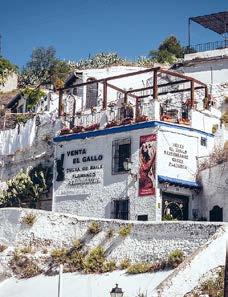
Camino del Sacromonte 5 www.ventaelgallo.com
MEDIEVO
On the opposite side of the cathedral, you will find yourself in a world of amazing delicacies: the most distinguished tea, spices, varieties of dried fruit and flowers, artisan chocolate and other delicacies that you can try or buy as a gift.

Pasaje Diego de Siloe www.medievogranada.com
ALBOREA SOUVENIRS
Here you can purchase the best quality souvenirs; there is an extraordinary range of accessories painted with local ornaments.

Cuesta de Gomérez 42 WWW.alboreasouvenirs.com
CUEVAS DEL SACROMONTE
In order to get to know Sacromonte – a Granada district set on one of the city’s hills and decorated with narrow streets and white houses – you should visit the Ethnological Museum. The site features the oldest local crafts. An exhibition of the caves cut into the rocks depicts the lifestyle of the Roma who lived here in the 16th century.
There are still dwelling caves here – cuevas located on the terraces across the hill. Most of them are equipped like contemporary apartments, taking advantage of all of the benefits of civilization. The main thing that the dwellers of these caves value is the cave climate and the constant temperature (20-22˚C), which does not change in the summer heat or the winter cold.
WASHINGTON IRVING HOTEL
This hotel is located right by the entrance to the Alhambra palace, boasting the best view of Granada from its pool and terraces. Downtown is just a five-minute walk away. The hotel restaurant has an excellent breakfast and delicious desserts. Price for a standard double room: starting from 250 €
Paseo del Generalife 10
MIRADOR DE MORAYMA
A beautiful view can be enjoyed from this restaurant located in Albayzin – the oldest Moorish district.
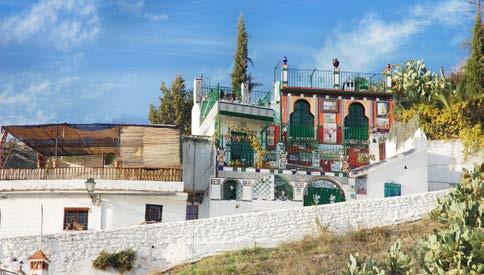

There is a wide range of local dishes and wines to choose from. The dishes are an ideal blend of local cuisine and Moorish influences.
The best courses on the menu are the traditional family appetizer of smoked ham and sheep cheese with rosemary; "Moriyama" salad; oxtail croquettes; grilled red tuna with tomato jam and garlic sauce; and fried fillet mignon with pepper sauce. For dessert, have a cold coffee with cream and ice; mint tea; or organic wine from Alquería de Morayma.
Prices: Chef’s menu for two persons (including dessert and a bottle of wine) - 105 €
Pianista García Carillo 2
www.miradordemorayma.com
115 VOYAGER 7/2017
GRANADA
Andalusia's capital Seville became famous around the world in the 19th century owing to its architecture and cultural heritage. It became a “must stop” on the romantic European Grand Tours – those luxurious trips that only the aristocracy of the rich countries could allow themselves. Since then, Seville has been a dream destination for world travel lovers.
SEVILLA COMMENT

The best time to travel to Seville is the spring and the autumn. Winter here is moderately cold but the summer is so hot that the only "activity" you would want to join is the daily siesta.


A characteristic tradition of Seville is taking pictures with the doves in the city. The best place to do so is Maria Luisa park.
PLAZA DE ESPAÑA
This architectural ensemble was built in 1929 in the Neo-Moorish style for the Ibero-American exhibition. The large square should have reflected the unique peculiarities of Spain's development. The territory of Maria Luisa park was used for this. It was created based on a plan by French landscape architect, Jean Claude Forestier, and ornamented with unique structures.
On the edge of the park, the architect Anibal González designed a semi-circular square with an immense fountain. The square has a similar semi-circular structure in which the Mudejar style is combined with Art Deco. The most distinct element of the square decor is the inwardly bowed niches of the building, which are decorated with traditional gently impressed tiles.
PARQUE DE MARÍA LUISA
Maria Luisa Park is the main green space in Seville, where city residents or guests spend the most time. It was given to the city by Infanta Maria Luisa. It has been revived since 1929.

It was turned into a cozy, romantic garden with wide alleys, pavilions and greenery. The park, decorated with reservoirs and stylized shrubs, stretches across half a kilometer. There are many statues of famous people here. One corner of the garden is dedicated to Miguel de Cervantes and is decorated with sizable illustrations of scenes from "Don Quixote".
Entrance is free.
Open: every day - 8.00-22.00
Calle Pje de las Delicias
Carriages are a fun, romantic and fast-paced way to tour Seville. The official stop of the carriages is on the eastern side of the cathedral, at Plaza del Triunfo.
A 35-40-minute tour costs 40-45 euros

116 VOYAGER 7/2017
Alcazar is a unity of many ostentatious, ornamented buildings, gilded and decorated with mosaics, located in an enormous park.




Alcazar is the oldest royal palace in the world that is still being used today. The first defensive building was built here in 720.
REAL ALCAZAR

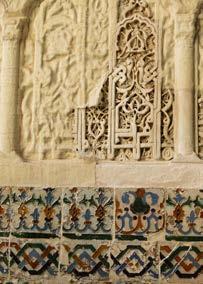

This palace-stronghold, a small "state within a state", is on the list of Spain's most important landmarks. It was built by the Moors during the period of Arab rule and expanded and rebuilt in later periods. Seville was taken by the Spanish in the middle of the 13th century; the palace was a residence of the Castillian kings for a long time thereafter, and later the residence of the Spanish Royal Family, which was the richest among the European dynasties at that time thanks to the discovery of America and the gold there. The palace was later expanded and made more and more beautiful.

The second palace in Alcazar, according to its age, is the Gothic palace Palacio Gotico and the Patio de la Monteria yard (14th century). This was a residence during the Pedro I period. It is also called the Moorish palace, as the original palace style is fully preserved. The façade is decorated with or-
Going through the “Lion's Gate”, built by the first Spanish owner, you will find yourself in an inner yard (Patio del Leon), bordered by Moorish walls and filled with ravishing plants. This yard was used as a place for receiving complainants during the Moorish era. It is decorated with beautiful lace-like ornamentations.
namentation while the inner part hosts the Alcoba Real (Royal Bedrooms), Salon de Embajadores (Ambassador Hall) and many other salons. The palace is embellished with two interior yards: the Patio de las Doncellas (with artificial reservoir and plants) and the Patio de las Munecas.
Cuarto del Almirante and Casa de Contratacion is an ensemble consisting of an admiralty and chamber of commerce. It was built by Isabel of Castile in the 16th century after the conquest of America to control trade and navigation.
Open every day: October-March - 9.30 - 17.00; April - September - 9.30 - 19.00
Closed January 1-6, during the Passion Week and December 25th.
Ticket price is 9.50 € but entry is free on Mondays from April to September from 18.00-19.00, and from March to October from 16.00-17.00. Apart from the regular tour, you can take a night tour at 21.00 (13 €).
Sevilla, Patio de Banderas, Real Alcazar www.alcazarsevilla.org
117 VOYAGER 7/2017
SEVILLE
CATEDRAL DE SANTA MARIA DE LA SEDE DE SEVILLA
The Gothic cathedral of Saint Maria in Seville is one of the largest cathedrals of this style in Europe. The Christian kings expelled the Arabs from the city in 1248. Gradually, Seville became an important political and economic center of Andalusia.
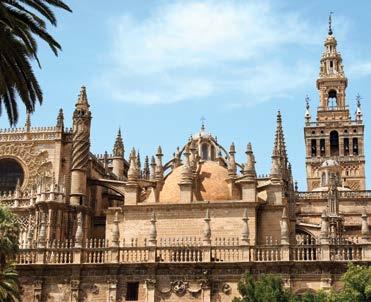
Hence, it needed a richly decorated cathedral corresponding to Seville's status. It was decided to build the cathedral on the site of the former mosque which was severely damaged after the 1356 earthquake. The construction of the temple began in 1402 and ended in 1506.
The enormous interior of the cathedral is decorated with gold, brought to Spain by Columbus from the new continent.
The altarpiece of the main chapel is 18.2 meters long and reaches 27.8 meters in height and is the largest altar in Spain. It was designed and built by the Flemish sculptor Pierre Dancart and is considered to be the most beautiful altar in all of Spain.

Its construction was so meticulous and laborious that it must come as no surprise that it lasted for a 100 years. It was built using Greek walnut, chestnut and larch trees as materials. The ornamented composition consists of three stories topped by a great baldachin. As well as its precious altar, Seville's cathedral also contains three tons of pure gold.
There is a 45-figure composition inside the beautiful architectural framework. Each of them occupies one square meter. In the center are
scenes from the life of the Virgin Mary and Jesus Christ, and in the adjacent sections, episodes from Genesis and Eden. The wood-carved stories are separated with pilasters decorated with mall wooden statues.

The statues are the result of delicate and laborious work. In order to achieve the harmonious perspective, the figures in the upper part of the composition are larger in size. As a result, a panorama effect is achieved where all the figures are of equal size when viewing from below.
Admission price: 8 €
Open: Mondays – 11.00-15.30, Tuesday - Saturday – 11.00-17.00, Sundays – 14.30-18.00
GIRALDA
A symbol of Seville, the famous Giralda is the cathedral’s unique bell tower, which was a minaret of a grand mosque built in the 12th century. The mosque itself is gone without a trace but the Giralda remains intact. Over time, it has been remade into a bell tower.
The interior of Seville Cathedral is illuminated with colored rays owing to its 75 stained-glass windows. These windows are considered to be the best in Europe. They were created by the great master Christophe Aleman in the 16th century.

There is a sarcophagus in the cathedral, thought to contain the remains of Christopher Columbus. The sarcophagus is decorated with allegorical figures of the four kings, each symbolically representing one of the Christian kingdoms of old Spain. There is an interesting story as to why these figures hold the coffin up in the air. At the end of his life, the explorer had bad relations with the royal court, so in his will he indicated that he was not to be buried in Spanish soil. Seville's authorities have honored Columbus’ will and hang the coffin "in the air".
It is believed that the remains of Columbus are buried here - in 1544 they were given to the Cathedral of Santo Domingo, the capital of the Dominican Republic; in 1795 they appeared in Havana; and they were returned to Seville in 1895. Presently there is another version that it is not the great explorer who is buried in the Cathedral of Saint Mary but his son Diego.
118 VOYAGER 7/2017
HOTEL ALFONSO XIII

A three-story building, built in 1928 near the Puerta de Jerez medieval gates, hosts this magnificent hotel. Hotel Alfonso XIII, which has 151 rooms, is frequently visited by the stars, including Brad Pitt and Tom Cruise. Some rooms, decorated in white, gray and brown tones, overlook the city or a patio; from other rooms, with pastel or black walls, one can view a tropical garden, laid out in the hotel’s interior yard. There is also a big pool here.
Room price: 229 €
San Fernando 2
HOTEL CASA 1800
Today in a house built for Seville’s nobility in 1864, there are 33 rooms distinguished by their outstanding décor. Old wooden logs line the room ceilings and the bed linen is made from Egyptian cotton. The hotel is located in downtown Seville; the cathedral and the Museum of Contemporary Art are nearby. Room price: 165 €
Rodrigo Caro 6
GRAN MELIA COLON
This hotel’s building is distinguished by its design, having been constructed in 1929 in the Neoborocco style. So-called Minimalism is prevailing inside with a black-white-grey palette in 186 rooms. The furniture and interior items were created by the famous designers Philippe Starck and Marcel Wanders. The walls between the bathrooms and the bedrooms are made of transparent glass; a beautiful panorama can be seen from the spa on the top floor. Room price: 178 € Canalejas 1
EL PINTÓN
The latest "reincarnation" of the textile warehouse built in 1790 is El Pintón – a tapas and cocktail bar. Thanks to a Madrid designer, the new aesthetics made the original charm even more vibrant. The light interior yard is at the center of the building. It is blended well with the yellow, blue and green metal or wooden furniture, and the floor is decorated with traditional Sevillian tiles. The dishes masterfully combine Mediterranean traditions with the light notes of Asian cuisine. Enjoy delicious ham and mustard croquets, fried udon with pork, and finally Dulce de Leche.


Calle Francos 42; www.elpinton.com
PERRO VIEJO
This place is an excellent example of how the culinary stage of Seville has changed. In what seems a simple menu at first glance, you will find special and high-quality dishes. They make the delicacy Patatas Bravas – the best potatoes in Seville.

The rice prepared on iron pans looks very appetizing and has a wonderful taste. All guests have the lagrimitas de presa Iberica (pork meat balls) with a glass of wine.
A dessert iced with a traditional cinnamon and sugar mixture will be the best ending to your dinner.
Calle Arguijo 3
OCHOA
This confectionary is over 100 years old and has become one of the city’s symbols.
Ochoa has preserved the recipes of many of its sweets since it opened in 1910.
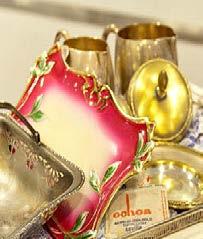
The most delicious candies, ice cream, doughnuts and small cakes and savory sweets are sold in its slightly old fashioned but legendary white-blue packaging.
Calle Sierpes 45
www.ochoacatering.com
EL RINCONCILLO
This oldest tapas bar is Seville has been here since 1670. On the upper floor, there are comfortable dining tables but, enchanted by the charm of the old bar downstairs, you may choose to stand down there. Make sure to order pescado frito mixto (mixed fried fish) or jamon Serrano Ibérico (Iberian ham).
Calle Alhondiga 40 www.elrinconcillo.es

119 VOYAGER 7/2017
SEVILLE
In the X-XI centuries, Cordoba was the center of the only Islamic caliphate in Europe and a major city where three religions coexisted in peace- Islam, Judaism and Christianity. The prosperous land of Al-Andalus attracted philosophers, astronomers, doctors and musicians from all over the world. When the caliphate fell, Cordoba was still ruled by Muslims for a long time. Only in 1236 was Ferdinand III able to conquer the city.
CORDOBA
MEZQUITA CATHEDRAL
The building of the mosque/the Cathedral of Our Lady of the Assumption (785-985) is the most recognizable attraction in Cordoba. Since the medieval period, it has been regarded as the second largest Muslim shrine in the world after the
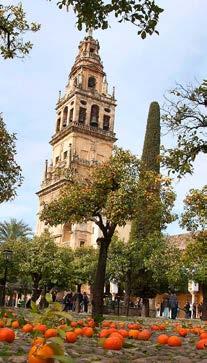

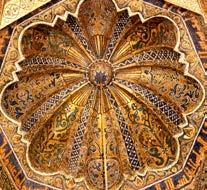

Kaaba in Mecca. The Christians who conquered Cordoba were so enchanted by the beauty and harmony of the building that no one could think to destroy it but they added a Christian temple to the complex and the building turned into the Cathedral of Our Lady of Assumption of Cordoba.
Mezquita of Cordoba is first on the list of unique buildings of Muslin architecture. It is considered to be one of the most important buildings in Andalusia and Spain as a whole, and is featured among the country’s top 12 architectural wonders.
In olden times, there was a Roman temple on the site, which was later turned into a Visigoth church. The mosque was built in 785 but was modified many times. This building achieved greatness in the Cordoba Caliphate period. Its interior decoration is stunning. A hall of a thousand columns, built in typical Arabic style, captures one’s imagination through a mosaic formed by the sunlight spread through the windows.
UNESCO has declared Cordoba a world heritage site. You should visit this city when travelling to Andalusia.
After visiting the cathedral, you can rest in the beautiful orange garden and enjoy the wonderful aroma.

120 VOYAGER 7/2017
The Cordobans lovingly call this cathedral, which unconditionally dominates the architectural and historical fabric of the city, MEZQUITA. There is nothing diminishing in this name. This rather is an expression of gentle love, because it is impossible to diminish the greatness of Cordoba’s Mosque / Cathedral. Life is never the same after seeing the Cordoba Mezquita. The scent of the orange blossoms in the yard will follow anyone who has even the smallest ability to perceive beauty.
The endlessly repeated arched space seems to be its own reflection in the mirror. Each ruler has added his own area to this grandiose shrine, where 40,000 believers can come together. The mosque/cathedral grew and grew until it itself became a city.
It is not clear how a space where so many architectural styles have been interwoven can be so harmonious – light Moresque walls of alabaster filigree and a red wooden altar set with all grandeur of Catholic Spain; the tranquility of capellas lining the walls; and the endless marble columns.
The temple of Cordoba is the essence of Andalusia; its quintessence, mixing with the floral scent of flourishing glycine. Its perfection and self-sufficiency can be felt is the trait of the great architecture. The ability to merge uncompromisingly different things; the justification of human existence despite the common passions of men. The apotheosis of talent and hard work. The reason why humanity still exists.
ALCÁZAR DE LOS REYES CRISTIANOS
This unique historical monument of Christian culture is the former castle of the Moors. This celebrated palace was the home of the Christian monarchs, and then the site of the Inquisition (1428-1821). It was here that Queen Elizabeth of Castile hosted Columbus when he presented the plans for his future voyage to the Monarch. Roman mosaics, small lakes, fountains, orange groves and tastefully planted gardens indicate the grandeur the city had a millennia ago.
Admission price: 4 €
PUENTE ROMANO
The banks of the Guadalquivir River in Cordoba are connected through a 16-arch bridge constructed in honor of Cesar’s conquest of Pompeii and later rebuilt by the Moors (in 719).
Located at the southern end of the bridge is a Torre de la Calahorra tower (currently housing a museum of modern technologies), with beautiful views of the city's right bank and ruins of Moorish water mills.
MEDINA AZAHARA
In old Cordoba, you will find the remains of the Medina Azahara palace complex – an old Arab monument (936-945), which is most impressive in its Moorish architecture and planning. It was built by the Caliph of the Umayyad dynasty for his beloved servant. The architecture of the building reflects the strength of the rulers, although the residence did not serve them for a long time (about 70 years). After the fall of the Berbers, the city-palace was demolished. Archeological excavations continue to this day; the treasures of Cordoba are yet to be exhausted.
There are many Christian churches in Cordoba, the most beautiful among them being San Nicolás de la Villa (1236), San Miguel (XIII cc), San André San Solo basil (590), San Loreto (XI-XVII cc), San Agustin (XIII c.), Santa Marina de Aguas Santas and Convento de la Merced monastery (XIIIXVIII cc). Looking at the dates, you can guess that most of these buildings were built by reconstructing earlier Moorish structures.



The famous crucifix stands on Cristo de los Faroles – a square closed from all sides.

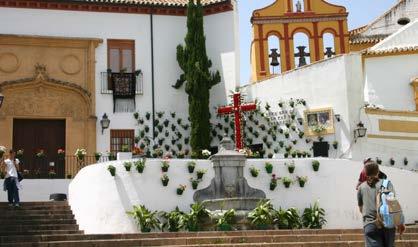
121 VOYAGER 7/2017 CORDOBA
NOOR
This unique restaurant is located away from the historic center of Cordoba. It will pleasantly surprise you with its interior decoration. The design of the restaurant is inspired by the Andalusian Moorish heritage, and the kitchen combines modern culinary methods with the tastes, aromas and refinement of traditional dishes.
Dinner price: Menu - 70/130€


Pablo Ruiz Picasso 6; www.noorrestaurant.es
RECOMIENDO
This restaurant will surely surprise its guests with dishes it offers. ReComiendo presents modern cuisine inspired by regional culinary traditions, focusing on the aromas and visuals of dishes. It’s worth trying the local tasting menu.
Dinner price: Menu - 34/45€.
The Old Quarter of Cordoba is a Mecca of pottery and papier-mache workshops and guitar and leather specialists. Here you will find silver Arab goods, leather products, ceramic shops, textiles and jewelry boutiques and the works of master sculptors.
LEATHER GOODS
Leather is the main material used in creating the celebrated "Cordovans" and "Guadameci", whereby its surface is ornamentally carved, modified and decorated with modern or classical designs. Today, the handicraft is maintained by a few family workshops.

GOLD AND SILVER PRODUCTS
Gold and silver products are one of the main driving forces in the city’s economy. The most celebrated technique for these goods is the Cordovan Filigree. In this method, they solder golden or silver threads together to create a piece of work with the structure of metal and give it a desired shape.

THE JEWELRY
There are jewelry workshops in Cordoba that showcase in their store windows all kinds of jewelry from classic styles to avantgarde. Cordoba is one of the main centers of gold and silver jewelry and the locally created designs are known around the world.
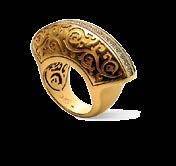
CHOCO
The new design of this restaurant is simultaneously modest and elegant. The chef’s menu focuses on local tastes and aromas though the local culinary is open to exotic influences as well.
Choco is located away for the city center but is worth a trip.
You can try innovative dishes by Kisko García in intimate and light surroundings.

Dinner price: 75-87 € Compositor Serrano Lucena 14; www.restaurantechoco.es
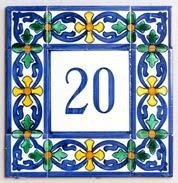
TELLUS
This modern restaurant derived its name from Roman mythology – Tellus, the goddess of earth. You can try traditional dishes here made with local ingredients.
Calle María la Judía, esq. Conchita Cintrón; www.tellus.es
MACSURA GASTROTABERNA
Here you can try traditional Andalusian cuisine with nuances of modern Basque gastronomy. Try the best quality fish and seafood dishes as well as tasty soups and salads. Make sure to order dessert.
Calle Cardenal Gonzalez
"AL ANDALUS" HAMMAM
The largest surviving Arab baths on the territory of Europe are an example of typical Caliphate architecture, which marked the period of prosperity in Al-Andalus. The hammam is located in the historic center of Cordoba and maintains the spirit of Arab thermal baths. There are three main halls here: warm (36ºC), hot (40ºC) and cold (18ºC).
In addition, there is a steam bath; you can relax while enjoying an Arab drink - a delicious mixture of green tea and peppermint. Entry to the baths with a traditional massage and the inimitable, relaxing hammam-style massage with foam will cost you 62 €.

C/
Corregidor
Luis de la Cerda 51
122 VOYAGER 7/2017
Alcalá Zamora 5 www.recomiendopower.com
BEAUTIFUL PATIOS
Cordoba’s excellent interior yards are definitely part of the historical heritage. Back in the time of the Roman Empire, and later during the Muslim reign, the
inhabitants of the city decorated their patios with fountains to create cool oases amidst the dryness and heat of Cordoba. The vibrant green surroundings were created with plants in pots and larnas.

Today there are two types of such yards - the ones inside houses owned by one family, surrounded by rows of arches, and the inner courtyards of multiapartment houses, with their typical balconies and staircases. As a rule, the floor of a patio is set with stones or brightly colored mosaics.
The classical district of old Cordoba - Alcazar Viejo - is decorated with unique patios in the area between the church of San Basilio and Alcazar. These interior yards can also be seen in the Santa Marina District and the Mezquita-Catedral area.

SIESTA
The term "Siesta" was coined by the monks of San Benito monastery in 11th century Spain. The word is derived from the Latin “ora sexsta”, which means the sixth hour. They were to rest on the sixth hour after sunrise to prepare for evening prayers. Soon, the idea of sleeping in the afternoon was picked up by other monasteries and wider society. In reality, siestas became necessary due to Spain’s climate. It was impossible to work under the hot midday sun. On the other hand, peasants and workers, having been well-rested at midday, then worked until 8 - 9 PM in the evening. Hence, the myth about Spaniards’ laziness and dislike of hard work is far from true.
HOSPES PALACIO DEL BAILÍO
This five-star hotel is located in the historic center of the city, which is distinguished by its magnitude, stone decorations and fretwork. There are four unique Andalusian patios where flowers, fruits and fragrant plants grow. The central ones are 160 sq. m. It has a glass floor through which one can see the remains of a Roman village dating back to the 1st century BC.
The hotel is unique due to its thermal baths (Spa Bodyna) and open pool set in the oasis of fruits and aromatic plants. The rooms of this boutique hotel are decorated with eighteenth-century frescoes, which is one of the most impressive features of the palace. The culinary zone is represented by Arbequina Restaurante & Tapas Bar, where you can try delicious Andalusian cuisine and refined drinks.
Room price: from 220 €
Ramírez de las Casas Deza 10-12
It is also not correct to compare the Spanish work ethic to the German model. In Germany and other successful northern countries, the sun is already starting to set at 5 PM. Those people work from early in the day and, having done their duty, head home at 4-5 in the afternoon. The 2-3-hour break in Spanish establishments traditionally implied going home but it was to eat and spend time with family rather than sleep. Today a large portion of Spanish establishments have switched to the European schedule. According to a survey conducted last year, only 16.2% of the population managed to nap in the afternoon every day; 22% did so very rarely; 3.2% did so at the end of the week; and 58.6% never napped.
The most "sleepyhead" regions are Andalusia, Murcia and Aragon; the most "awake" are the Basque Country and Galicia. In Spain's large and small tourist towns, where everything is tailored to tourists’ needs, almost all of the shops work during the siesta apart from the small private stores that plan their schedule on their own.
123 VOYAGER 7/2017
CORDOBA
VALENCIA
With 300 sunny days a year and an average temperature of 190C, Valencia, located on the Mediterranean coast, is a travel destination for any season. This charming city has an impressive historic heritage, comfortable beaches and a river that became a garden. Everything is possible in Valencia – you can have fun at a tennis competition or Formula 1, attend the international opera music festival and enjoy the local cuisine.
CARMEN'S QUARTERS AND PALACES
The millennial quarter sprang up between the Muslim and Christian walls. Walking through the streets shaded by pale medieval buildings is like traveling back to a past era.
MUSEUMS
There are 34 different museums to introduce you to Valencia's wealth of history, art and architecture.




You can feel the atmosphere of the XVIII century at the National Ceramic Museum, Marquis de Dos Agus Palace, where the Baroque-style interiors are fascinating. Enjoy the paintings of Goya, Sorrol and Sulogaya at the San Pio V Museum of Fine Art. Look for contemporary art in the IVAM and MUVIM museums.
PLAZA DE LA VIRGEN
Some 21 centuries of history are preserved in the city center. Cultural treasures include the cathedral, the El Miguelete bell tower, the Basilica of the Virgin and the Almoina archaeological museum. Visitors should attend the Tribunal de las Aguas (water tribunal), which is held in the plaza on Wednesdays at 12 o'clock.
It is recognized by UNESCO as an intangible legacy of humanity.
CATEDRAL

Built in 1238, the cathedral is among the city’s most important attractions. Elements of the Renaissance and classicism are combined in the glorious architecture of this magnificent structure. The locals believe that the church contains the Holy Grail from which Jesus drank the wine that was shared during the Last Supper. According to legend, St. Peter brought the grail to Rome, from whence it came to Eeskus and then in 1437 appeared in Valencia.
Open: Monday-Saturday - 10.00-18.30, Sunday - 14.0018.30; Price: €8
De l’Almoina www.catedraldevalencia.es
Valencian culture is a mix of Roman, Visigoth, Muslim and medieval traditions.
LONJA DE LA SEDA
This market (the Silk Exchange) is one of the oldest markets in Europe. Constructed in a beautiful modernist building, the Silk Exchange is a must-see for its European Gothic style, and it is a UNESCO world heritage site.
124 VOYAGER 7/2017
AVANT-GARDE SYMBOLS
This city is dotted with magnificent 21st century buildings. Santiago Calatrava designed the City of Arts and Science complex and Norman Foster the Congress Palace. David Chipperfield's avant-garde building "Sails and Winds" is a symbol of Valencia’s architectural prowess.

CITY OF ARTS AND SCIENCE
Santiago Calatrava’s futuristic design here unites several huge buildings: an IMAX theater, Europe's largest aquarium Oceanographic, Prince Felipe Science Museum, the avant-garde Reina Sofia opera house, the L´Assut de l´Or bridge and the Agora venue, which hosts the open tennis championship.

This innovative zoological park stretched over 100,000 square meters features animals living in naturally occurring conditions. In this unique place, there is such biodiversity that you can travel to Africa as well as get familiar with equatorial flora and Madagascar fauna and find yourself in other habitats.

ROYAL YACHT PORT AND VALENCIA BEACHES

The port was built in the 19th century; there is also an old cloakroom and a famous beautiful building called "Sails and Winds".
The symbol of modern marines.
El Cabanal and La Malvarrosa beaches are nearby, as well as other stunning coastal locations.
LAS ARENAS BALNEARIO RESORT
This hotel, built on Malvaros beach 100 years ago for Spanish aristocrats, offers the best services, including spas and pools.

Rooms starting at €162
Calle Eugenia Viñes 22-24
OCEANOGRAPHIC
This is Europe's largest aquarium, with over 500,000 species of marine life represented. It focuses on the world’s main marine ecosystems: the Mediterranean, mild and tropical seas, oceans, the Antarctic, the Arctic, underwater worlds and islands.
CAPPUCCINO GRAND CAFÉ
This café offers the best coffee not only in Valencia but in Spain. Breakfast is also perfect, and dinner is delicious.

Try the exotic fruit smoothies and fresh juices.
Plaça de la Reina
125 VOYAGER 7/2017
VALENCIA
IBIZA
The "White Island" became famous for its distinguished night clubs, although Ibiza has a beautiful coastline is as well.
Ibiza's most fashionable hotels are located on the Mediterranean coast. For a week of unbridled fun, I recommend you hurry to Playa d'en Bossa or San Antonio’s exciting and lively areas. Santa Eulalia is arelatively quiet place, with restaurants and wonderful shops.
If you want to get away from reality in a big dance hall accompanied by fireworks and techno music, then here are the nine best clubs to visit from May to October.
AMNESIA IBIZA
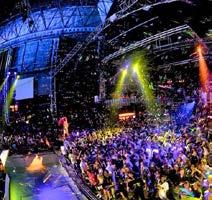
Amnesia Ibiza Club, which can hold 5,000 visitors, used to be the private estate of a wealthy Spanish family. Since the 1980s, it has been a favorite place for dance music artists. It is distinguished by its custommade sound system called the "Ice Cannons". The club has two rooms, an enclosed greenhouse and a terrace where guests can dance until dawn.
In DC-10, parties are held in an old, rebuilt estate located at the edge of the Ibiza airport runway. A terrace is set up in what used to be an airplane hangar, holding up to 1,500 visitors.
THE DESTINO CLUB of the Destino Pacha chain is an elite, comfortable entertainment area located on a cliff top offering wonderful views of the Mediterranean Sea.
HEART
Heart parties are planned to give guests a new cultural experience. Along with the temptations of the nightlife, this club offers you amazing food and "live" music. The club is run by chef brothers, Ferran and Alber Andria, and Cirque du Soleil founder Guy Laliberte.
PACHA IBIZA
This club was opened in the heart of Ibiza in 1973 and is still considered the best. Pacha Ibiza offers a VIP service that attracts all of the rich and famous, as well as those who want to spend time with celebrities.
There are a lot of bars in the port. Both the shoreline and the city are dazzling in the spring and fall. If you want to have a natural and relaxed vacation, go for a walk or ride a bike, this is the place for you.
Make sure to begin your tour of old Ibiza (Dalt Vila) from the top of the hill, then descend to the open-air cafés below to absorb the bohemian energy completely.

PRIVILEGE
Privilege is in the Guinness Book of Records as "The World's Largest Night Club". It includes a swimming pool, and an open-air dance area.
EDEN
Eden is equipped with the latest sound system that provides the best shows by the world’s most famous underground performers.
SPACE IBIZA
Space Ibiza has won the title of Best Night Club four times at the International Dance Music Awards. This mega club is one of the oldest and largest entertainment centers
in the city. Bizarre but terrific parties await you there.
USHUAIA
Ushuaia is located on the shore, in the open air, and is designed for parties. This club popularized daytime parties on the island. You can also enjoy Ushuaia's wonderful swimming pool when you visit.

126 VOYAGER 7/2017
Fiesta means holiday in Spanish. To foreigners who are not well-acquainted with the daily life of Spaniards, it seems that every day is a holiday in this country –one fiesta follows another and the calendar is full of day offs. That of course is untrue. The Spaniards are hard-working, though fiesta is a part of their soul, so when it comes to it, they temporarily put all problems (crises, unemployment, debts, etc.) aside and wholly venture into the magic atmosphere of celebrations.
During fiestas, bars, restaurants, souvenir stores and shops work almost 24-hour days. It is not advised to shop on these days as prices are increased significantly; if you find yourself in Spain during the passion week (Semana Santa), visit Andalusia - the most impressive religious marches are held here. Two weeks after Easter, the Seville Fair or the open market celebration begins. Everyone wears flamenco costumes and travels around the city on horseback. The favorite day of the year for Catalans is April 23 – Saint George’s Day, or San Jordi Day. Girls give books to boys as gifts, and boys bring girls flowers. If you go to the coast of Spain on June 24, you can take part in a bonfire in the evening. The fires are lit right on the beach.
October 12 is Spain’s national holiday and is associated with the discovery of America by Columbus. A military parade is held on this day in Madrid. Finally, if you decide to spend new year in Madrid, wrap up warm and go to Puerta del Sol; before the clock strikes 12, follow a Spanish tradition and eat 12 grapes, which you should buy in advance. This will make your midnight wish come true.
CASTELLERS, BARCELONA

The "Castellers", or human towers, can traditionally be seen in Catalonia during festivals. Groups of "Castellers" compete with each other to create the highest and most complex tower of human bodies. No festival in La Mercè happens without this spectacle. The best castellers take part in this festival. The "living towers" festival is the biggest celebration in Catalonia.
This wonderful holiday in the Mediterranean is dedicated to Barcelona's patron saint, the Virgin Mary (Mare de Déu de la Mercè), and offers different kinds of interesting attractions to tourists of all tastes.
LAS FALLAS, VALENCIA MARCH 15-19
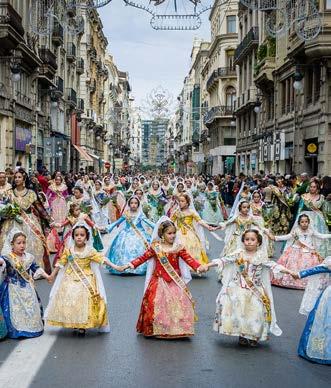
The oldest district in Valencia is considered to be the birthplace of the fire festival - Barrio del Carmen, once inhabited by wood-carving masters. Every spring the wood carvers brought their leftover materials and burned them in an open fire. The tradition took hold in medieval times and since then has been celebrated annually on March 15-19. Beautiful handmade puppets are burned instead of leftover wood today. Valencian dolls are real works of art. The festive march starts with firework display (mascleta). The next stage of the
CARNIVAL, SANTA CRUZ DE TENERIFE, FEBRUARY
The annual festival in Santa Cruz de Tenerife, the capital of the Canary Islands, is considered to be the second most popular celebration in the world after the Rio de Janeiro carnival.

The carnival week coincides with Catholic fasting days in Spain, though this celebration takes its roots in pagan times. Historically, the festival is 5,000 years old. In the antique period, it was held in honor of the god of wine, Dionysus. The queen of the carnival is selected based on her costume – the complexity of the decoration and level of presentation rather than her appearance.
Carnival is visited by millions of travelers from all over the world, so you should book your hotel and ticket a year in advance. If your main goal is to attend the carnival, you should stay in Santa Cruz de Tenerife. There are no beaches here but the temperature in February and March is + 15-200C.
celebration is the Flower Festival, when the city is immersed into beautiful flora. Valencian women wear beautiful national garments and jewels, and move towards the square where a 14-meter sculpture of the Holy Virgin, made of fragrant flowers, is raised as a floral sculpture of the patron saint. After that, a giant paella is prepared at the Valencia Stadium.
The culmination of "Las Fallas" is a fire festival called La Crema. A few days in advance, giant papier mache dolls are set up all around the city. These are caricatures or cartoon characters, which represent some unpleasant events or human sins.
127 VOYAGER 7/2017
FIESTA
COMFORT AND WESTERN QUALITY STANDARDS
• SCHINDLER GLASS ELEVATOR
• GREEN INTERNAL YARD
• FOOTB ALL PITCH
• APARTMENTS FROM 48 M²


• ECOLOGIC ALLY CLEAN ENVIRONMENT
• ALUMINUM DOOR AND WINDOWS
+995 595 612 020 წყნეთის გზატკეცილი N 15/17 www.vivadevelopment.ge MULTIFUNCTIONAL LIVING COMPLEX IN B AGEBI



+995 595 61 20 20 TSKNETI HIGHWAY N 15/17



































































































































































































































































 TEA GVASALIA
TEA GVASALIA










 THE " TBILISI GARDENS" COMPLEX WILL BE UNIQUE AT LEAST DUE TO THE VAST GARDEN SURROUNDING IT. BELIEVE ME, THIS IS THE THE GREATEST LUXURY IN THE WHOLE WORLD. "
THE " TBILISI GARDENS" COMPLEX WILL BE UNIQUE AT LEAST DUE TO THE VAST GARDEN SURROUNDING IT. BELIEVE ME, THIS IS THE THE GREATEST LUXURY IN THE WHOLE WORLD. "




















 Plaça Gala i Salvador Dalí, 5, 17600 Figueres, Girona, Spain
Plaça Gala i Salvador Dalí, 5, 17600 Figueres, Girona, Spain










































































































































































































































